Cameo Communications WLN2229 IEEE802.11n Wireless LAN Router User Manual WLN 2229 U i
Cameo Communications Inc IEEE802.11n Wireless LAN Router WLN 2229 U i
User Manual

i
IEEE802.11n Wireless Lan Router
WLN-2229
User’s Guide

i
Federal Communication Commission Interference Statement
This equipment has been tested and found to comply with the limits for a Class B digital device, pursuant to Part 15 of the FCC Rules.
These limits are designed to provide reasonable protection against harmful interference in a residential installation. This equipment
generates, uses and can radiate radio frequency energy and, if not installed and used in accordance with the instructions, may cause
harmful interference to radio communications. However, there is no guarantee that interference will not occur in a particular
installation. If this equipment does cause harmful interference to radio or television reception, which can be determined by turning
the equipment off and on, the user is encouraged to try to correct the interference by one of the following measures:
- Reorient or relocate the receiving antenna.
- Increase the separation between the equipment and receiver.
- Connect the equipment into an outlet on a circuit different from that to which the receiver is connected.
- Consult the dealer or an experienced radio/TV technician for help.
FCC Caution: Any changes or modifications not expressly approved by the party responsible for compliance could void the user's
authority to operate this equipment.
This device complies with Part 15 of the FCC Rules. Operation is subject to the following two conditions: (1) This device may not
cause harmful interference, and (2) this device must accept any interference received, including interference that may cause undesired
operation.
IMPORTANT NOTE:
FCC Radiation Exposure Statement:
This equipment complies with FCC radiation exposure limits set forth for an uncontrolled environment. This equipment should be
installed and operated with minimum distance 20cm between the radiator & your body.
This transmitter must not be co-located or operating in conjunction with any other antenna or transmitter.
The availability of some specific channels and/or operational frequency bands are country dependent and are firmware programmed at
the factory to match the intended destination. The firmware setting is not accessible by the end user.
For Taiwan 警語
警語警語
警語:
::
:
經型式認證合格之低功率射頻電機,非經許可,公司、商號或使用者均不得擅自變更頻率、加大功率或變更原設計之
特性及功能。
低功率射頻電機之使用不得影響飛航安全及干擾合法通信;經發現有干擾現象時,應立即停用,並改善至無干擾時方
得繼續使用。前項合法通信,指依電信法規定作業之無線電通信。低功率射頻電機須忍受合法通信或工業、科學及醫
療用電波輻射性電機設備之干擾。

ii
Europe – EU Declaration of Conformity
This device complies with the essential requirements of the R&TTE Directive 1999/5/EC. The following test methods have been
applied in order to prove presumption of conformity with the essential requirements of the R&TTE Directive 1999/5/EC:
EN 60950-1: 2006+A11: 2009+A1:2010+A12:2011
Safety of Information Technology Equipment
EN 50385: 2002
Product standard to demonstrate the compliance of radio base stations and fixed terminal stations for wireless telecommunication
systems with the basic restrictions or the reference levels related to human exposure to radio frequency electromagnetic fields
(110MHz - 40 GHz) - General public
EN 300 328 V1.7.1 (2006-10)
Electromagnetic compatibility and Radio spectrum Matters (ERM); Wideband transmission systems; Data transmission equipment
operating in the 2,4 GHz ISM band and using wide band modulation techniques; Harmonized EN covering essential requirements
under article 3.2 of the R&TTE Directive
EN 301 489-1 V1.8.1 (2008-04)
Electromagnetic compatibility and Radio Spectrum Matters (ERM); ElectroMagnetic Compatibility (EMC) standard for radio
equipment and services; Part 1: Common technical requirements
EN 301 489-17 V2.1.1 (2009-05)
Electromagnetic compatibility and Radio spectrum Matters (ERM); ElectroMagnetic Compatibility (EMC) standard for radio
equipment and services; Part 17: Specific conditions for 2,4 GHz wideband transmission systems and 5 GHz high performance RLAN
equipment
This device is a 2.4 GHz wideband transmission system (transceiver), intended for use in all EU member states and EFTA countries,
except in France and Italy where restrictive use applies.
In Italy the end-user should apply for a license at the national spectrum authorities in order to obtain authorization to use the device
for setting up outdoor radio links and/or for supplying public access to telecommunications and/or network services.
This device may not be used for setting up outdoor radio links in France and in some areas the RF output power may be limited to 10
mW EIRP in the frequency range of 2454 – 2483.5 MHz. For detailed information the end-user should contact the national spectrum
authority in France.

iii
Česky [Czech] [Jméno výrobce] tímto prohlašuje, že tento [typ zařízení] je ve shodě se základními požadavky a dalšími
příslušnými ustanoveními směrnice 1999/5/ES.
Dansk [Danish] Undertegnede [fabrikantens navn] erklærer herved, at følgende udstyr [udstyrets typebetegnelse] overholder de
væsentlige krav og øvrige relevante krav i direktiv 1999/5/EF.
Deutsch
[German]
Hiermit erklärt [Name des Herstellers], dass sich das Gerät [Gerätetyp] in Übereinstimmung mit den
grundlegenden Anforderungen und den übrigen einschlägigen Bestimmungen der Richtlinie 1999/5/EG
befindet.
Eesti [Estonian] Käesolevaga kinnitab [tootja nimi = name of manufacturer] seadme [seadme tüüp = type of equipment]
vastavust direktiivi 1999/5/EÜ põhinõuetele ja nimetatud direktiivist tulenevatele teistele asjakohastele sätetele.
English Hereby, [name of manufacturer], declares that this [type of equipment] is in compliance with the essential
requirements and other relevant provisions of Directive 1999/5/EC.
Español
[Spanish]
Por medio de la presente [nombre del fabricante] declara que el [clase de equipo] cumple con los requisitos
esenciales y cualesquiera otras disposiciones aplicables o exigibles de la Directiva 1999/5/CE.
Ελληνική [Greek]
ΜΕ ΤΗΝ ΠΑΡΟΥΣΑ [name of manufacturer] ∆ΗΛΩΝΕΙ ΟΤΙ [type of equipment] ΣΥΜΜΟΡΦΩΝΕΤΑΙ
ΠΡΟΣ ΤΙΣ ΟΥΣΙΩ∆ΕΙΣ ΑΠΑΙΤΗΣΕΙΣ ΚΑΙ ΤΙΣ ΛΟΙΠΕΣ ΣΧΕΤΙΚΕΣ ∆ΙΑΤΑΞΕΙΣ ΤΗΣ Ο∆ΗΓΙΑΣ
1999/5/ΕΚ.
Français [French]
Par la présente [nom du fabricant] déclare que l'appareil [type d'appareil] est conforme aux exigences
essentielles et aux autres dispositions pertinentes de la directive 1999/5/CE.
Italiano [Italian] Con la presente [nome del costruttore] dichiara che questo [tipo di apparecchio] è conforme ai requisiti
essenziali ed alle altre disposizioni pertinenti stabilite dalla direttiva 1999/5/CE.
Latviski [Latvian]
Ar šo [name of manufacturer / izgatavotāja nosaukums] deklarē, ka [type of equipment / iekārtas tips] atbilst
Direktīvas 1999/5/EK būtiskajām prasībām un citiem ar to saistītajiem noteikumiem.
Lietuvių
[Lithuanian]
Šiuo [manufacturer name] deklaruoja, kad šis [equipment type] atitinka esminius reikalavimus ir kitas
1999/5/EB Direktyvos nuostatas.
Nederlands
[Dutch]
Hierbij verklaart [naam van de fabrikant] dat het toestel [type van toestel] in overeenstemming is met de
essentiële eisen en de andere relevante bepalingen van richtlijn 1999/5/EG.
Malti [Maltese] Hawnhekk, [isem tal-manifattur], jiddikjara li dan [il-mudel tal-prodott] jikkonforma mal-ħtiġijiet essenzjali u
ma provvedimenti oħrajn relevanti li hemm fid-Dirrettiva 1999/5/EC.
Magyar
[Hungarian]
Alulírott, [gyártó neve] nyilatkozom, hogy a [... típus] megfelel a vonatkozó alapvetõ követelményeknek és az
1999/5/EC irányelv egyéb elõírásainak.
Polski [Polish] Niniejszym [nazwa producenta] oświadcza, że [nazwa wyrobu] jest zgodny z zasadniczymi wymogami oraz
pozostałymi stosownymi postanowieniami Dyrektywy 1999/5/EC.
Português
[Portuguese]
[Nome do fabricante] declara que este [tipo de equipamento] está conforme com os requisitos essenciais e
outras disposições da Directiva 1999/5/CE.
Slovensko
[Slovenian]
[Ime proizvajalca] izjavlja, da je ta [tip opreme] v skladu z bistvenimi zahtevami in ostalimi relevantnimi
določili direktive 1999/5/ES.
Slovensky
[Slovak]
[Meno výrobcu] týmto vyhlasuje, že [typ zariadenia] spĺňa základné požiadavky a všetky príslušné ustanovenia
Smernice 1999/5/ES.
Suomi [Finnish] [Valmistaja = manufacturer] vakuuttaa täten että [type of equipment = laitteen tyyppimerkintä] tyyppinen laite
on direktiivin 1999/5/EY oleellisten vaatimusten ja sitä koskevien direktiivin muiden ehtojen mukainen.
Svenska
[Swedish]
Härmed intygar [företag] att denna [utrustningstyp] står I överensstämmelse med de väsentliga egenskapskrav
och övriga relevanta bestämmelser som framgår av direktiv 1999/5/EG.

iv
TABLE OF CONTENT
A
BOUT
T
HIS
G
UIDE
.................................................................................... 1
Purpose.................................................................................................................................................................................................. 1
Terms/Usage ......................................................................................................................................................................................... 1
Overview of this User’s Guide .............................................................................................................................................................. 1
I
NTRODUCTION
........................................................................................... 2
Applications: ......................................................................................................................................................................................... 2
Supported Features: .............................................................................................................................................................................. 3
U
NPACKING AND
S
ETUP
............................................................................. 4
Unpacking ............................................................................................................................................................................................. 4
Setup ..................................................................................................................................................................................................... 4
H
ARDWARE
I
NSTALLATION
........................................................................ 5
Front Panel ............................................................................................................................................................................................ 5
Rear Panel ............................................................................................................................................................................................. 6
Side Panel ............................................................................................................................................................................................. 6
Hardware connections ........................................................................................................................................................................... 8
Connecting the WLAN Router ......................................................................................................................................................... 8
Check the installation ........................................................................................................................................................................ 8
PC
N
ETWORK
TCP/IP
S
ETTING
................................................................. 9
Windows 95/98/ME .............................................................................................................................................................................. 9
Windows 2000 .................................................................................................................................................................................... 10
Windows XP / Vista ............................................................................................................................................................................ 11
C
ONFIGURATION
...................................................................................... 12
Login to the WLAN Router through Wireless LAN ........................................................................................................................... 12
Login to the WLAN Router ................................................................................................................................................................ 12
Using the Web Browser ...................................................................................................................................................................... 12
Setup Wizard ....................................................................................................................................................................................... 13
WAN Setting ....................................................................................................................................................................................... 23
DHCP Client or Fixed IP ................................................................................................................................................................ 23
PPPoE with Obtain IP Automatically ............................................................................................................................................. 24
PPPoE with Specify IP .................................................................................................................................................................... 25
PPTP/L2TP with Obtain IP Automatically ..................................................................................................................................... 26
PPTP/L2TP with Specify IP ........................................................................................................................................................... 26
BigPond Cable ................................................................................................................................................................................ 27
Dynamic DNS: ................................................................................................................................................................................ 27
Wireless setting ................................................................................................................................................................................... 28
Basic................................................................................................................................................................................................ 28
Security ........................................................................................................................................................................................... 29
Advanced ........................................................................................................................................................................................ 32
Wi-Fi Protected Setup ..................................................................................................................................................................... 33
LAN Setting ........................................................................................................................................................................................ 34
Basic................................................................................................................................................................................................ 34
DHCP .............................................................................................................................................................................................. 35
Access Control Setting ........................................................................................................................................................................ 37
Filter ................................................................................................................................................................................................ 37

v
Virtual Server .................................................................................................................................................................................. 41
Special AP ....................................................................................................................................................................................... 42
DMZ................................................................................................................................................................................................ 44
Firewall settings .............................................................................................................................................................................. 45
System Setting .................................................................................................................................................................................... 46
Password ......................................................................................................................................................................................... 46
Time ................................................................................................................................................................................................ 47
Device Information ......................................................................................................................................................................... 48
Log .................................................................................................................................................................................................. 49
Log Setting ...................................................................................................................................................................................... 50
Statistic............................................................................................................................................................................................ 51
Restart ............................................................................................................................................................................................. 52
Firmware ......................................................................................................................................................................................... 53
Configuration .................................................................................................................................................................................. 54
UPnP ............................................................................................................................................................................................... 55
Ping Test ......................................................................................................................................................................................... 56
Remote Management ...................................................................................................................................................................... 57
T
ECHNICAL
S
PECIFICATIONS
................................................................... 58
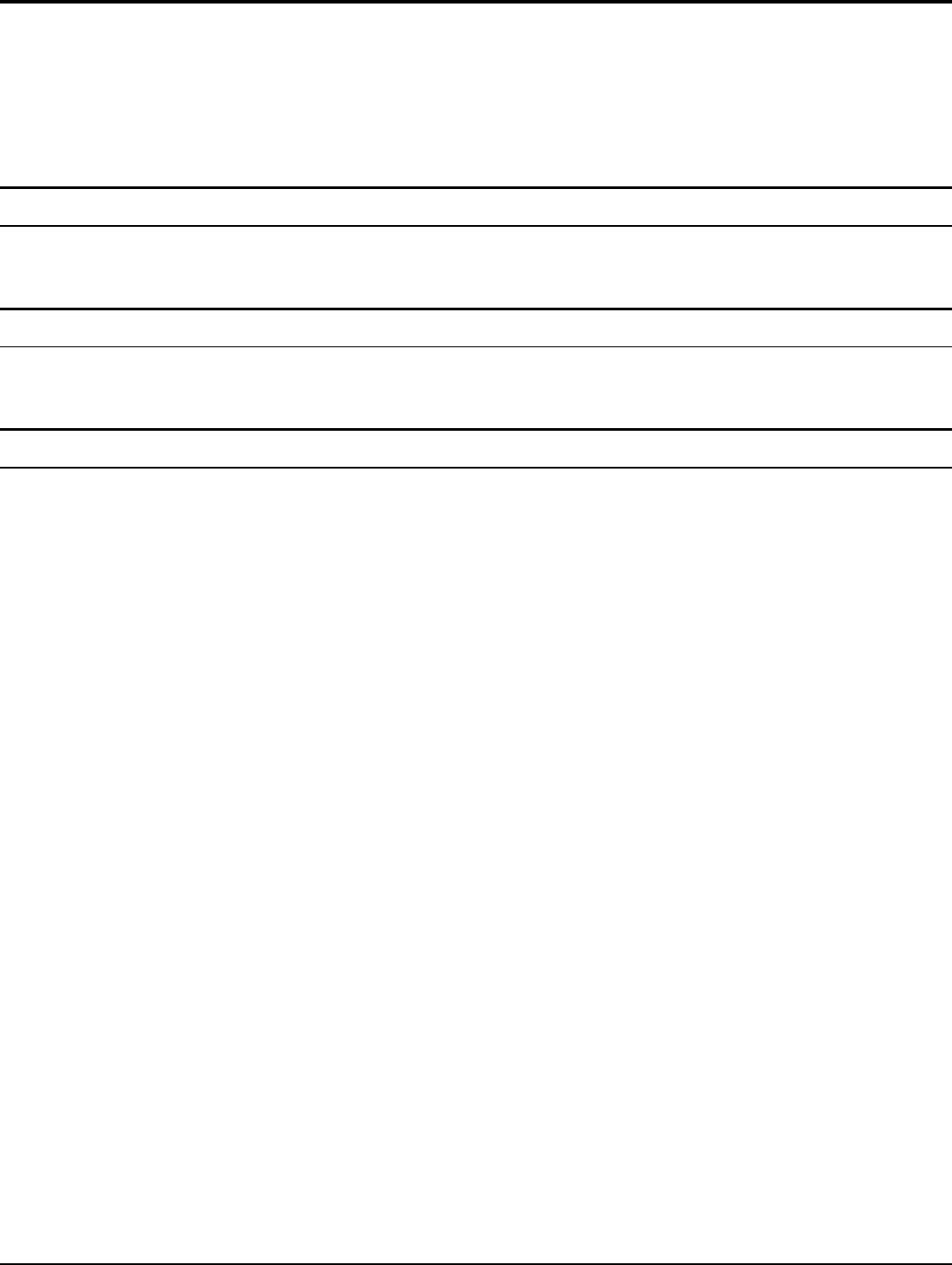
1
ABOUT THIS GUIDE
Congratulations on your purchase of this IEEE 802.11b/g/n Wireless Broadband
Router. This integrated access device combines Internet gateway functions with
wireless LAN and Fast Ethernet switch. It provides a complete solution for Internet
surfing and office resource sharing, and it is easy to configure and operate for every
user.
Purpose
This manual discusses how to install the IEEE 802.11b/g/n Wireless Broadband
Router.
Terms/Usage
In this guide, the term “the WLAN Router” refers to your IEEE 802.11b/g/n
Wireless Broadband Router.
Overview of this User’s Guide
Introduction. Describes the IEEE 802.11b/g/n Wireless Broadband Router and its
features.
Unpacking and Setup. Helps you get started with the basic installation of the IEEE
802.11b/g/n Wireless Broadband Router.
Identifying External Components. Describes the front panel, rear panel and LED
indicators of the IEEE 802.11b/g/n Wireless Broadband Router.
Connecting the WLAN Router. Tells how you can connect the IEEE 802.11b/g/n
Wireless Broadband Router to your xDSL/Cable Modem.
Technical Specifications. Lists the technical (general, physical and environmental,
performance and Routers settings) specifications of the IEEE 802.11b/g/n Wireless
Broadband Router.

2
INTRODUCTION
With the explosive growth of the Internet, accessing information and services at
any time, day or night has become a standard requirement for most people. The era
of the standalone PC is waning. Networking technology is moving out of the
exclusive domain of corporations and into homes with at least two computers.
This integrated access device combines Internet gateway functions with wireless
LAN and Fast Ethernet switch. Designed for the business and home, it saves you
the cost of installing a separate modem and ISP line for each computer, while
providing ready connection for the users, with or without the network wires.
Broadband network access is also gaining ground. However, allowing more than
two computers to access the Internet at the same time means less affordable, higher
costs. Thus, there is a need to share one public IP address over a single Internet
connection to link the home with the Internet.
The scarcity of IP addresses and using a shared Internet connection through an
Internet sharing device can solve high network access costs. All linked computers
can make full use of broadband capabilities over such a device.
This device not only comes equipped with a wide range of features, but also can be
installed and configured right out of the box. This device supports a simple local
area network and Internet access share, offering great cost savings.
The local area network connects home computers while also allowing any of the
computers to access the Internet, share resources, or play online games—the basis
of the family computing lifestyle.
Applications:
Broadband Internet access:
Several computers can share one high-speed broadband connection through
wireless or wired (WLAN, LAN and WAN-Internet).
Resource sharing:
Share resources such as printers, scanners and other peripherals.
File sharing:
Exchange data, messages, and distribute files thus making good use of hard disk
space.
Online gaming:
Through the local area network, online gaming and e-commerce services can be
easily setup.
Firewall:
A built-in firewall function — for security and anti-hacking systems.

3
Supported Features:
High speed data transfer rate
NAT for sharing 1 IP address to all LAN/WLAN users.
PPPoE and PPTP protocol for Dial-Up ADSL.
64/128 bit WEP Encryption
WPA-PSK, WPA2-PSK, WPA, WPA2 security
DHCP Server / Client.
UPnP (Universal Plug and Play).
WPS (Wi-Fi Protected Setup)
Virtual Server mapping.
MAC filtering.
Protocol/IP filtering
Domain/URL filtering
DDNS
Upgradeable firmware for future function.
Simple installation using Setup Wizard.
Easy configuration via Web Browser.

4
UNPACKING AND SETUP
This chapter provides unpacking and setup information for the IEEE 802.11b/g/n
Wireless Broadband Router.
Unpacking
Open the box of the WLAN Router and carefully unpack it. The box should contain
the following items:
One IEEE 802.11b/g/n Wireless Broadband Router
One CD contain User’s Guide
Two 2dBi gain dipole antenna
One external power adapter
If any item is found missing or damaged, please contact your local reseller for
replacement.
Setup
The setup of the WLAN Router can be performed properly using the following
methods:
The power outlet should be within 1.82 meters (6 feet) of the Broadband Router.
Visually inspect the DC power jack and make sure that it is fully secured to the
power adapter.
Make sure that there is proper heat dissipation and adequate ventilation around
the Broadband Router. Do not place heavy objects on the Broadband Router.
Fix the direction of the antennas. Try to place the Wireless Router in a position
that can best cover your wireless network. Normally, the higher you place the
antenna, the better the performance will be. The antenna’s position enhances the
receiving sensitivity.

5
HARDWARE INSTALLATION
Front Panel
POWER
This indicator lights green when the hub is receives power, otherwise it is off.
WAN (Link/ACT)
The indicators light green when the WAN port is connected to a xDSL/Cable
modem successfully.
The indicators blink green while the WAN port was transmitting or receiving data
from the xDSL/Cable modem.
WLAN (ACT)
This indicator lights green when there are wireless devices connected and
transmitting data to the WLAN Router.
LAN (Link/ACT)
These indicators light green when the LAN ports were connected successfully.
These indicators blinking green while the LAN ports were accessing data.
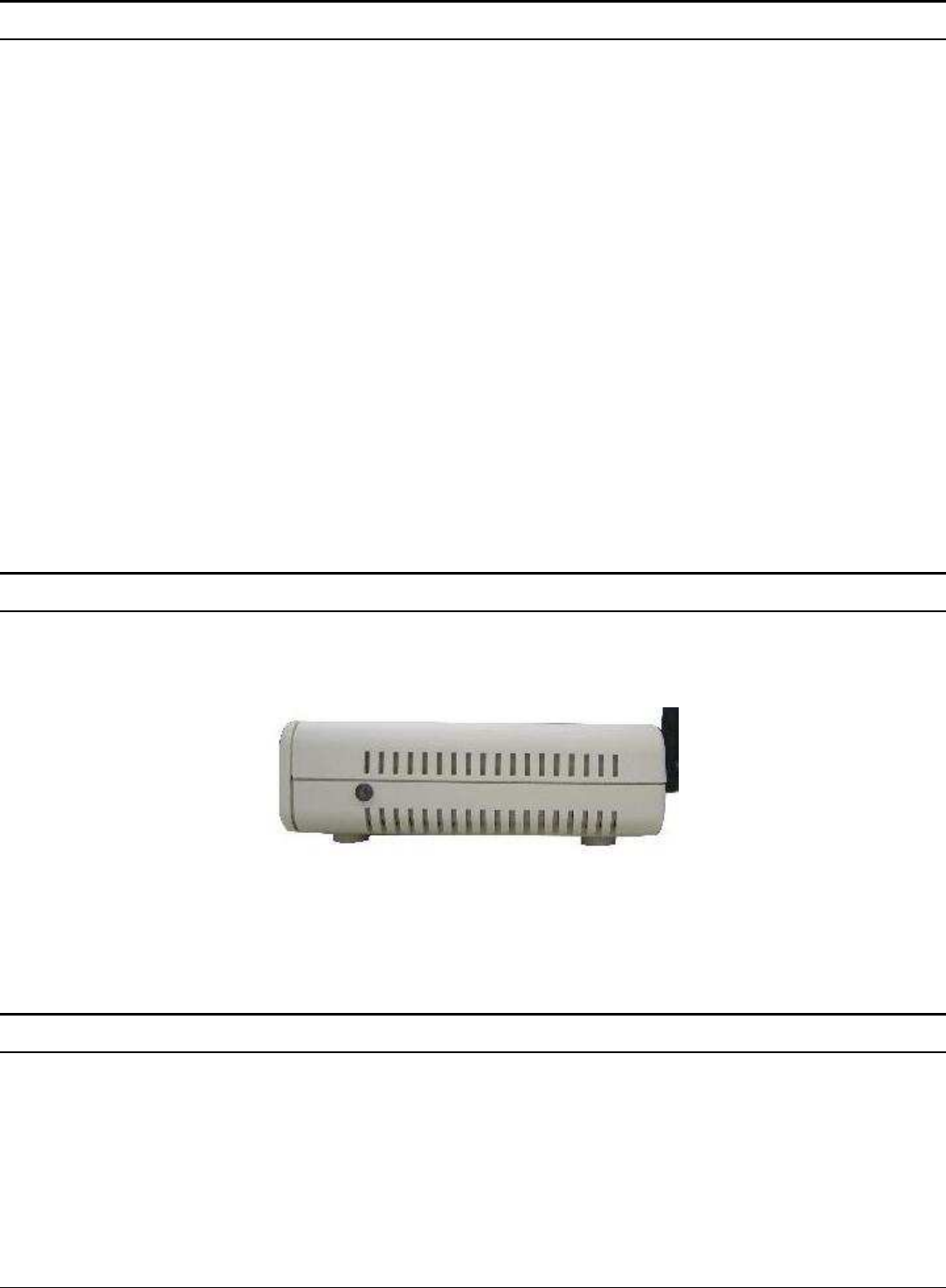
6
Rear Panel
Antenna
There is one 2dBi gain antennas on the rear panel for wireless connection.
LAN (1-4)
Four RJ-45 10/100Mbps Auto-MDIX ports for connecting to either 10Mbps or
100Mbps Ethernet connections.
WAN
In the four port broadband Router, there is an RJ-45 10/100Mbps Auto-MDIX port
for the WAN that connects to the xDSL/Cable modem for Internet connectivity.
POWER
Plug the power adapter to this power jack
RESET
Use a pin-shaped item to push to reset this device to factory default settings. It will
be a useful tool when the manager forgot the password to login, and needs to
restore the device back to default settings.
Side Panel
The figure below shows the side panel of the IEEE 802.11b/g/n Wireless
Broadband Router.
Side Panel
WPS
Push this button to execute the Wi-Fi Protected Setup process.
Horizontal putting (with rubber feet)
It is possible to set up on the desk etc. by installing the rubber feet in the
rubber
foot putting position of the bottom of the main body.
- The screw and the wall hanging (With the screw set for the wall hanging)
It is possible to set up on the wall by using the screw set for the wall hanging
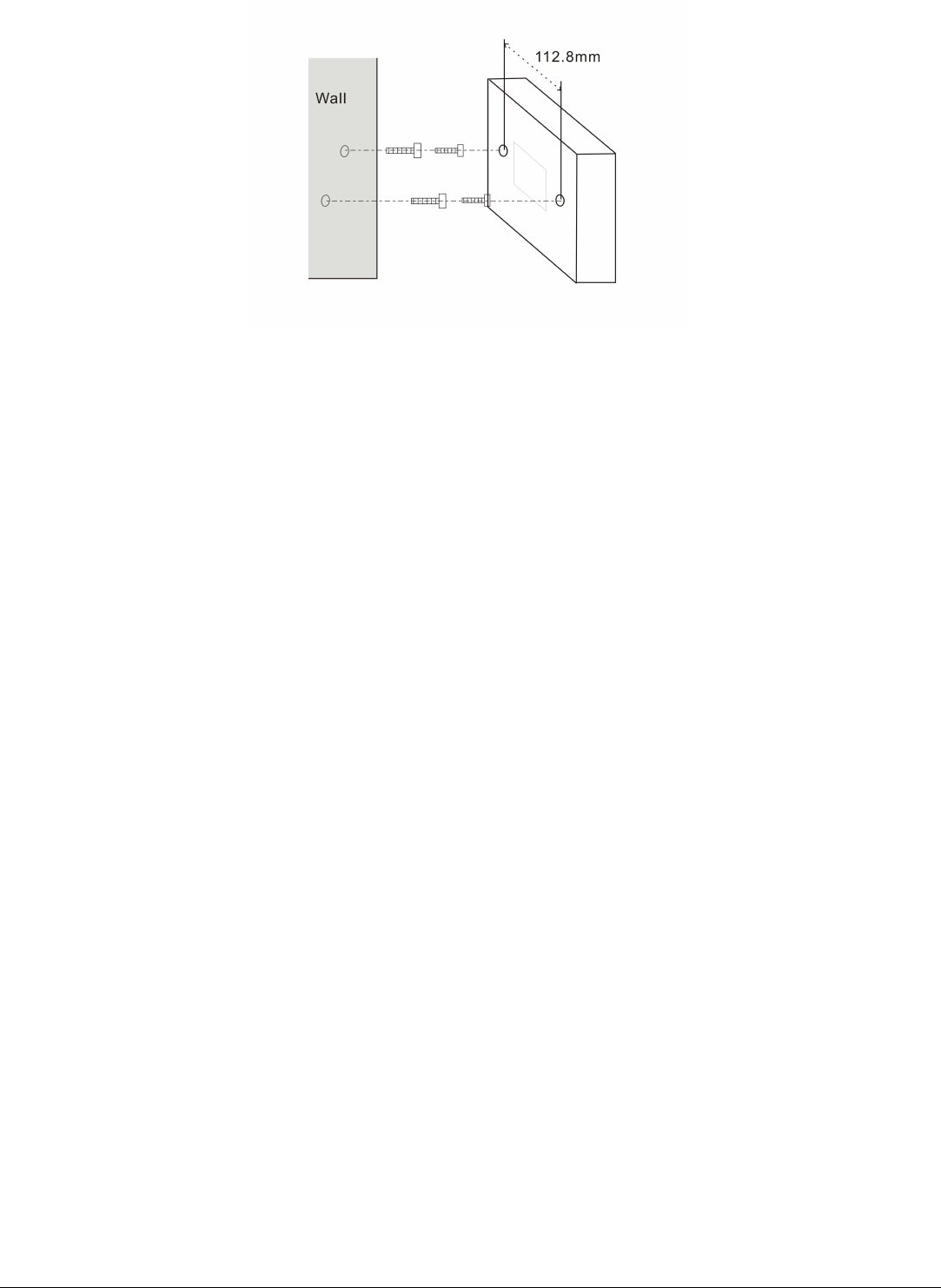
7
* When you set it up in the vertical such as walls, please set it up so that
network port may become bottom.
- The magnet and the wall hanging (With the magnet)
By using the magnet set, it is possible to be installed to furniture made of steel.
By using with rubber feet, magnetism becomes stronger.

8
HARDWARE CONNECTIONS
Connecting the WLAN Router
1. Plug in one end of the network cable to the WAN port of the WLAN Router.
2. Plug in the other end of the network cable to the Ethernet port of the xDSL or
Cable modem.
3. Use another network cable to connect to the Ethernet card on the computer
system; the other end of the cable connects to the LAN port of the WLAN
Router. Since the IEEE 802.11b/g/n Wireless Broadband Router has four ports,
you can connect up to four computers directly to the unit. Then you do not have
to buy a switch to connect these computers since one WLAN Router functions
both as a connection-sharing unit and as a switch.
Check the installation
The control LEDs of the WLAN Router are clearly visible and the status of the
network link can be seen instantly:
1. With the power source on, once the device is connected to the broadband modem,
the Power, System, LAN, WLAN and WAN port LEDs of the WLAN Router
will light up indicating a normal status.
2. When the WAN Port is connected to the ADSL/Cable modem, the WAN LED
will light up.
3. When the LAN Port is connected to the computer system, the LAN LED will
light up.
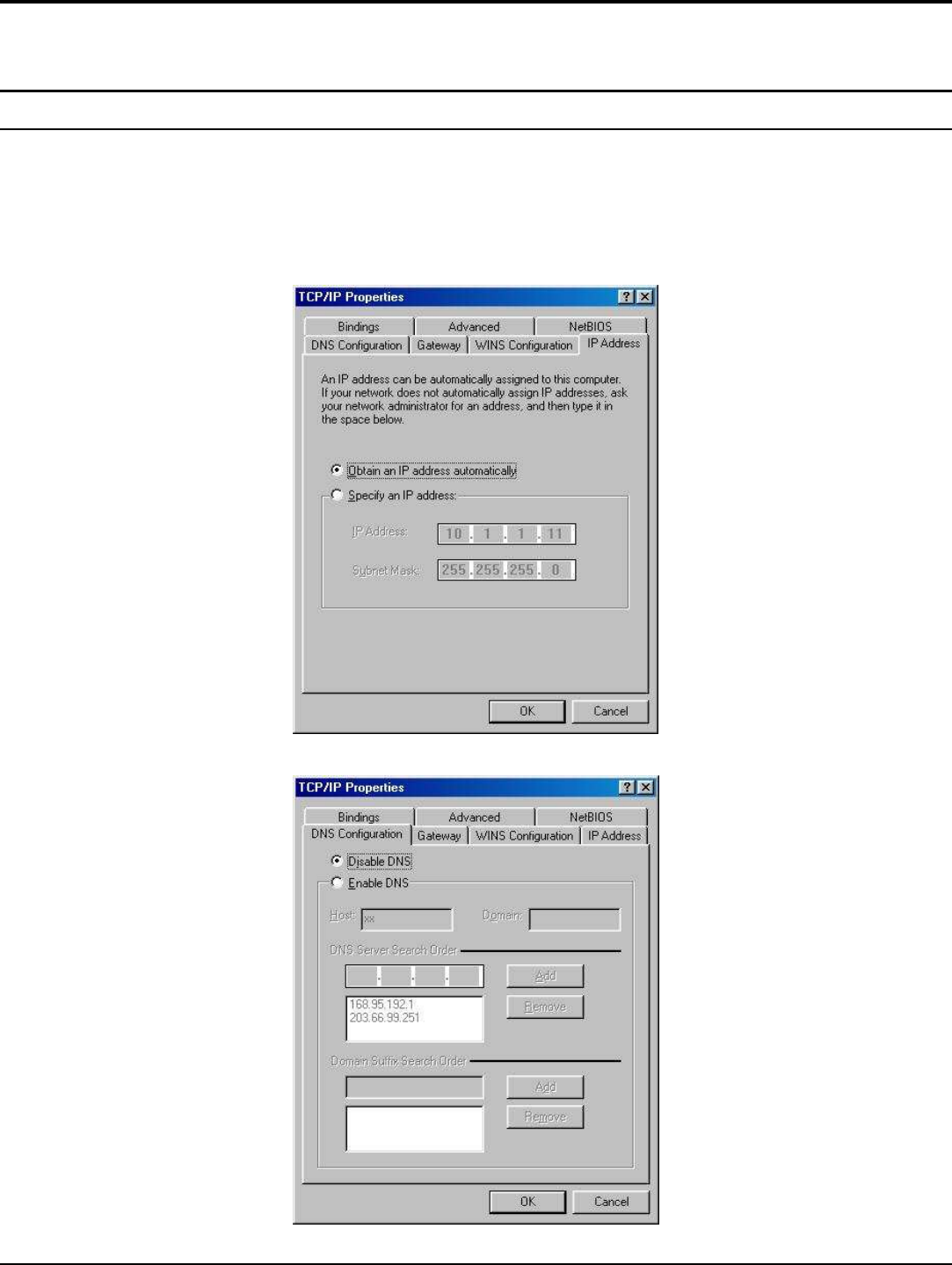
9
PC NETWORK TCP/IP SETTING
The network TCP/IP settings differ based on the computer’s operating system
(Win95/98/ME/NT/2000/XP) and are as follows.
Windows 95/98/ME
1. Click on the “Network neighborhood” icon found on the desktop.
2. Click the right mouse button and a context menu will be show.
3. Select “Properties” to enter the TCP/IP setting screen.
4. Select “Obtain an IP address automatically” on the “IP address” field.
5. Select “Disable DNS” in the “DNS” field.
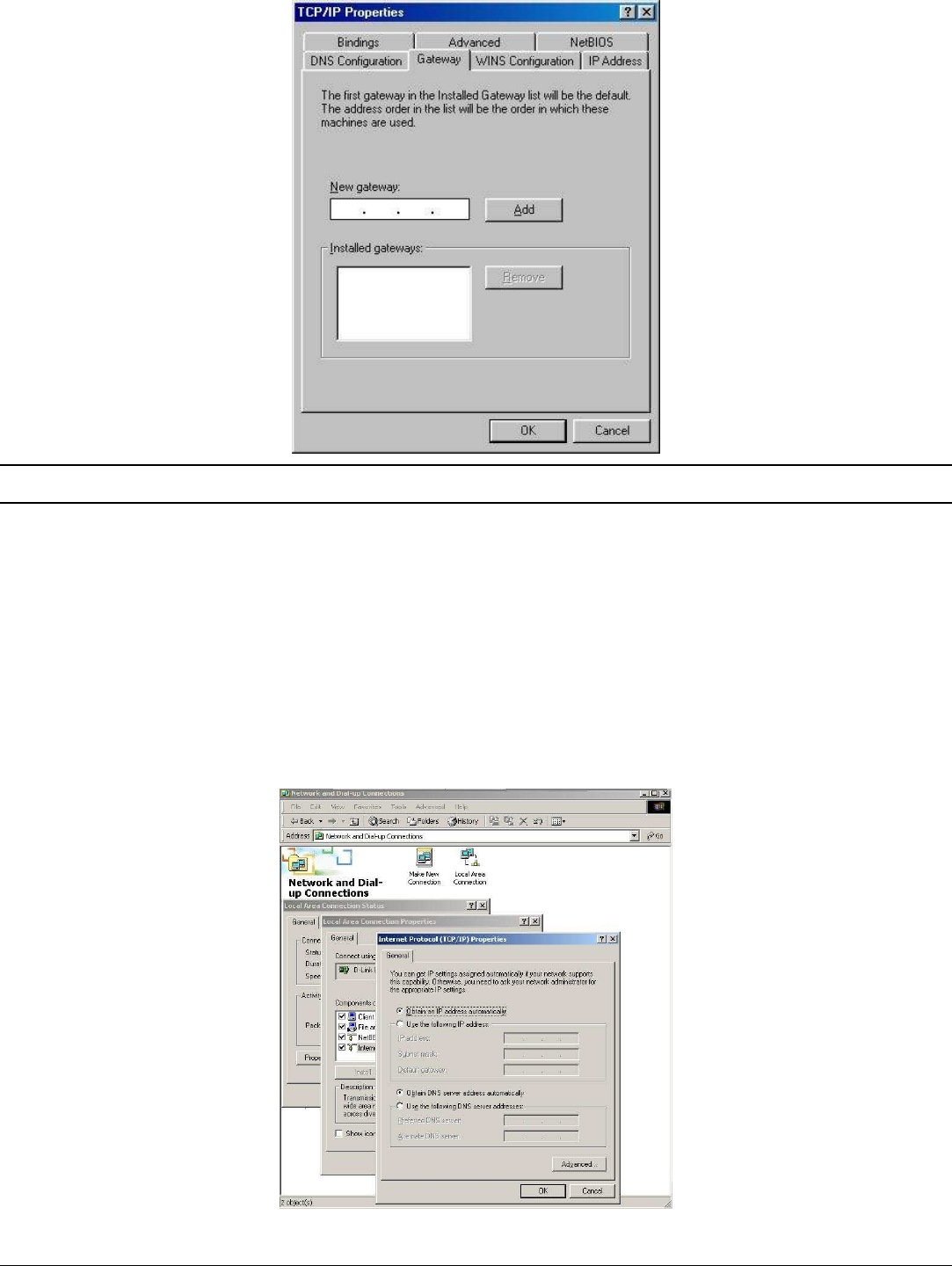
10
6. Select “None” for the “Gateway address” field.
Windows 2000
Double click on the “My Computer” icon on the desktop. When “My Computer”
window opens, open the “Control Panel” and then open the “Network dialup
connection” applet. Double click on the “Local area network connection” icon.
Select “Properties” to enter the TCP/IP setting window.
1. In the “Local area network status” window, click on “Properties.”
2. In the “Local area network connection” window, first select TCP/IP setting
and then select “Properties.”
3. Set both “IP address” and “DNS” to Automatic configuration.
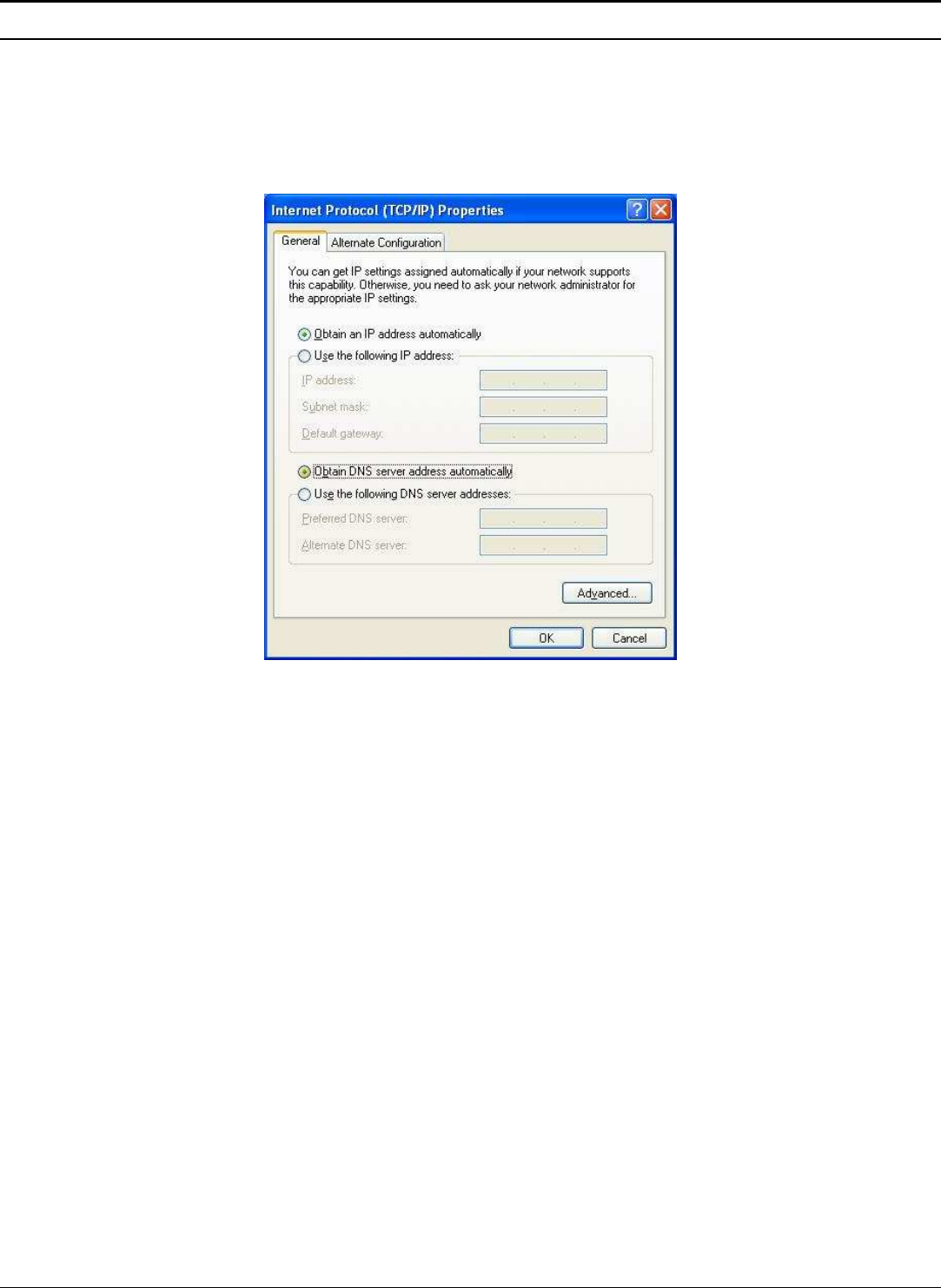
11
Windows XP / Vista
Point the cursor and click the right button on the “My Network Place” icon.
Select “properties” to enter the TCP/IP setting window.
1. Set “IP address” to “Obtain an IP address automatically.”
2. Set “DNS” to “Obtain DNS server address automatically.”
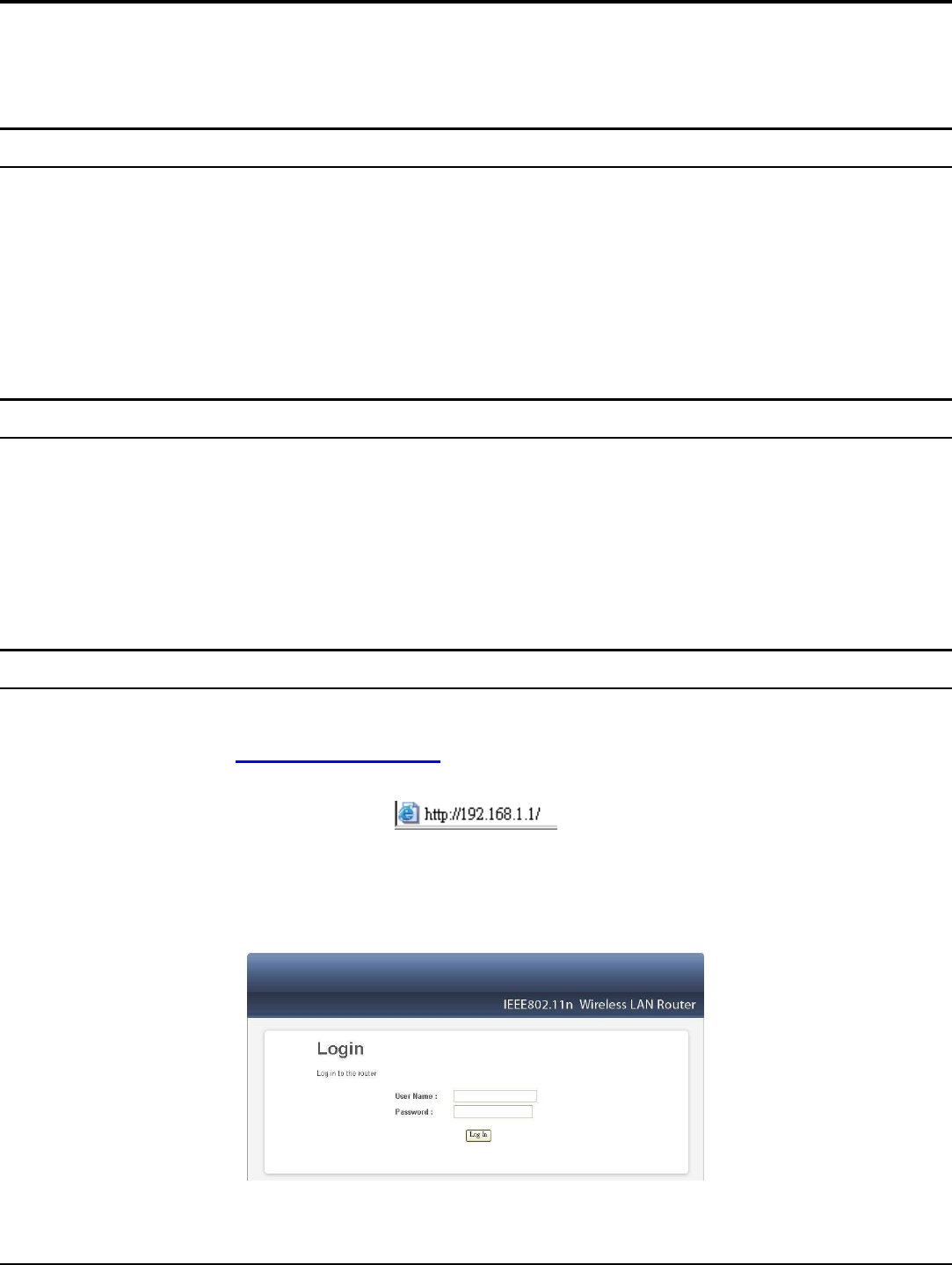
12
CONFIGURATION
First make sure that the network connections are functioning normally.
This WLAN Router can be configured using Internet Explorer 5.0 or newer web
browser versions.
Login to the WLAN Router through Wireless LAN
Before configuring the WLAN Router through WLAN, make sure that the SSID,
Channel and the WEP is set properly.
The default setting of the WLAN Router that you will use:
SSID: N Router
Channel: 6
Security: disable
Login to the WLAN Router
Before you configure this device, note that when the WLAN Router, make sure the
host PC must be set on the IP subnet that can be accessed by the xDSL/Cable
modem. For example, when the default network address of the xDSL/Cable modem
Ethernet interface is 192.168.1.x, then the host PC should be set at 192.168.1.xxx
(where xxx is a number between 2 and 254), and the default subnet mask is
255.255.255.0.
Using the Web Browser
1. Open Internet Explorer 5.0 or above Internet browser.
2. Enter IP address http://192.168.1.1 (the factory-default IP address setting) to
the URL web address location.
3. When the following dialog box appears, enter the user name and password to
login to the main configuration window, the default username and password is
“admin”.
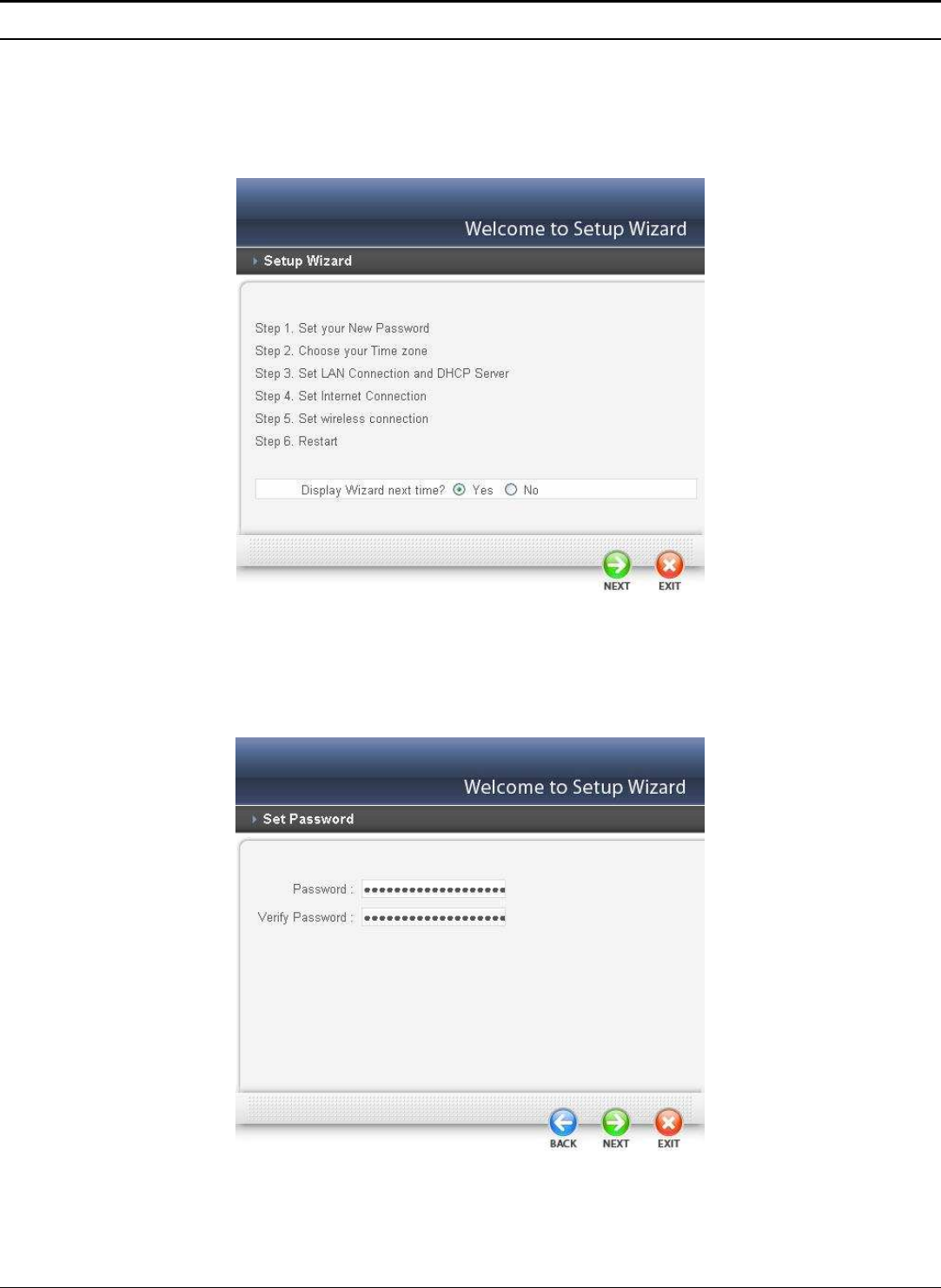
13
Setup Wizard
Setup wizard is provided as part of the web configuration utility. User can simply
follow the step-by-step process to get the wireless Router configuration ready to run
in 6 easy steps by clicking on` the “Wizard” button on the function menu. The
following screen will appear. Please click “Next” to continue.
Step 1: Set your new password
Setting the new admin password of the WLAN Router. Please click “Next” to
continue.
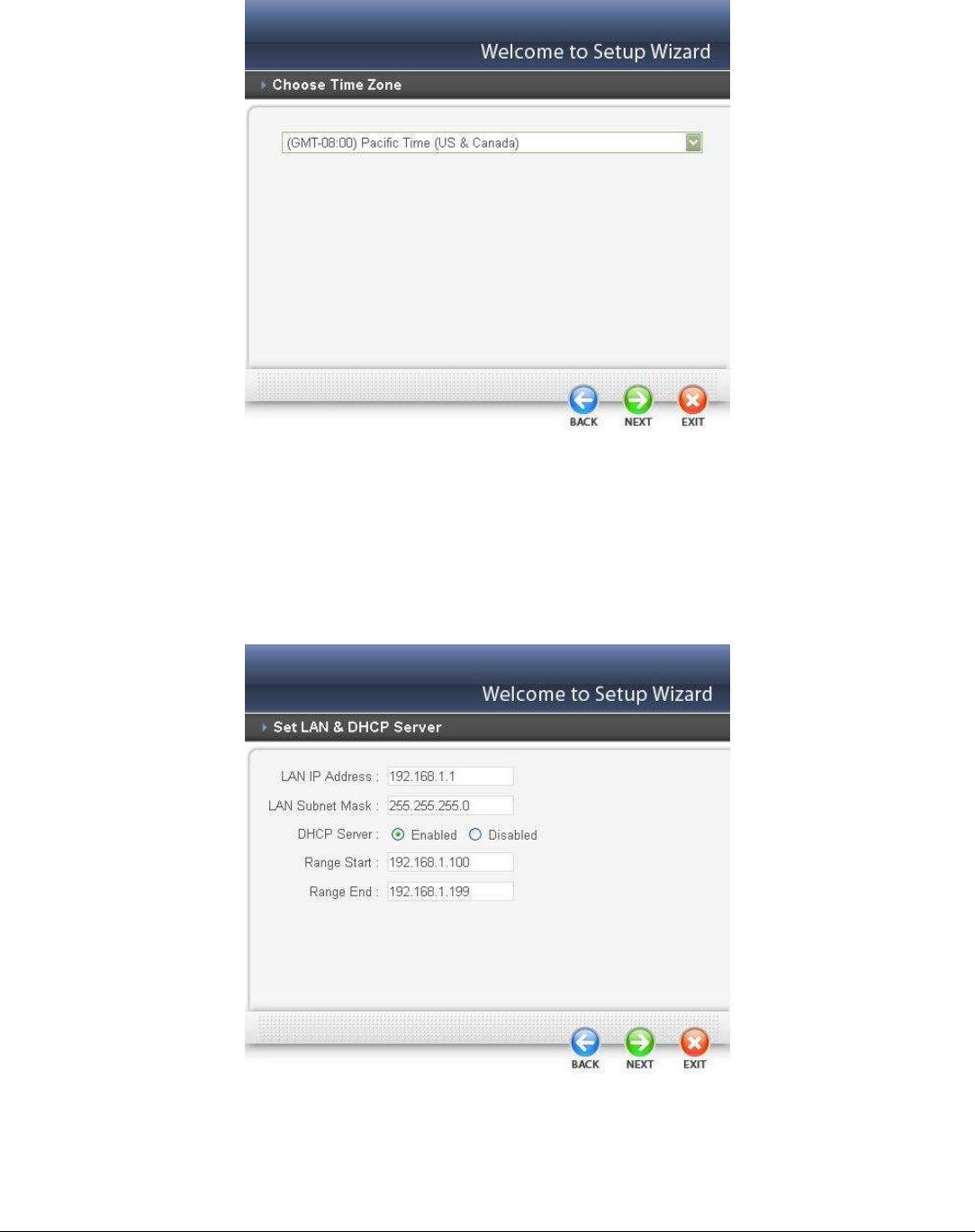
14
Step 2: Choose time zone
Select the time zone from the drop down list. Please click “Next” to continue.
Step 3: Set LAN connection and DHCP server
Set user’s IP address and mask. The default IP is 192.168.1.1. If the user chooses to
enable DHCP, please click “Enable”. DHCP enabled is able to automatically assign
IP addresses. Please assign the range of IP addresses in the fields of “Range start”
and “Range end”. Please click “Next” to continue.
Step 4: Set Internet connection
The WLAN Router will attempt to auto detect your Internet Connection.
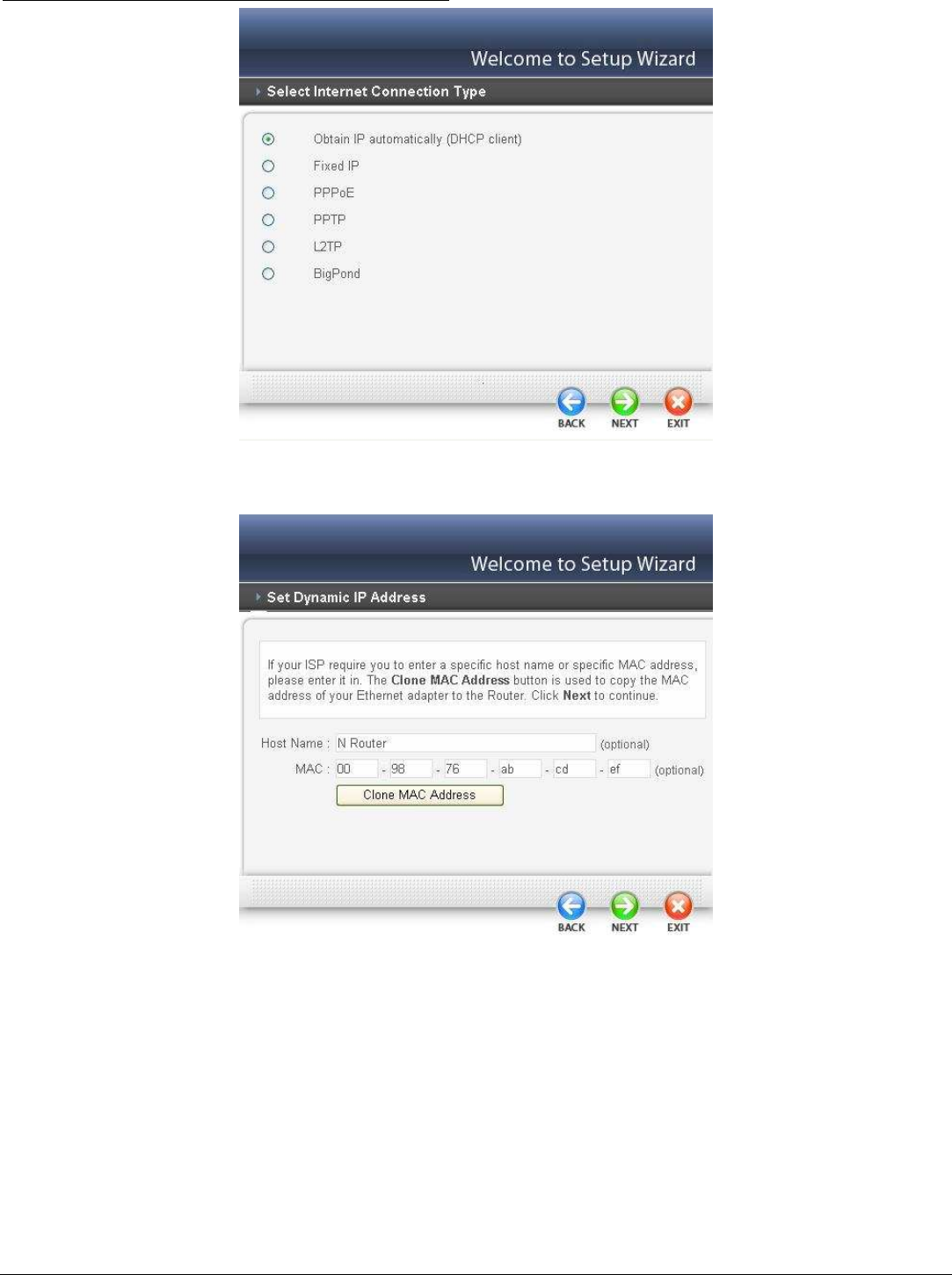
15
Obtain IP automatically (DHCP client):
If the user has enabled DHCP server, choose "Obtain IP automatically (DHCP
client)" to have the WLAN Router assign IP addresses automatically.
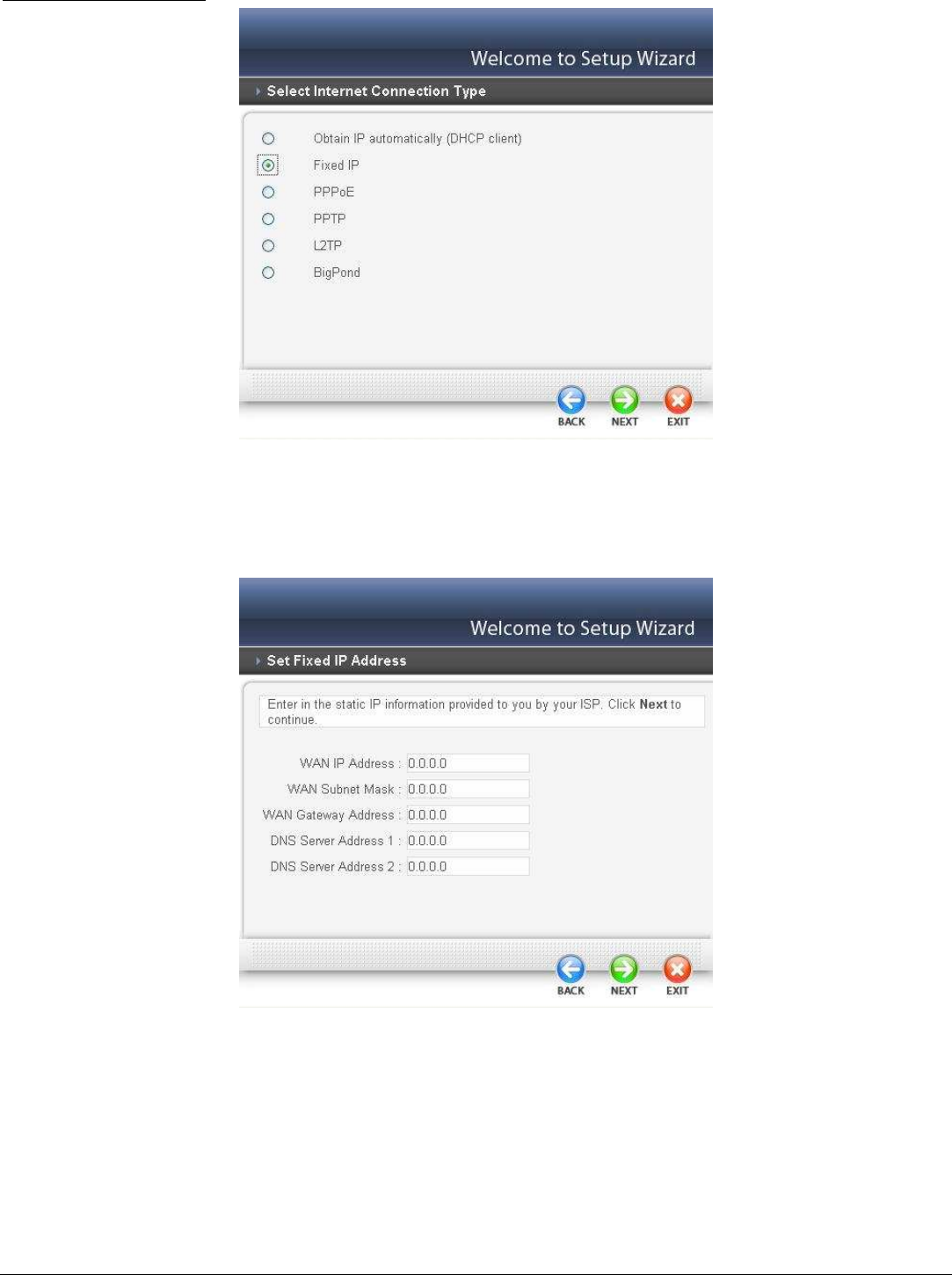
16
Fixed IP Address:
If the Internet Service Provider (ISP) assigns a fixed IP address, choose this option
and enter the assigned WAN IP Address, WAN Subnet Mask, WAN Gateway
Address and DNS Server Addresses for the WLAN Router.
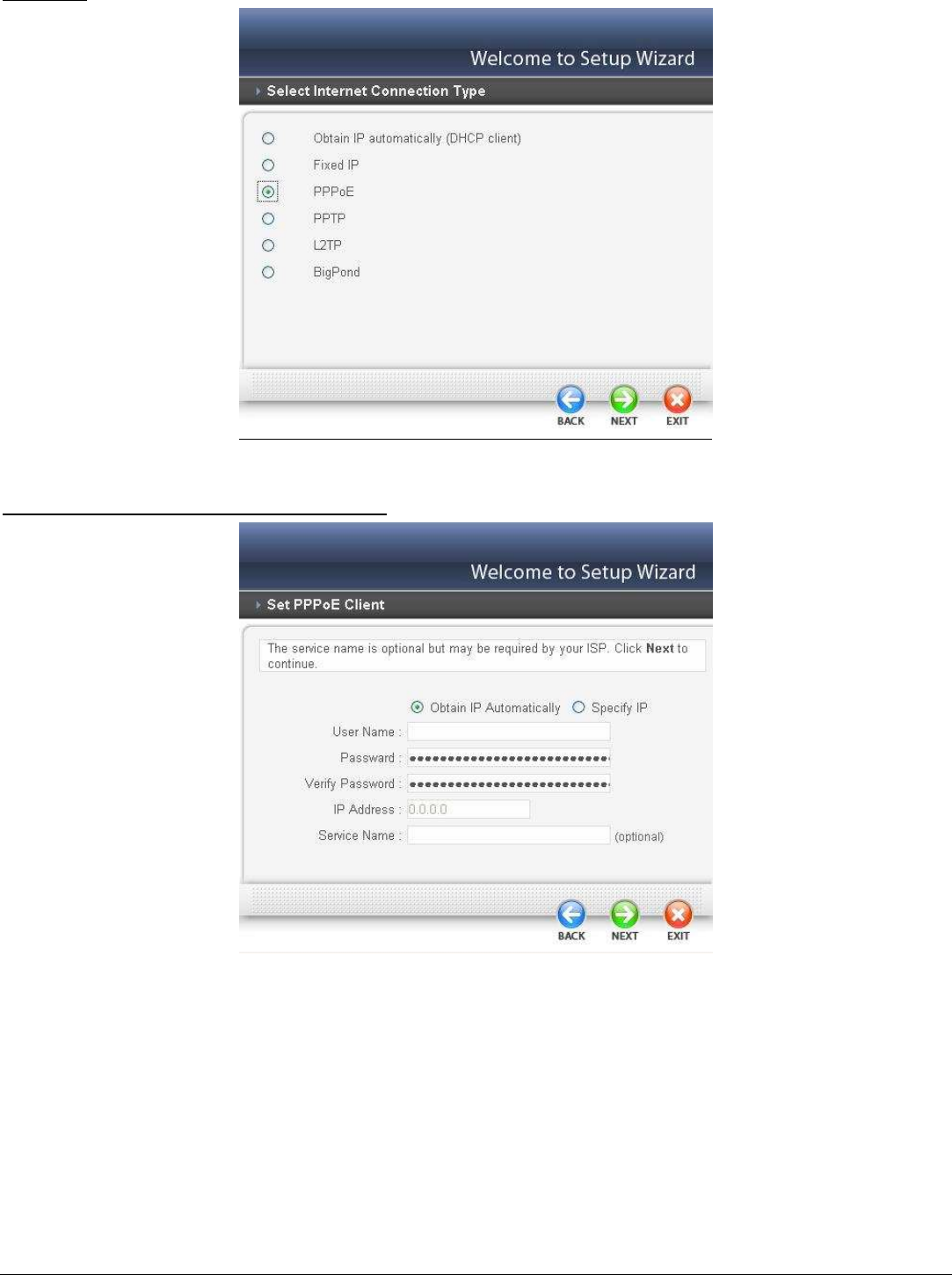
17
PPPOE
PPPoE to obtain IP automatically:
If connected to the Internet using a PPPoE (Dial-up xDSL) connection, and the ISP
provides a User Name and Password, then choose this option and enter the required
information.
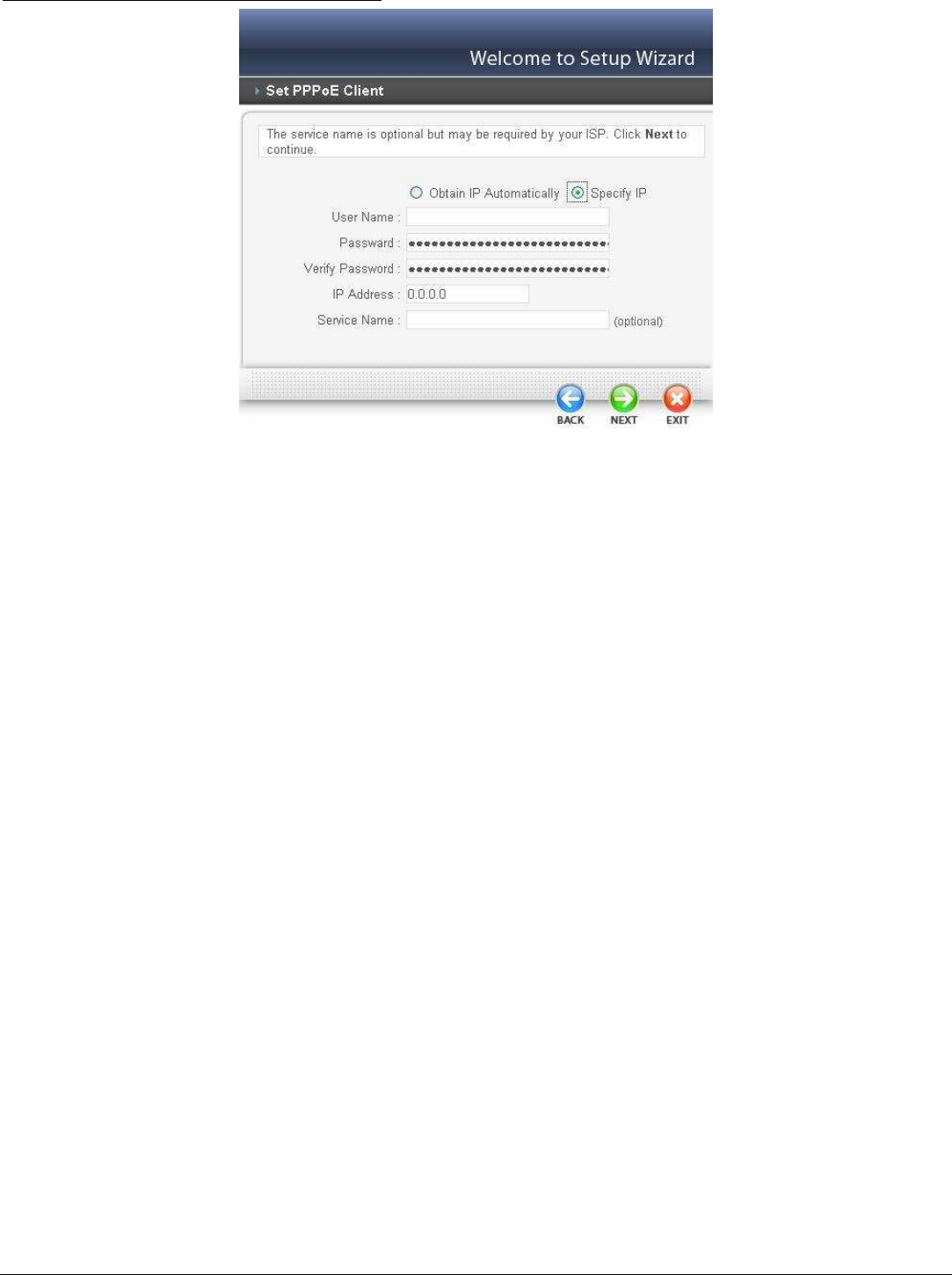
18
PPPoE with a Specify IP address:
If connected to the Internet using a PPPoE (Dial-up xDSL) connection, and the ISP
provides a User Name, Password and a Fixed IP Address, choose this option and
enter the required information.
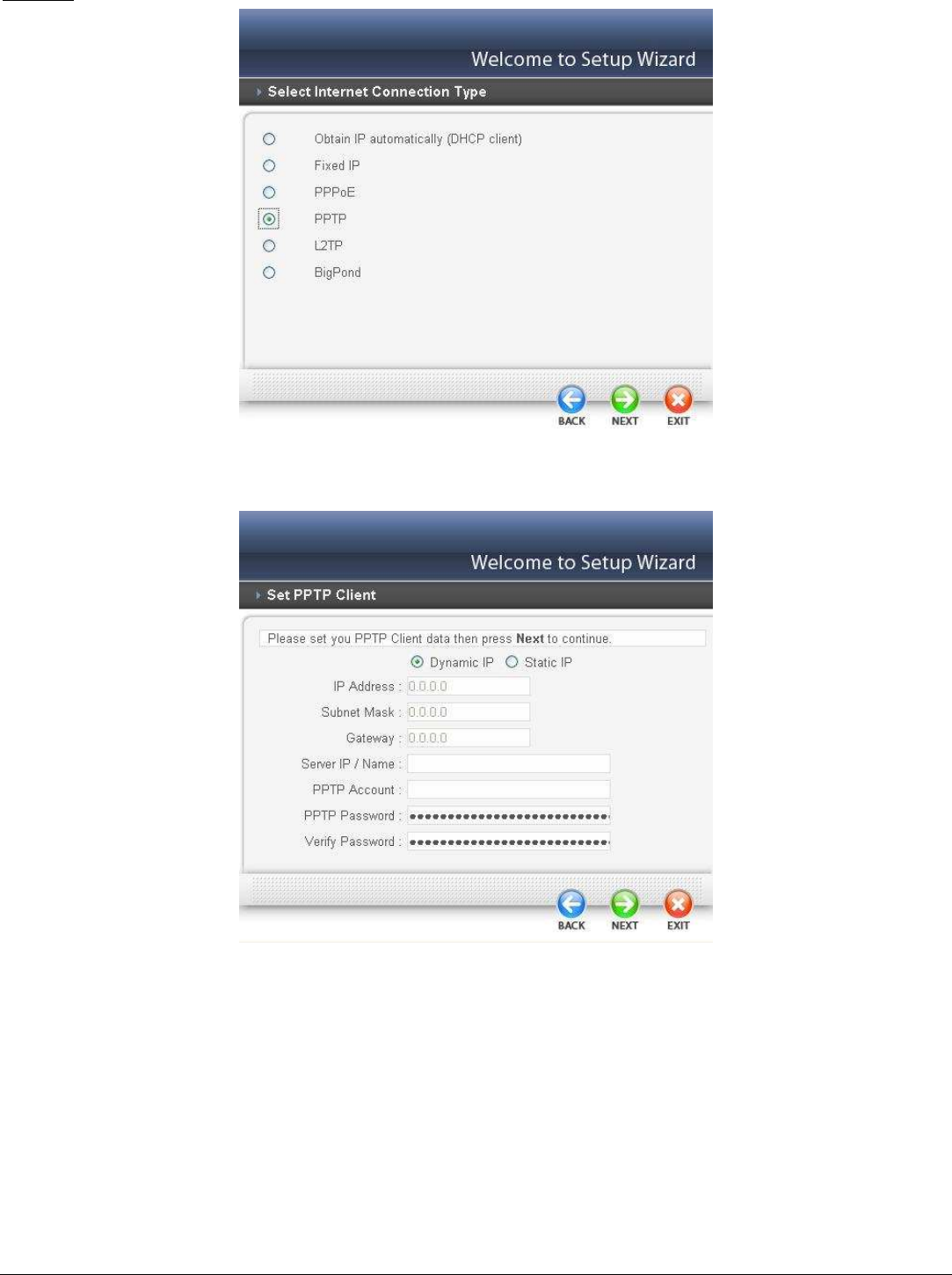
19
PPTP:
If connected to the Internet using a PPTP xDSL connection, enter your IP, Subnet
Mask, Gateway, Server IP, PPTP Account and PPTP Password.
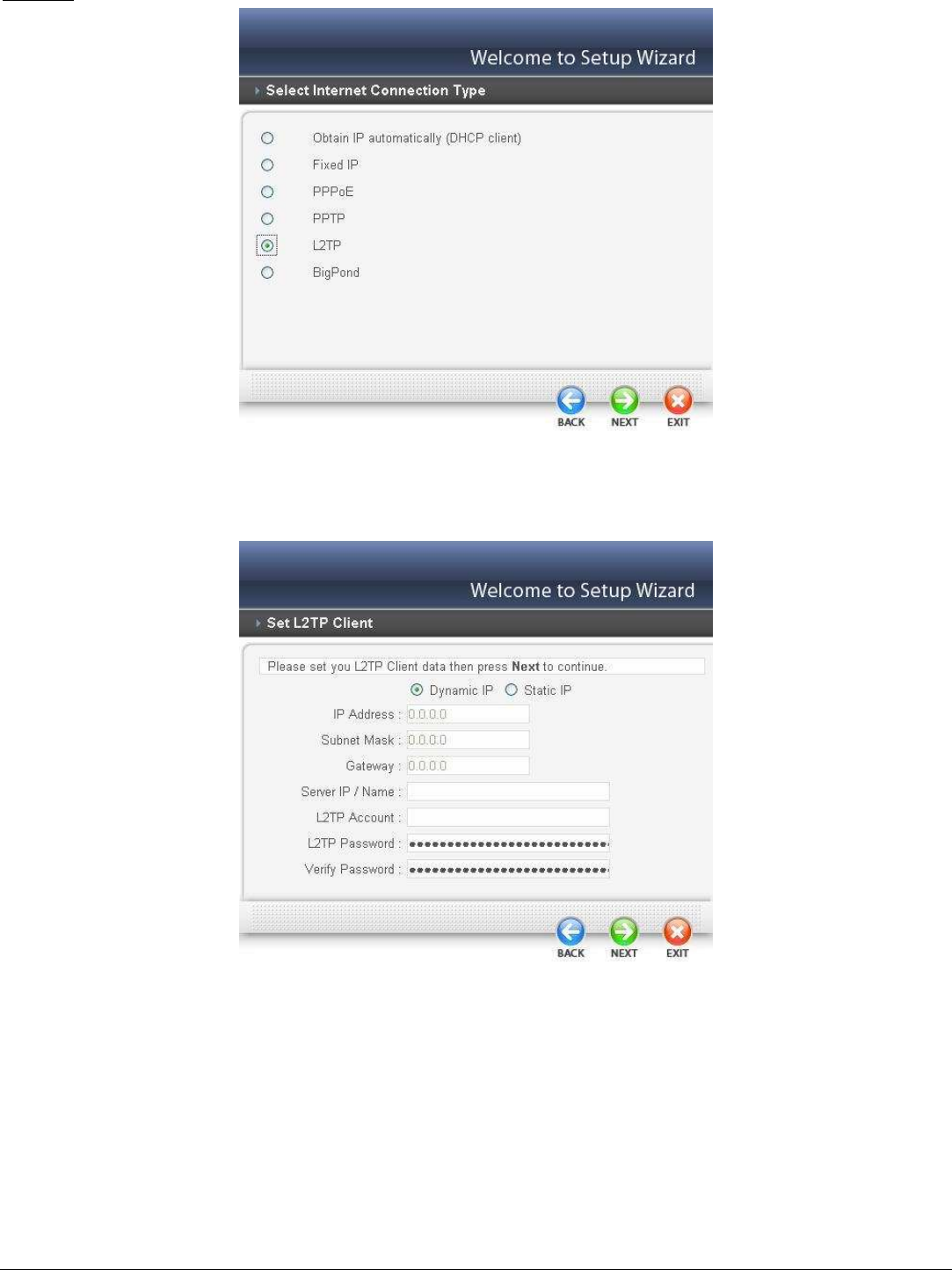
20
L2TP:
If connected to the Internet using a L2TP (Dial-up xDSL) connection and the ISP
provides a Server IP, Account and Password information, choose this option and
enter the required information.
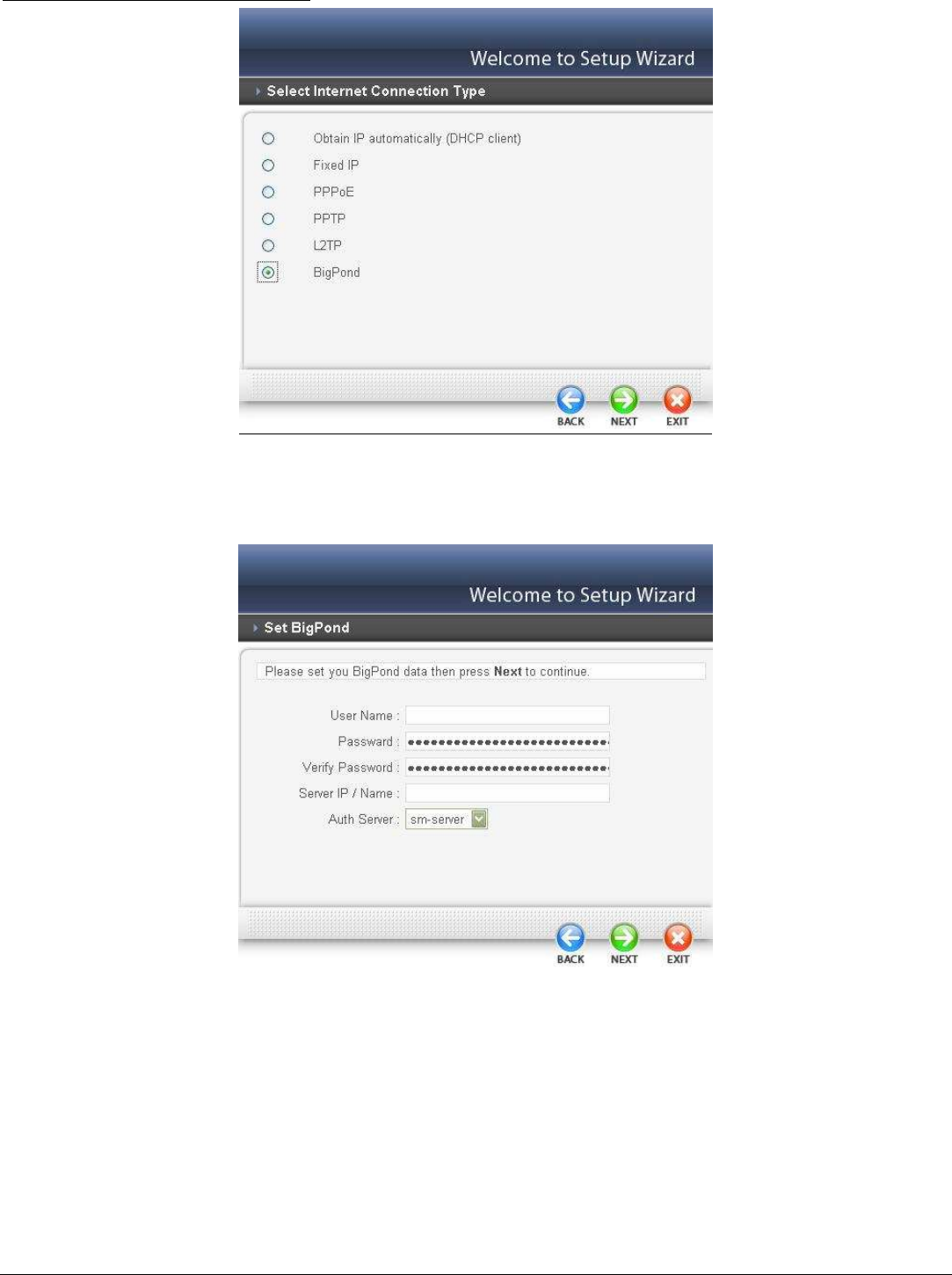
21
Big Pond Cable(Australia):
If your ISP is Big Pond Cable, the ISP will provide a User Name, Password,
Authentication Server and Login Server IP (Optional). Choose this option and
enter the required information.
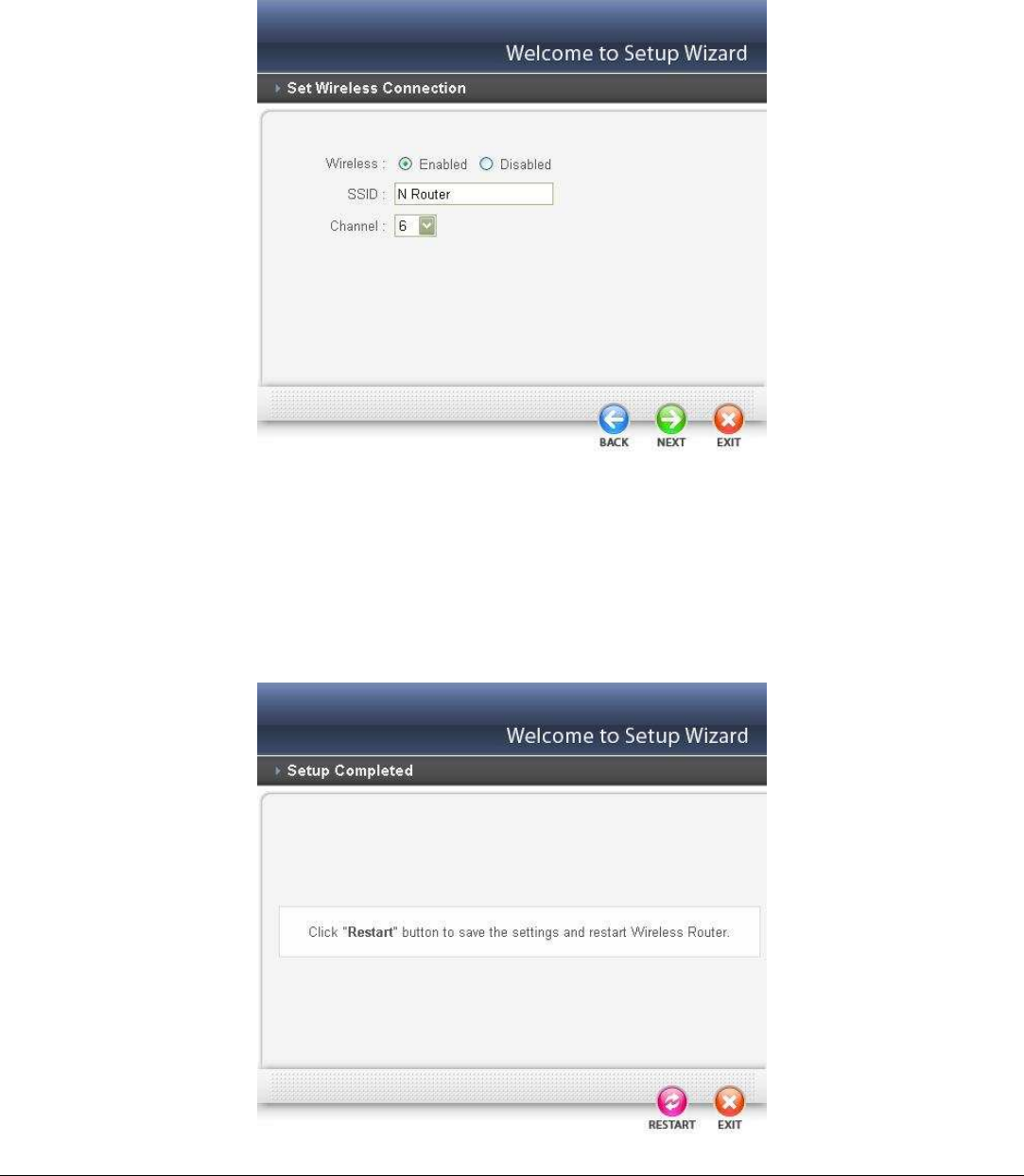
22
Step 5: Set Wireless LAN connection
Click “Enable” to enable Wireless LAN. If user enables the Wireless LAN, type the
SSID in the text box and select a communications channel. The SSID and channel
must be the same as wireless devices attempting to connect to the WLAN Router.
(When in FCC domain, you could chose ch1~ch11; in ETSI domain, you could
chose ch1~ch13)
Step 6: Setup completed
The Setup wizard is now completed. The new settings will be effective after the
WLAN Router restarts. Please click “Restart” to reboot the WLAN Router. If user
does not want to make any changes, please click “Exit” to quit without any changes.
User also can save the settings and restart Wireless Router by Click "Restart"
button.

23
WAN Setting
This function enables users to set up the WLAN Router WAN connection, specify
the IP address for the WAN, add DNS numbers, and enter the MAC address.
Connection Type:
Select the connection type, either DHCP client, Fixed IP or
PPPoE, PPTP, L2TP or BigPond from the drop-down list.
DHCP Client or Fixed IP
If user has enabled DHCP server, choose "Obtain IP automatically (DHCP client)"
to have the router assign IP addresses automatically.
WAN IP Address: Select whether user wants to specify an IP address manually, or
want DHCP to obtain an IP address automatically. When Specify IP is selected,
type the IP address, subnet mask, and default gateway in the text boxes. User’s ISP
will provide with this information.
IP Address: For the Specify mode, enter the specific IP address that provided by
your ISP.
Subnet Mask: For the Specify mode, enter the specific subnet mask that provided
by your ISP.
Gateway: For the Specify mode, enter the specific gateway IP address that
provided by your ISP.
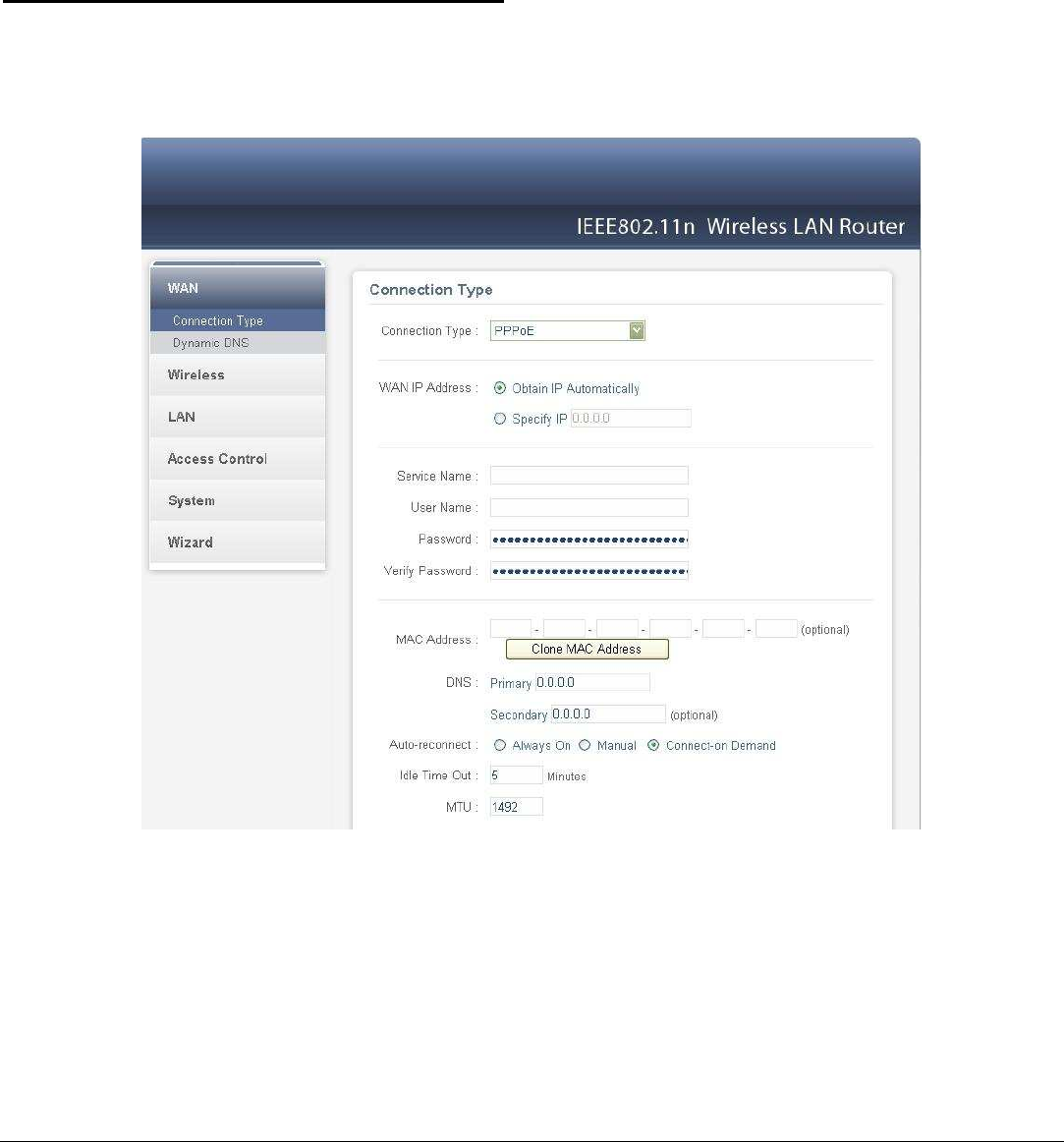
24
DNS 1/2: Manually specific DNS server IP address. For the Obtain IP
Automatically mode, leave 0.0.0.0 hear, the DHCP server will provides DNS server
automatically.
Clone MAC Address: If your ISP requires you to enter a specific MAC address,
please enter it in. The Clone MAC Address button is used to copy the MAC address
of your Ethernet adapter to the Router.
PPPoE with Obtain IP Automatically
If connected to the Internet using a PPPoE (Dial-up xDSL) Modem, the ISP will
provide a Password and User Name, and then the ISP uses PPPoE. Choose this
option and enter the required information.
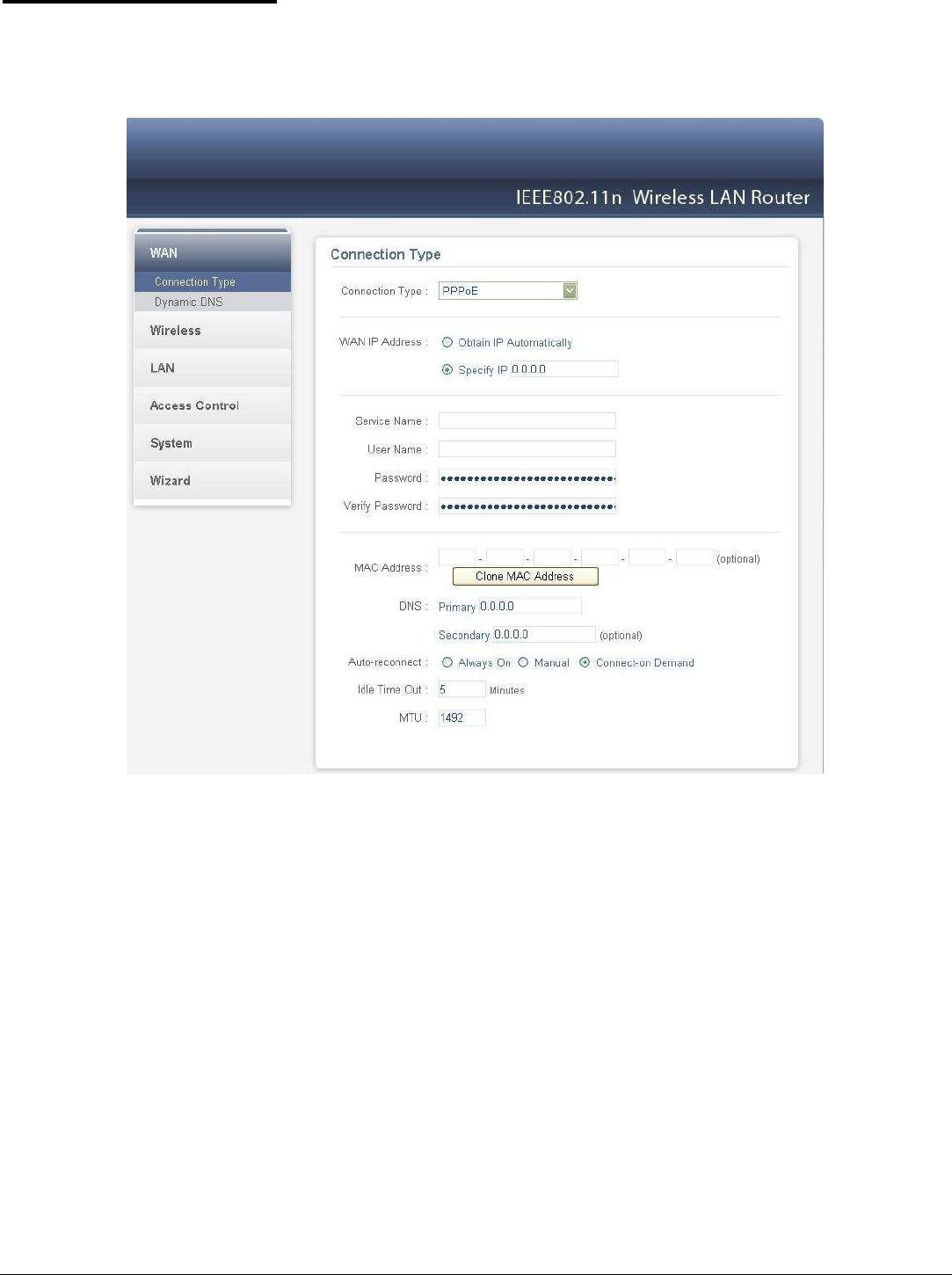
25
PPPoE with Specify IP
If connected to the Internet using a PPPoE (Dial-up xDSL) Modem, the ISP will
provide a Password, User Name and a Specify IP Address, choose this option and
enter the required information.
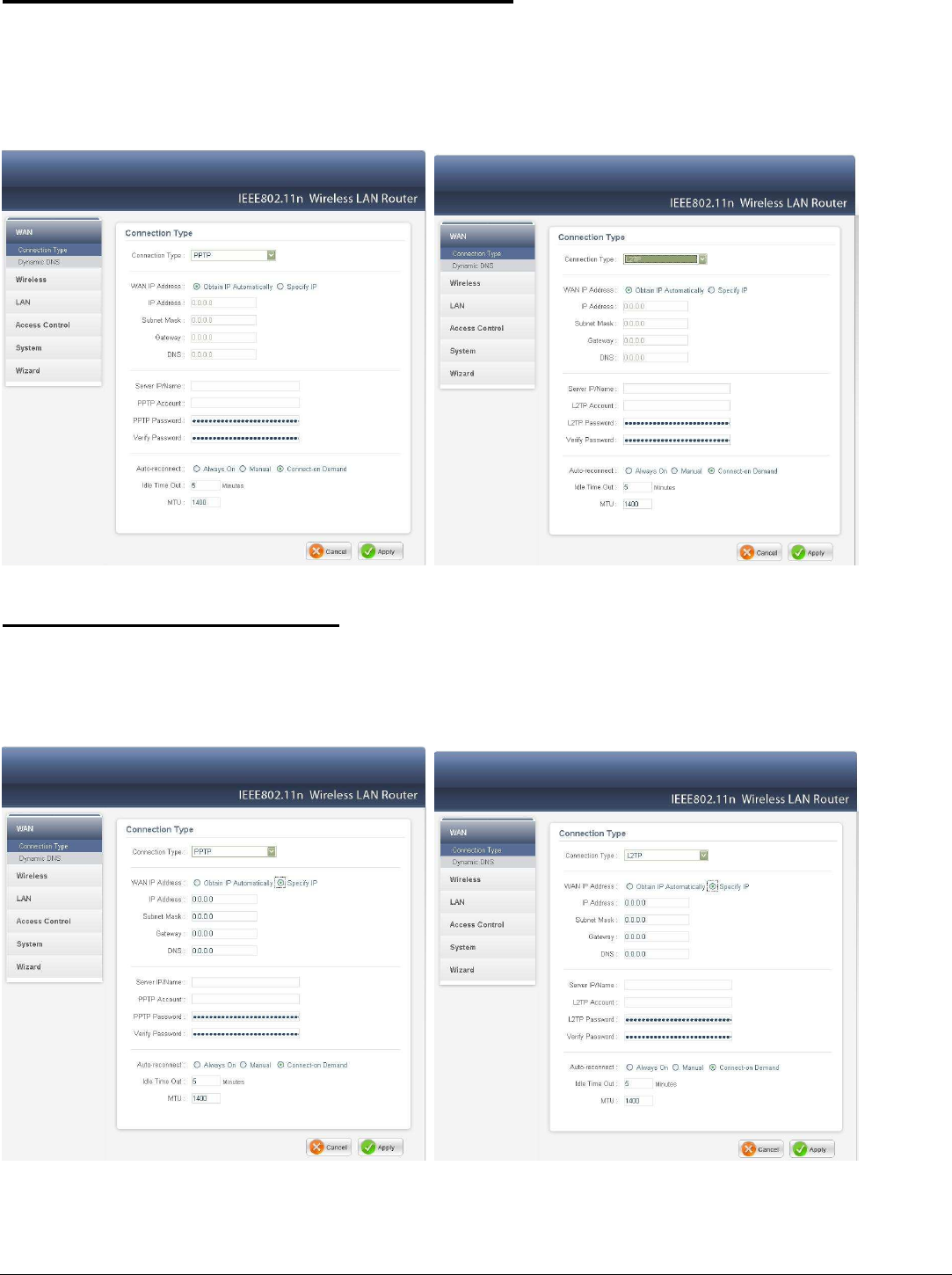
26
PPTP/L2TP with Obtain IP Automatically
If connected to the Internet using a PPTP/L2TP (Dial-up xDSL) connection, enter
the your Server IP, PPTP/L2TP Account and PPTP/L2TP Password, if your ISP has
provided you with a DNS IP address, enter it in the DNS field, otherwise, leave it
zero.
PPTP/L2TP with Specify IP
If connected to the Internet using a PPTP/L2TP (Dial-up xDSL) connection, enter
the your IP Address, Subnet Mask, Gateway IP address, DNS IP address, Server IP
address, PPTP Account and PPTP Password.
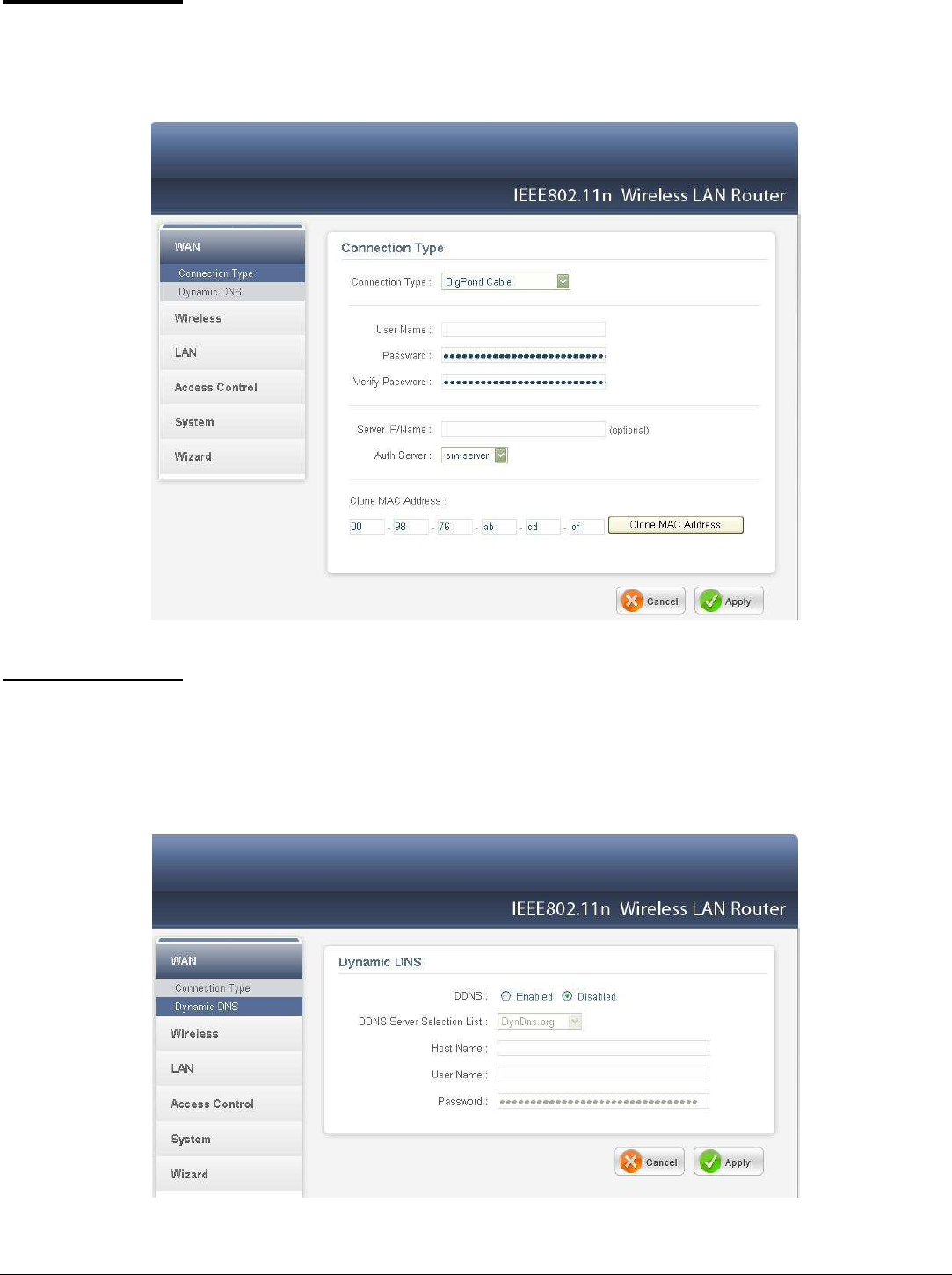
27
BigPond Cable
If your ISP is Big Pond Cable, the ISP will provide a User Name, Password,
Authentication Server and Login Server IP (Optional). Choose this option and
enter the required information.
Dynamic DNS:
This synchronizes the DDNS server with your current Public IP address when you
are online. First, you need to register your preferred DNS with the DDNS provider.
Then, please selected one of DDNS server than fill the related information in the
below fields: Host Name, User Name and Password.
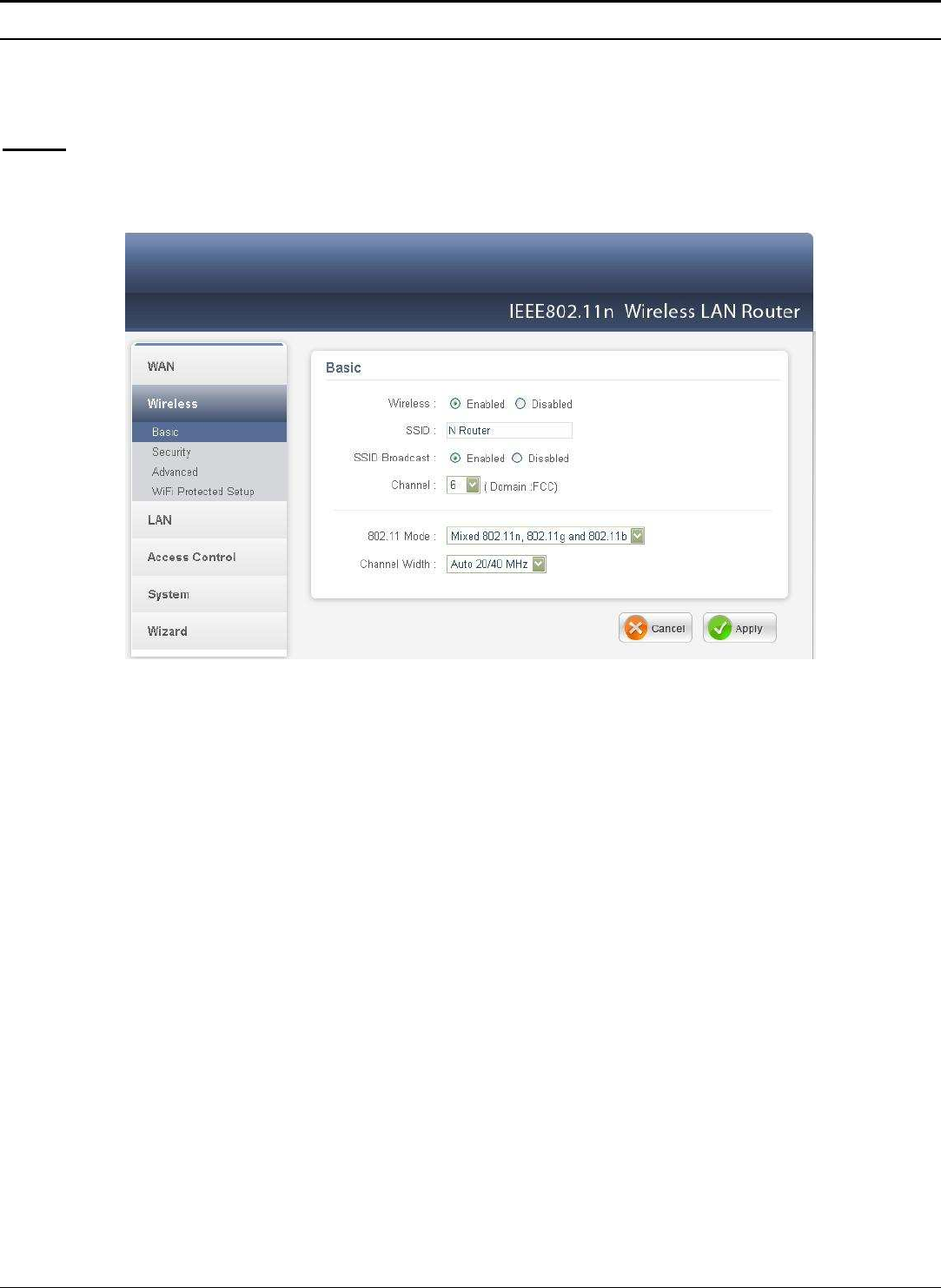
28
Wireless setting
This section enables user to set wireless communications parameters for the router's
wireless LAN feature.
Basic
This page allow user to enable and disable the wireless LAN function, create a
SSID, and select the channel for wireless communications.
Enable/Disable: Enables or disables wireless LAN via the WLAN Router.
SSID: Type an SSID in the text box. The SSID of any wireless device must match
the SSID typed here in order for the wireless device to access the LAN and WAN
via the WLAN Router.
Channel: Select a transmission channel for wireless communications. The channel
of any wireless device must match the channel selected here in order for the
wireless device to access the LAN and WAN via the WLAN Router.(When in FCC
domain, you could chose ch1~ch11; in ETSI domain, you could chose ch1~ch13)
802.11 Mode: Select one of the following:
802.11b only - Select if you are using 802.11b wireless clients only.
802.11g only - Select if you are using 802.11g wireless clients only.
802.11n only - Select if you are using 802.11n wireless clients only.
Mixed 802.11b and 802.11g - Select if you are using both 802.11b and
802.11n wireless clients.
Mixed 802.11n, 802.11b, and 802.11g - Select if you are using a mix of
802.11n, 11g, and 11b wireless clients.
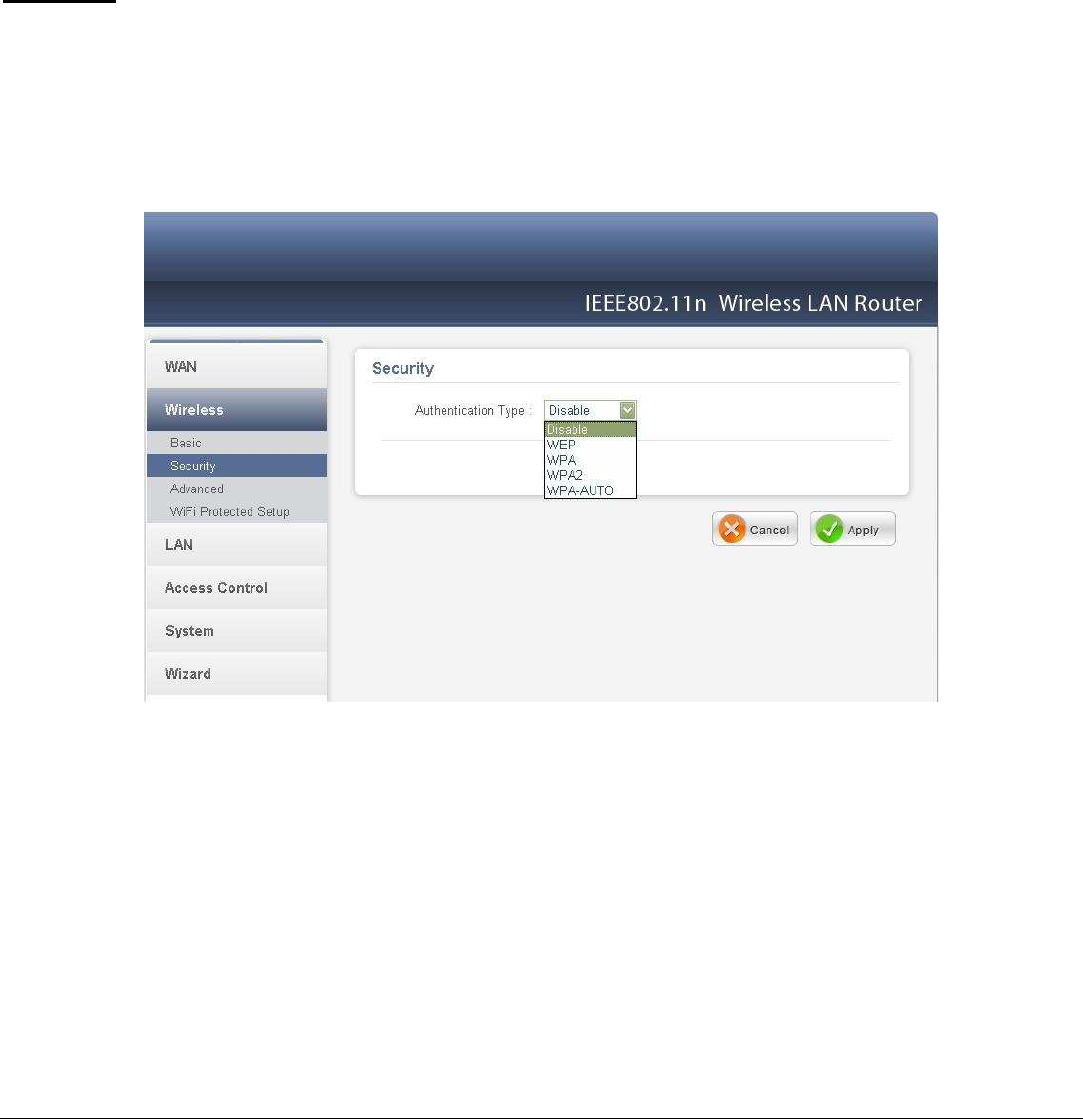
29
Channel Width: Select the Channel Width:
Auto 20/40 - This is the default setting. Select if you are using both 802.11n
and non-802.11n wireless devices.
20MHz - Select if you are not using any 802.11n wireless clients.
SSID Broadcast: While SSID Broadcast is enabled, all wireless clients will be able
to view the WLAN Router’s SSID. For security purposes, users may want to
disable SSID Broadcast to ensure only authorized clients have access.
Security
This function enables user to set authentication type for secure wireless
communications. Open System allows public access to the router via wireless
communications. Shared Key requires the user to set a WEP key to exchange data
with other wireless clients that have the same WEP key. This router also supports
WPA, WPA2 and WPA-PSK, WPA2-PSK.
Authentication Type: The authentication type default is set to open system.
There are four options: Disabled, WEP, WPA, WPA2 and WPA-Auto.
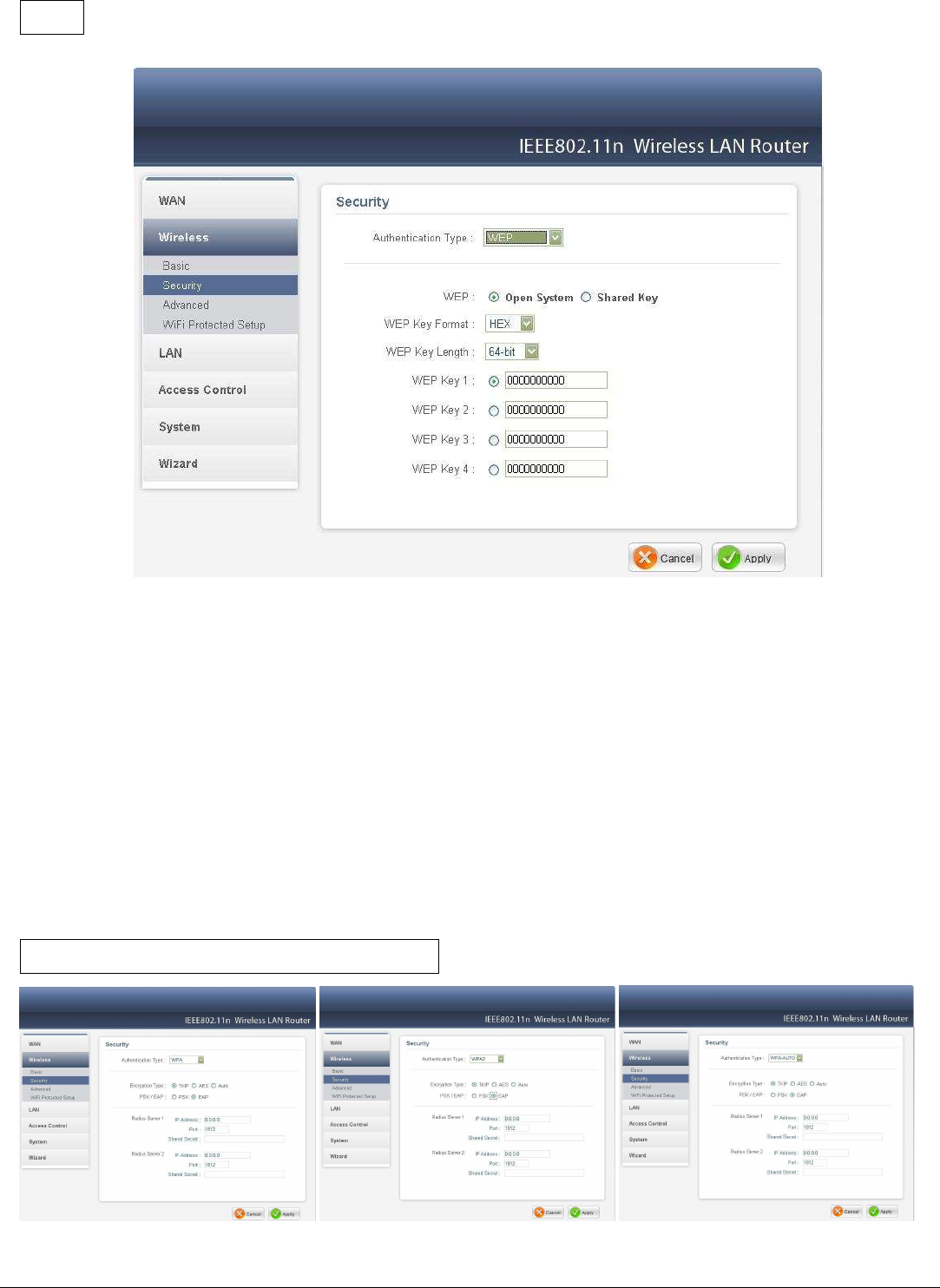
30
WEP
WEP: Open System and Shared Key requires the user to set a WEP key to
exchange data with other wireless clients that have the same WEP key.
WEP Key Format: Select the key format from the drop-down list HEX or ASCII.
WEP Key Length: Select the level of encryption from the drop-down list. The
WLAN Router supports, 64 and 128-bit encryption.
WEP Key 1 ~ 4: Enables users to create up to 4 different WEP keys. Manually
enter a set of values for each key. Select a key to use by clicking the radio button
next to the key. Click “Clear” to erase key values.
WPA / WPA2/ WPA-Auto Security
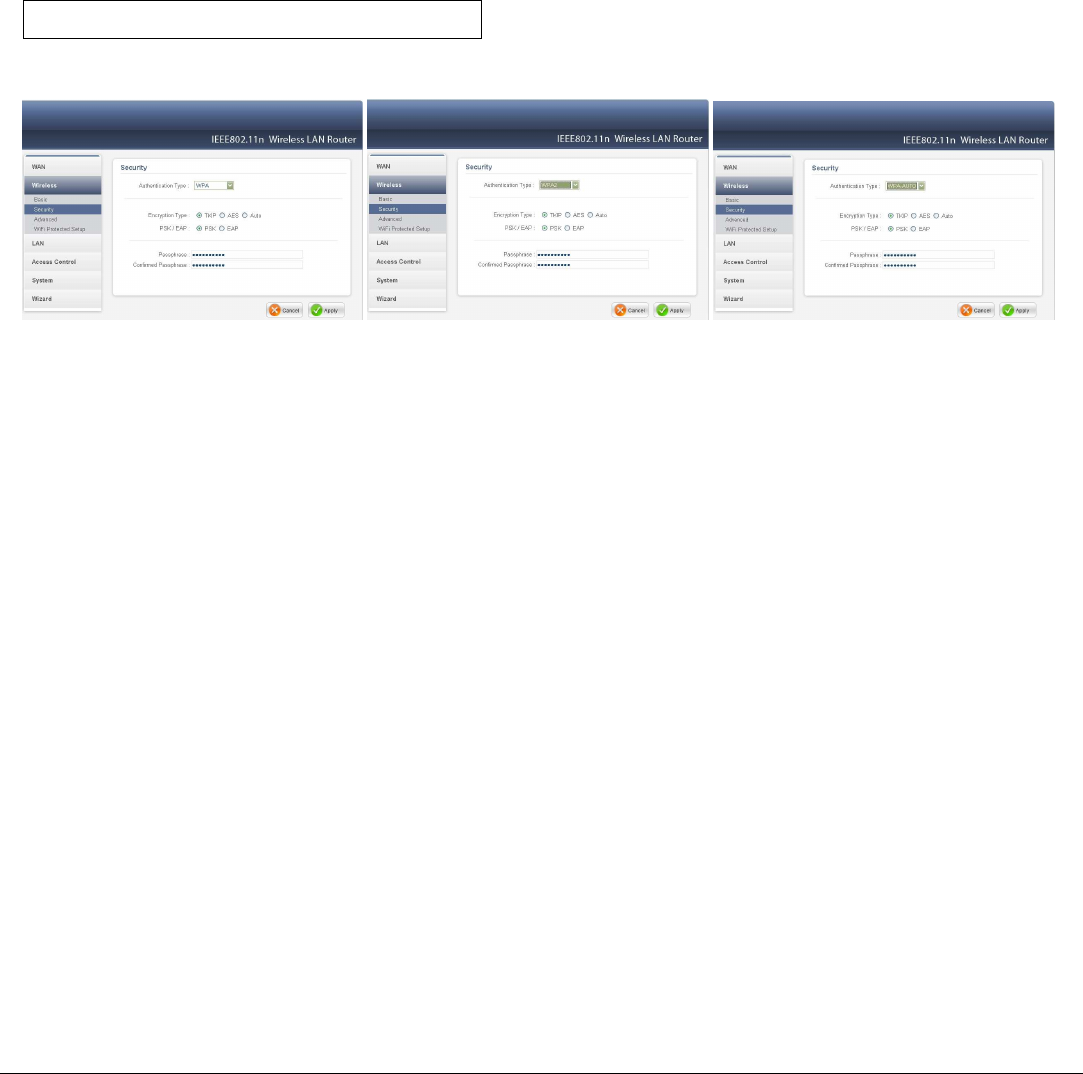
31
If WPA, WPA2 or WPA-Auto EAP is selected, the above screen is shown. Please
set the length of the encryption key and the parameters for the RADIUS server.
Cipher Type: Select the cipher type for TKIP or AES encryption, Selected Auto
for auto detects the cipher type.
RADIUS Server:
1. Enter the IP address, Port used and Shared Secret by the Primary Radius
Server.
2. Enter the IP address, Port used and Shared Secret by the Secondary Radius
Server. (optional)
WPA-PSK / WPA2-PSK Security
If WPA, WPA2 or WPA-Auto PSK is selected.
Cipher Type: Select the cipher type for TKIP or AES encryption, Selected Auto
for auto detects the cipher type.
Passphrase: The length should be 8 characters at least.
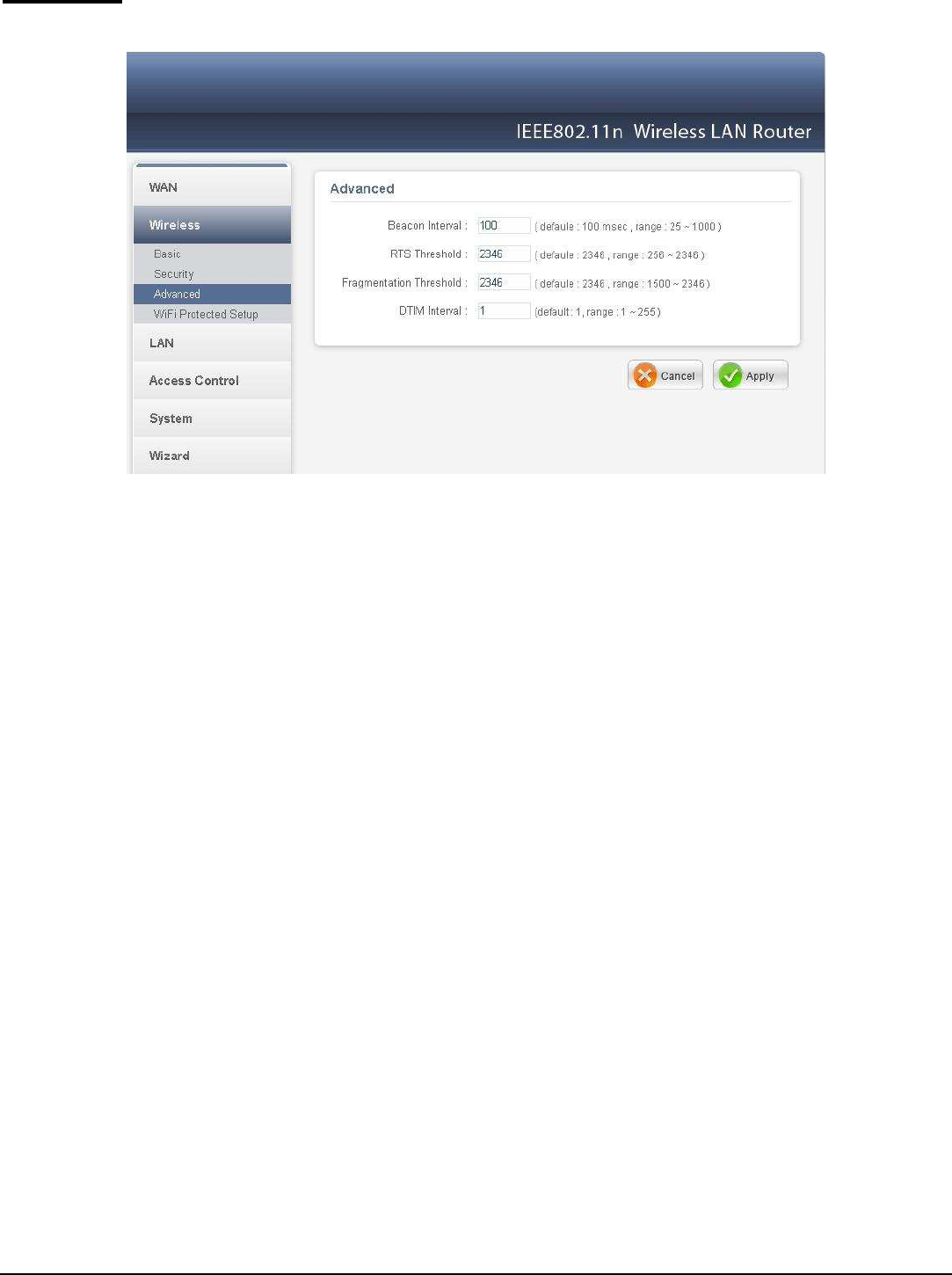
32
Advanced
This function enables user to configure advanced wireless functions.
Beacon Interval: Type the beacon interval in the text box. User can specify a value
from 25 to 1000. The default beacon interval is 100.
RTS Threshold: Type the RTS (Request-To-Send) threshold in the text box. This
value stabilizes data flow. If data flow is irregular, choose values between 256 and
2346 until data flow is normalized.
Fragmentation Threshold: Type the fragmentation threshold in the text box. If
packet transfer error rates are high, choose values between 1500 and 2346 until
packet transfer rates are minimized. (NOTE: set this fragmentation threshold value
may diminish system performance.)
DTIM Interval: Type a DTIM (Delivery Traffic Indication Message) interval in
the text box. User can specify a value between 1 and 255. The default value is 1.
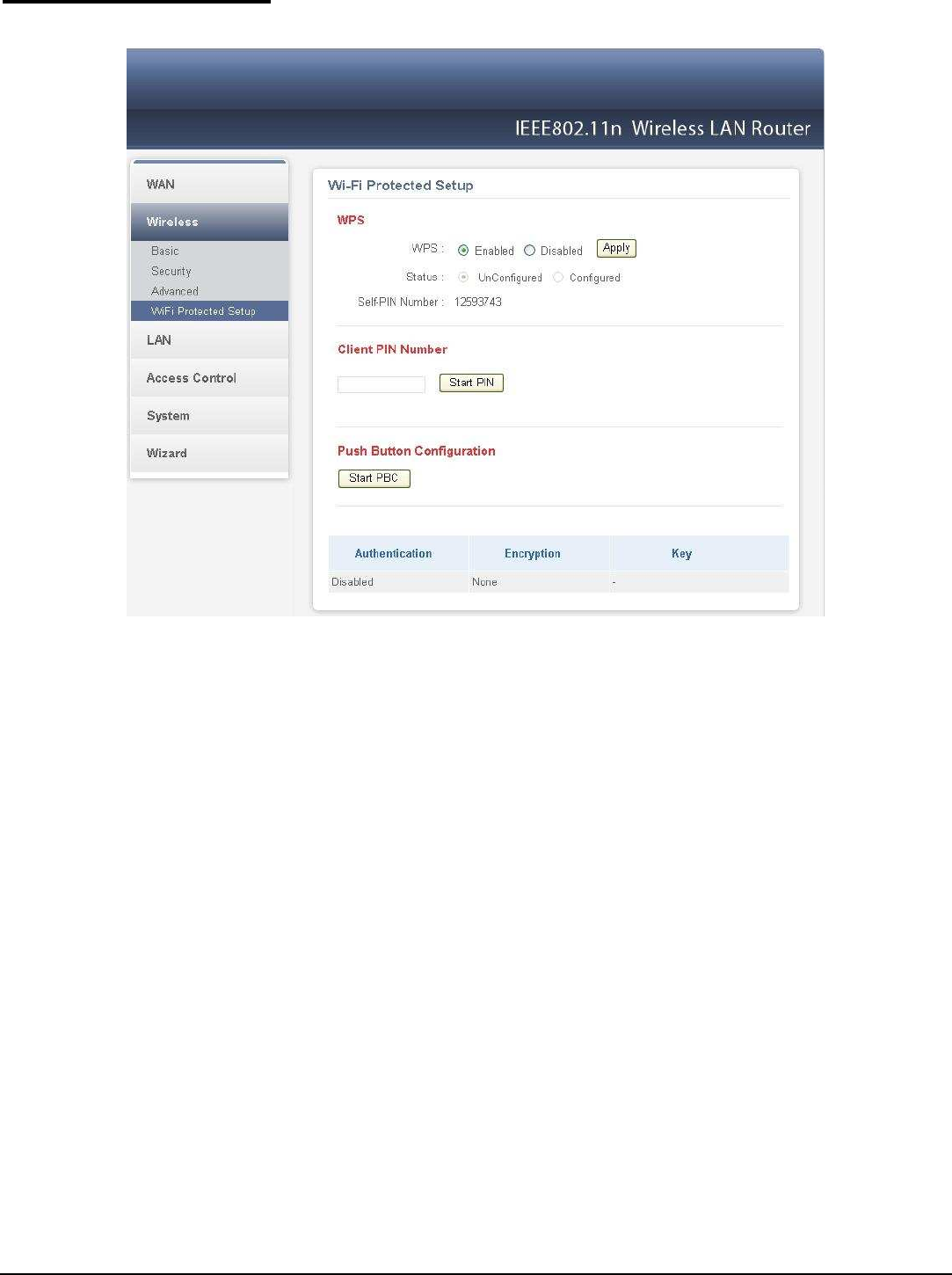
33
Wi-Fi Protected Setup
This screen enables users to configure the Wi-Fi Protected Setup function.
WPS: Enable or Disable the WPS (Wi-Fi Protected Setup) function
Status: Display the state (Un-configured State/Configured State) information of
WPS.
Self-PIN Number: Display the default PIN number of WLAN Router.
Client PIN Number: Type Client PIN number the client uses to negotiate with
WLAN Router via WPS protocol. It is only used when users want their station to
join Router's network.
Push Button Configuration: Clicking the Start PBC button will invoke the Push
Button Configuration (PBC) method of WPS. It is only used when WLAN Router
acts as a Registrar.
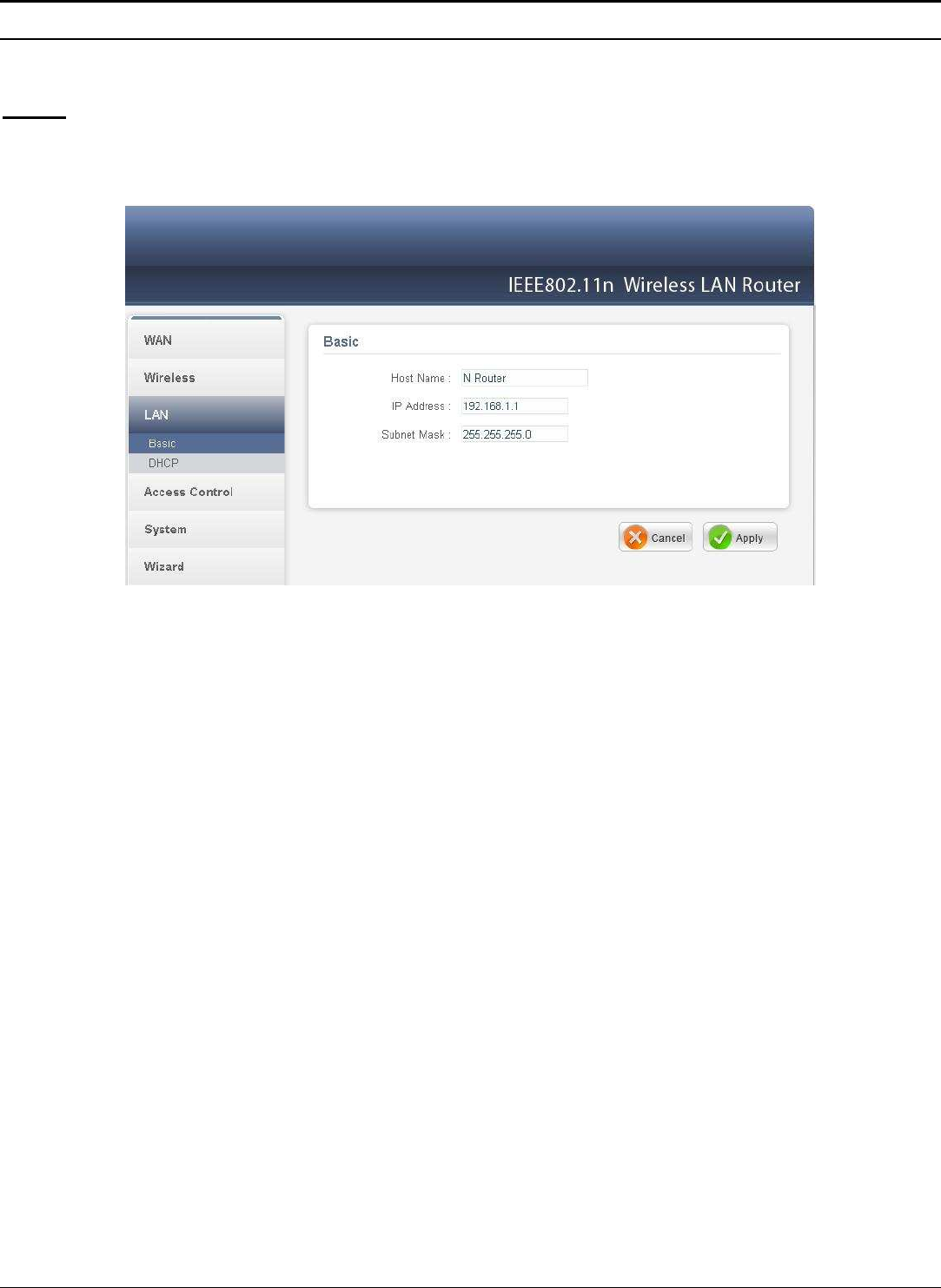
34
LAN Setting
The function enables user to configure the LAN port IP address & DHCP Server.
Basic
This page leads to set LAN port properties, such as the host name, IP address, and
subnet mask.
Host Name: Type the host name in the text box. The host name is required by
some ISPs. The default host name is "
N Router"
IP Address: This is the IP address of the router. The default IP address is
192.168.1.1.
Subnet Mask: Type the subnet mask for the router in the text box. The default
subnet mask is 255.255.255.0.
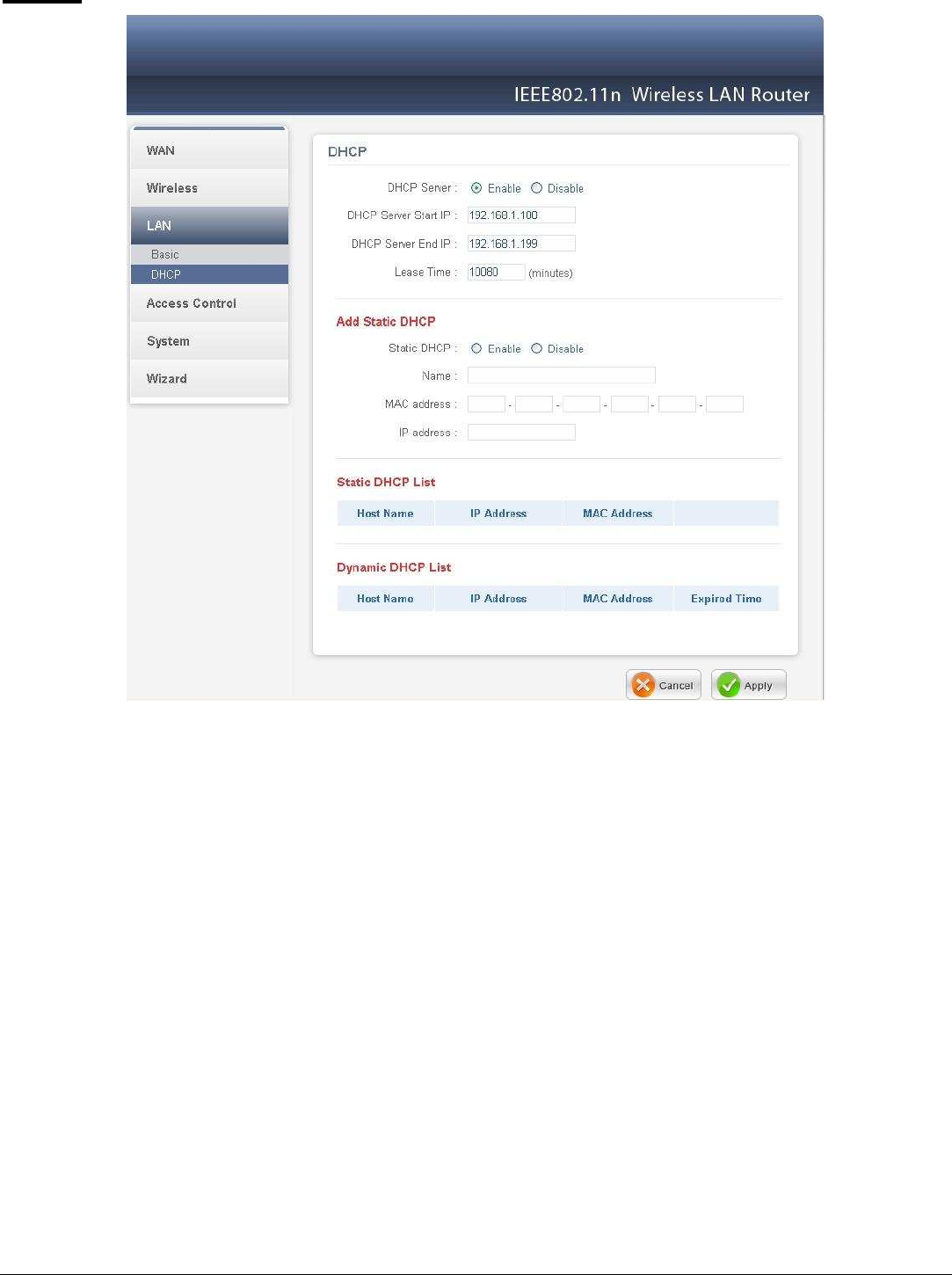
35
DHCP
DHCP Server: Enables the DHCP server to allow the router to automatically
assign IP addresses to devices connecting to the LAN. DHCP is enabled by default.
DHCP Server Start IP: Type an IP address to serve as the start of the IP range that
DHCP will use to assign IP addresses to all LAN devices connected to the router.
DHCP Server End IP: Type an IP address to serve as the end of the IP range that
DHCP will use to assign IP addresses to all LAN devices connected to the router.
Lease Time: The lease time specifies the amount of connection time a network
user be allowed with their current dynamic IP address.
Add Static DHCP: Selected Enable the Static DHCP allows you to assign a static
IP address to the PC that has the IP address and MAC address mapping set in the
Static DHCP List.
Static DHCP List: The static DHCP mapping will list in the table, providing the
Host Name, MAC Address and IP Address.

36
Dynamic DHCP List: All dynamic DHCP client computers are listed in the table
and providing the Host name, IP address, and MAC address and Expired Time of
the client.
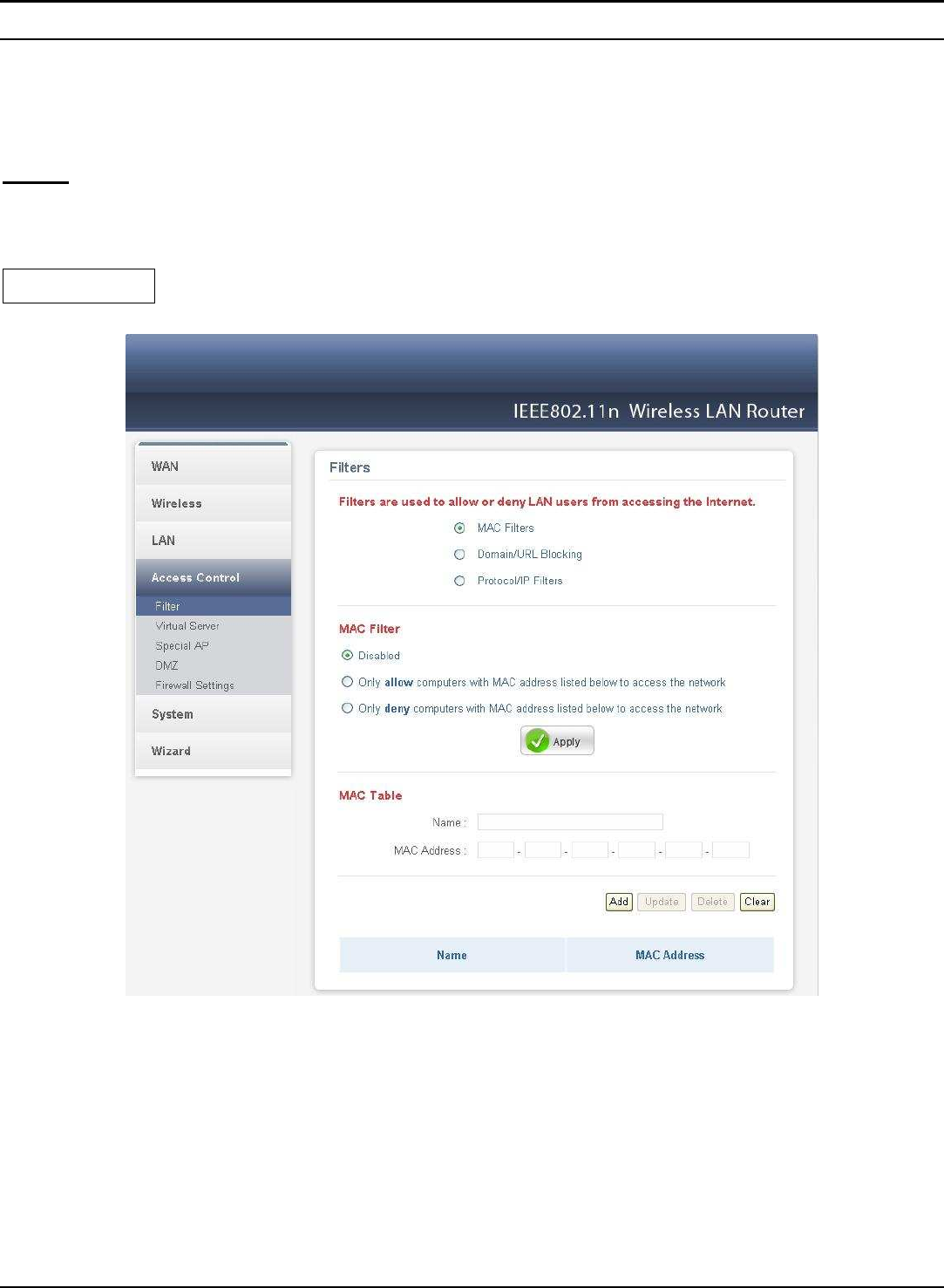
37
Access Control Setting
This access control enables you to define access restrictions, set up protocol and IP
filters, create virtual servers, define access for special applications such as games,
and set firewall rules.
Filter
Using filter to deny or allow the users to access. Five types of filters to select:
MAC, IP Filter, URL blocking, Domain blocking and Protocol filter.
MAC Filters
MAC Filter: Enables you to allow or deny Internet access to users within the LAN
based upon the MAC address of their network interface. Click the radio button next
to Disabled to disable the MAC filter.
Disable: Disable the MAC filter function.
Allow: Only allow computers with MAC address listed in the MAC Table.
Deny: Computers in the MAC Table are denied Internet access.
MAC Table: Use this section to create a user profile which Internet access is
denied or allowed. The user profiles are listed in the table at the bottom of the page.
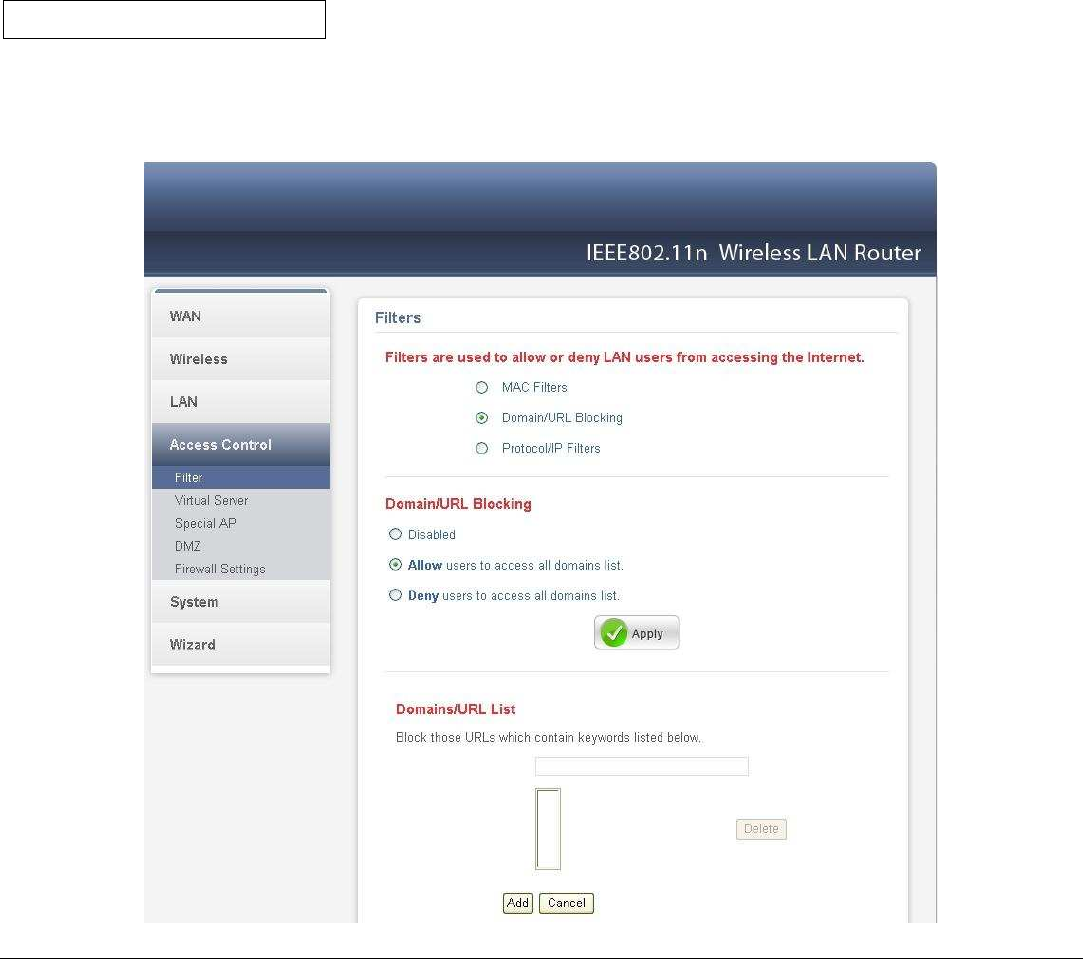
38
(Note: Click anywhere in the item. Once the line is selected, the fields
automatically load the item's parameters, which you can edit.)
Name: Type the name of the user to be permitted/denied access.
MAC Address: Type the MAC address of the user's network interface.
Add: Click to add the user to the list at the bottom of the page.
Update: Click to update information for the user, if you have changed any of the
fields.
Delete: Select a user from the table at the bottom of the list and click to remove the
user profile.
Clear: Click to erase all fields and enter new information.
The maximum number of MAC address that can be made in the Filters page is 25
entries. User can browse through the MAC address saved by selecting the MAC
Filter List.
Domain/ URL Blocking
You could enable Domain/URL blocking to deny the users from accessing the
specified Domain/URL. Add those specified Domain/URL in the text box.
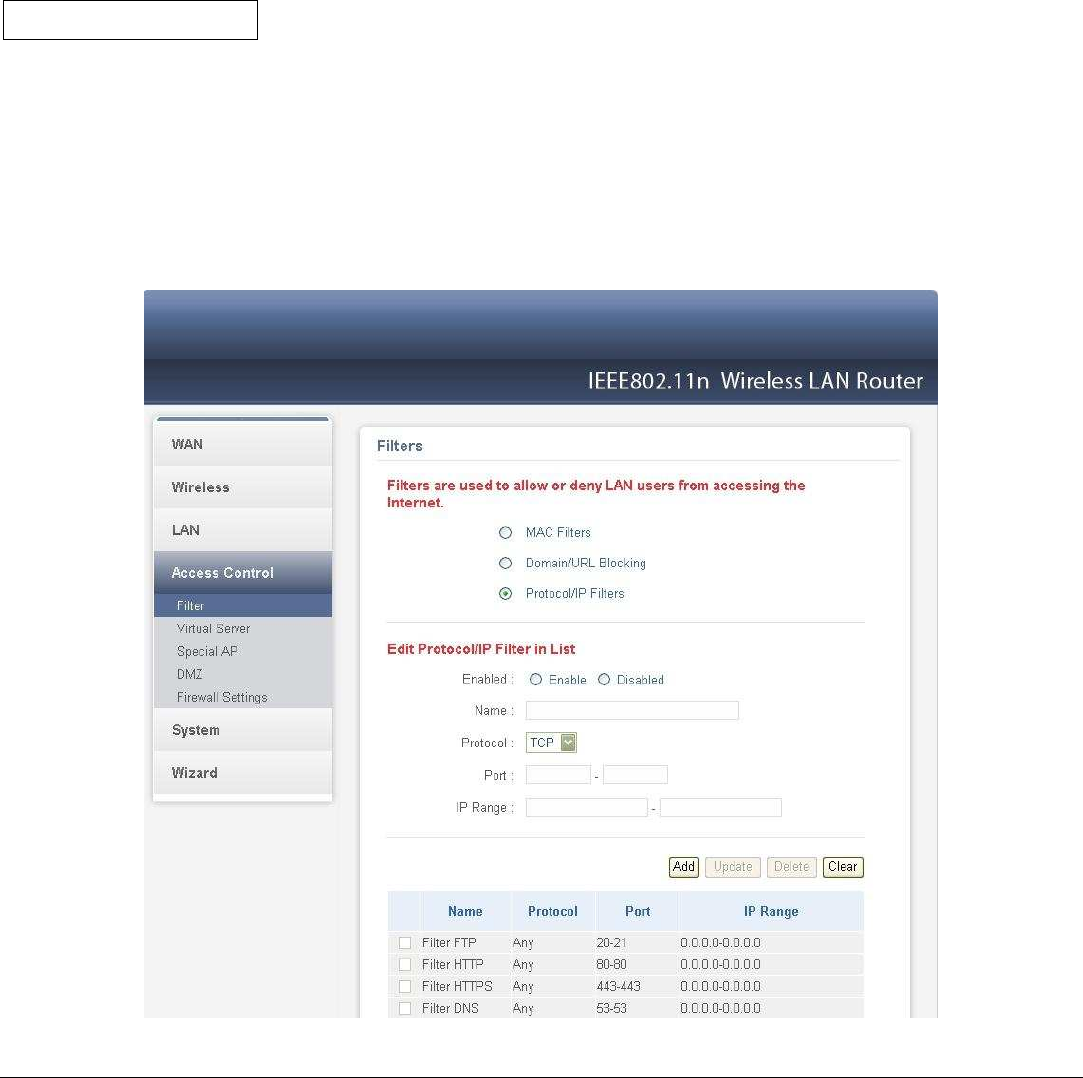
39
Disable: Disable the Domain/URL Blocking function.
Allow: Allow users to access all domains in the “Domains List”.
Deny: Deny users to access all domains in the “Domains List”.
Blocked/Permitted Domains/URL: List domains you will Blocked or Permitted.
Apply: Click to add domain to the Blocked/Permitted Domains/URL list.
Delete: Select a Domain/URL from the table at the bottom of the list and click
Delete to remove the Domain/URL.
Add: Click to Add button to add domain to the Domains list.
Cancel: Click the Cancel button to erase all fields and enter new information.
Protocol/IP Filters
This protocol filter enables you to allow and deny access based upon a
communications protocol list you create. The protocol filter profiles are listed in the
table at the bottom of the page.
Note: When selecting items in the table at the bottom, click anywhere in the item.
The line is selected, and the fields automatically load the item's parameters, which
you can edit.

40
Enable: Click to enable or disable the IP address filter.
Name: Type the name of the user to be denied access.
Protocol: Select a protocol (TCP or UDP) to use for the virtual server.
Port: Type the port range of the protocol.
IP Range: Type the IP range. IP addresses falling between this value and the
Range End are not allowed to access the Internet.
Add: Click to add the IP range to the table at the bottom of the screen.
Update: Click to update information for the range if you have selected a list item
and have made changes.
Delete: Select a list item and click Delete to remove the item from the list.
Clear: Click the Clear button to erase all fields and enter new information.
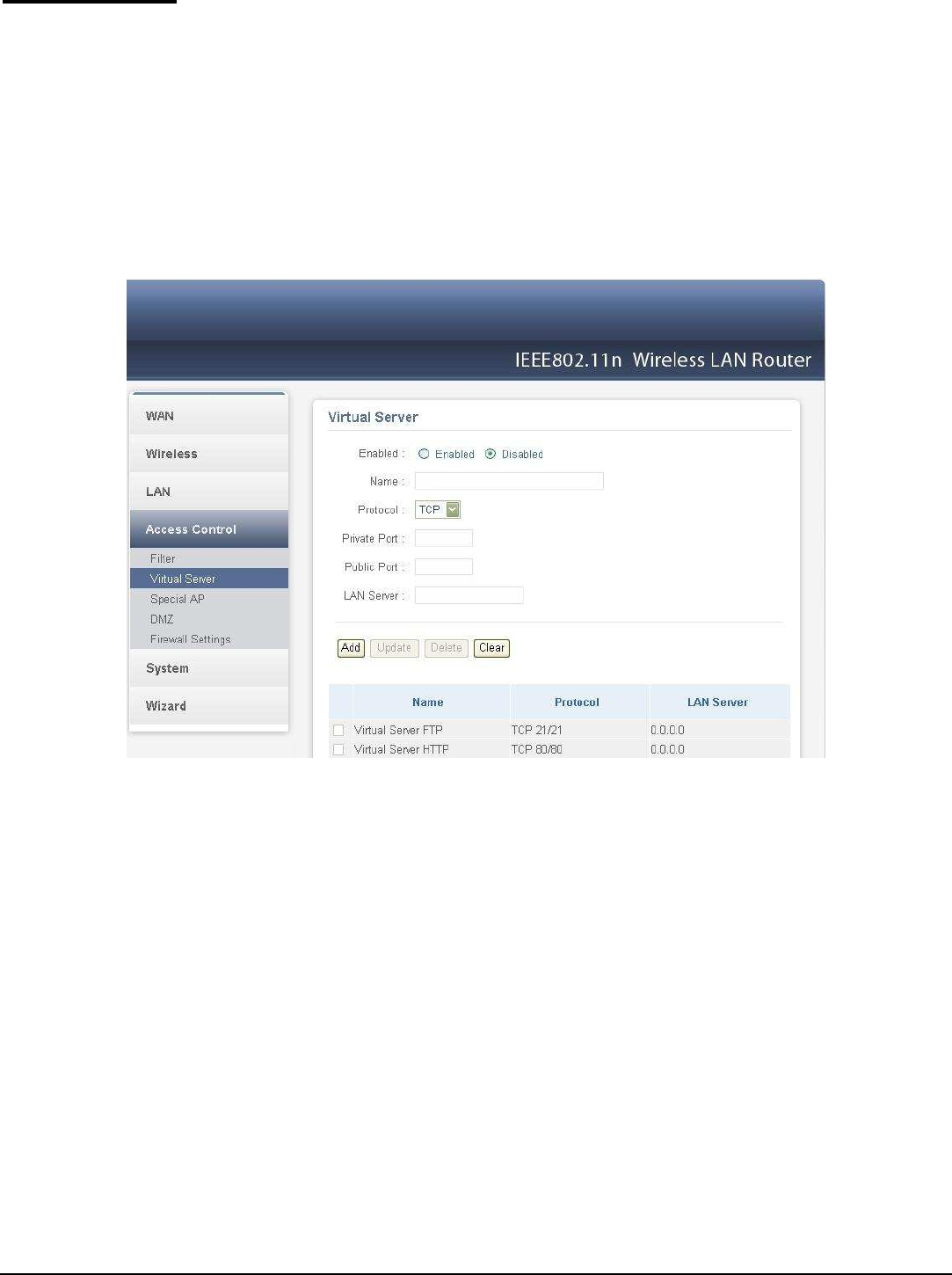
41
Virtual Server
This screen enables users to create a virtual server via the WLAN Router. If the
WLAN Router is set as a virtual server, remote users requesting Web or FTP
services through the WAN are directed to local servers in the LAN. The WLAN
Router redirects the request via the protocol and port numbers to the correct LAN
server. The Virtual Sever profiles are listed in the table at the bottom of the page.
Note: When selecting items in the table at the bottom, click anywhere in the item.
The line is selected, and the fields automatically load the item's parameters, which
user can edit.
Enable: Click to enable or disable the virtual server.
Name: Type a descriptive name for the virtual server.
Protocol: Select a protocol (TCP or UDP) to use for the virtual server.
Private Port: Type the port number of the computer on the LAN that is being used
to act as a virtual server.
Public Port: Type the port number on the WAN that will be used to provide access
to the virtual server.
LAN Server: Type the LAN IP address that will be assigned to the virtual server.
Add: Click to add the virtual server to the table at the bottom of the screen.
Update: Click to update information for the virtual server if the user has selected a
listed item and has made changes.
Delete: Select a listed item and click “Delete” to remove the item from the list.
Clear: Click the Clear button to erase all fields and enter new information.
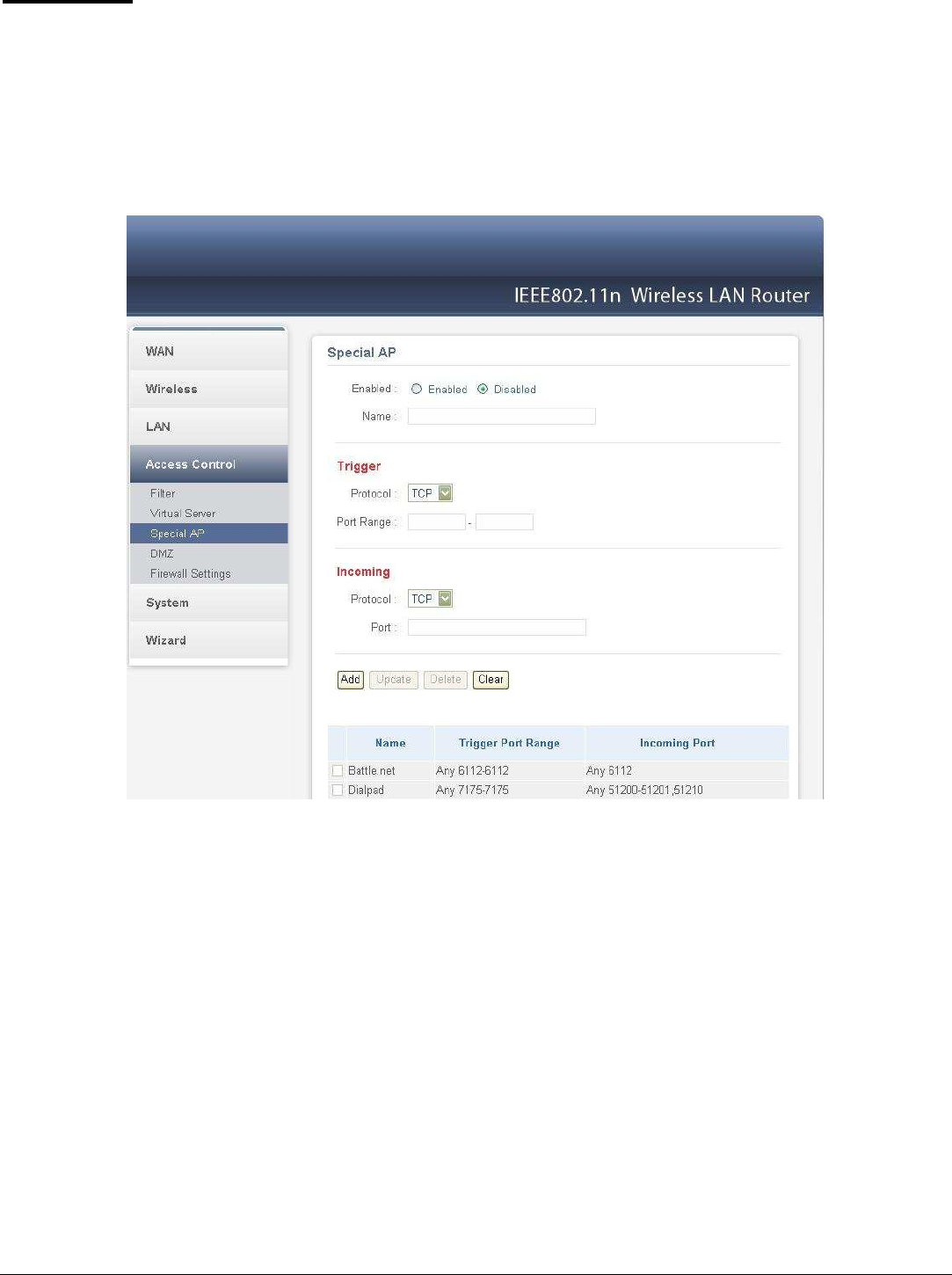
42
Special AP
This screen enables users to specify special applications, such as games which
require multiple connections that are blocked by NAT. The special applications
profiles are listed in the table at the bottom of the page.
Note: When selecting items in the table at the bottom, click anywhere in the item.
The line is selected, and the fields automatically load the item's parameters, which
user can edit.
Enable: Click to enable or disable the application profile. When enabled, users will
be able to connect to the application via the WLAN Router’s WAN connection.
Click “Disabled” on a profile to prevent users from accessing the application on the
WAN connection.
Name: Type a descriptive name for the application.
Trigger: Defines the outgoing communication that determines whether the user has
legitimate access to the application.
● Protocol: Select the protocol (TCP, UDP, or ICMP) that can be used to
access the application.
● Port Range: Type the port range that can be used to access the application
in the text boxes.
Incoming: Defines which incoming communications users are permitted to connect
with.

43
● Protocol: Select the protocol (TCP, UDP, or ICMP) that can be used by
the incoming communication.
● Port: Type the port number that can be used for the incoming
communication.
Add: Click to add the special application profile to the table at the bottom of the
screen.
Update: Click to update information for the special application if user have
selected a list item and have made changes.
Delete: Select a list item and click Delete to remove the item from the list.
Clear: Click the Clear button to erase all fields and enter new information.
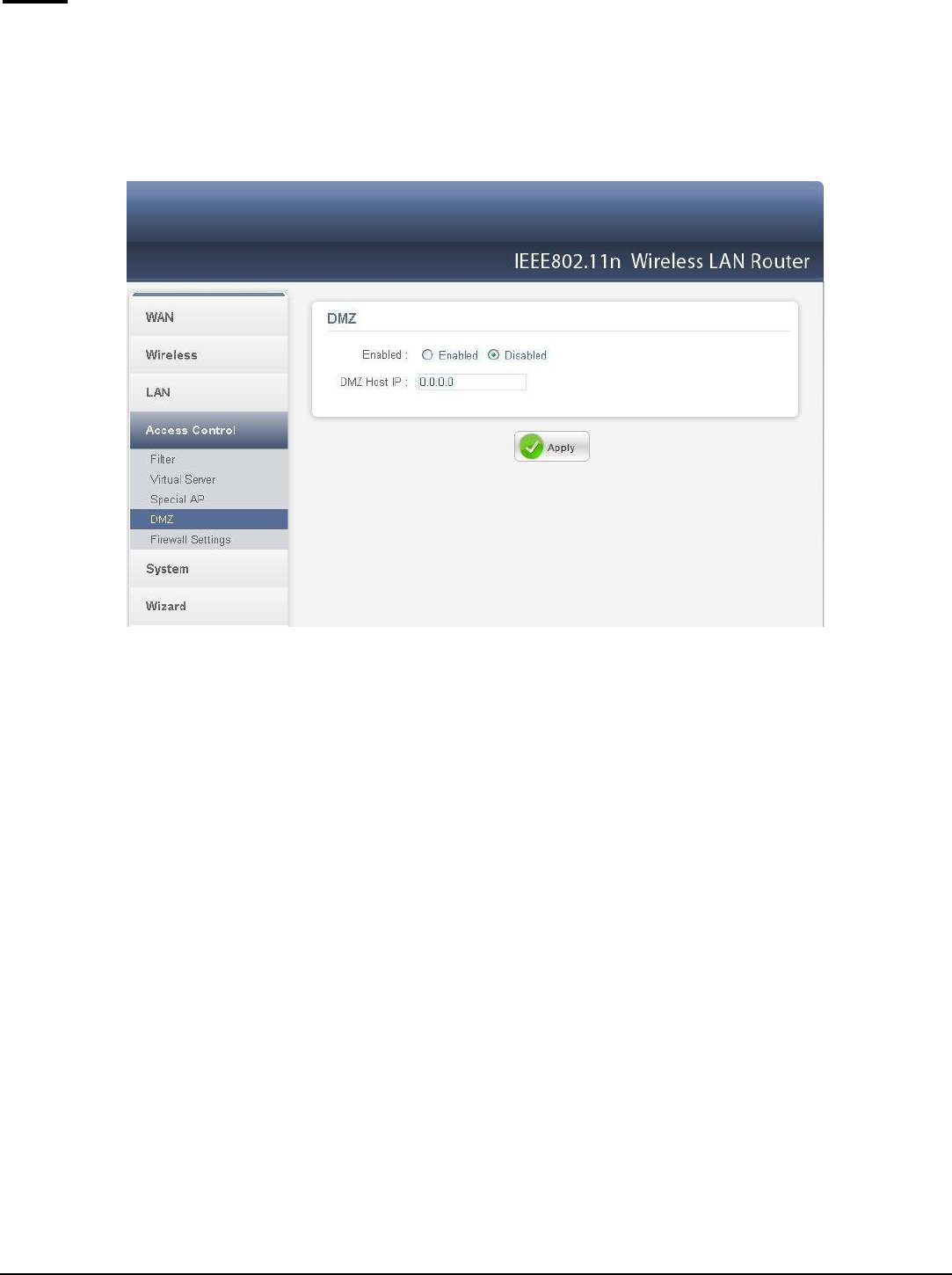
44
DMZ
This screen enables users to create a DMZ for those computers that cannot access
Internet applications properly through the WLAN Router and associated security
settings.
Note: Any clients added to the DMZ exposes the clients to security risks such as
viruses and unauthorized access.
Enable: Click to enable or disable the DMZ.
DMZ Host IP: Type a host IP address for the DMZ. The computer with this IP
address acts as a DMZ host with unlimited Internet access.
Apply: Click to save the settings.
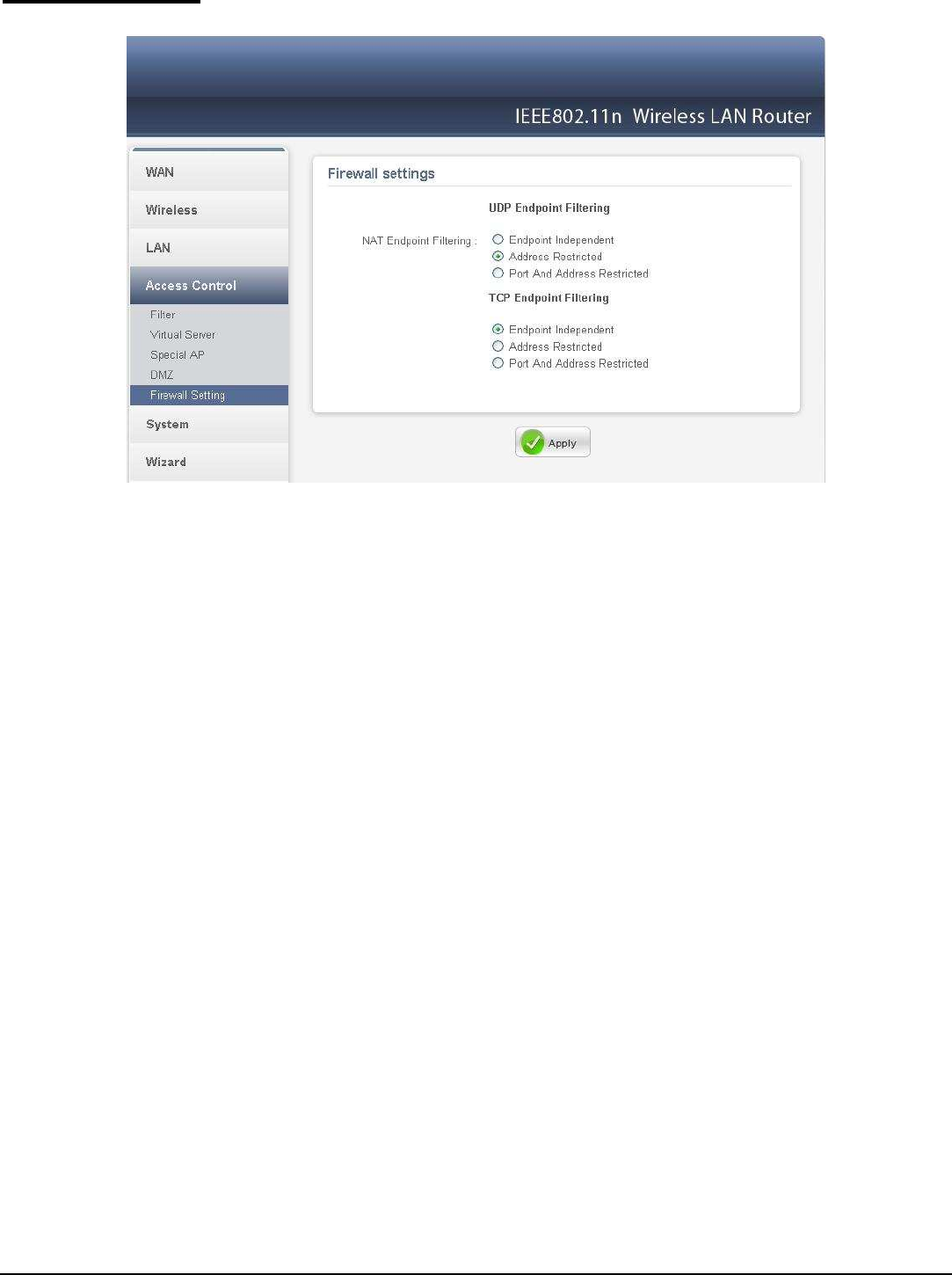
45
Firewall settings
A firewall protects your network from the outside world, this screen enables users
to setup the simple firewall function on the wireless router.
Endpoint Independent: Any incoming traffic sent to an open port will be
forwarded to the application that opened the port.
Address Restricted: Incoming traffic must match the IP address of the outgoing
connection.
Address And Port Restriction: Incoming traffic must match the IP address and
port of the outgoing connection
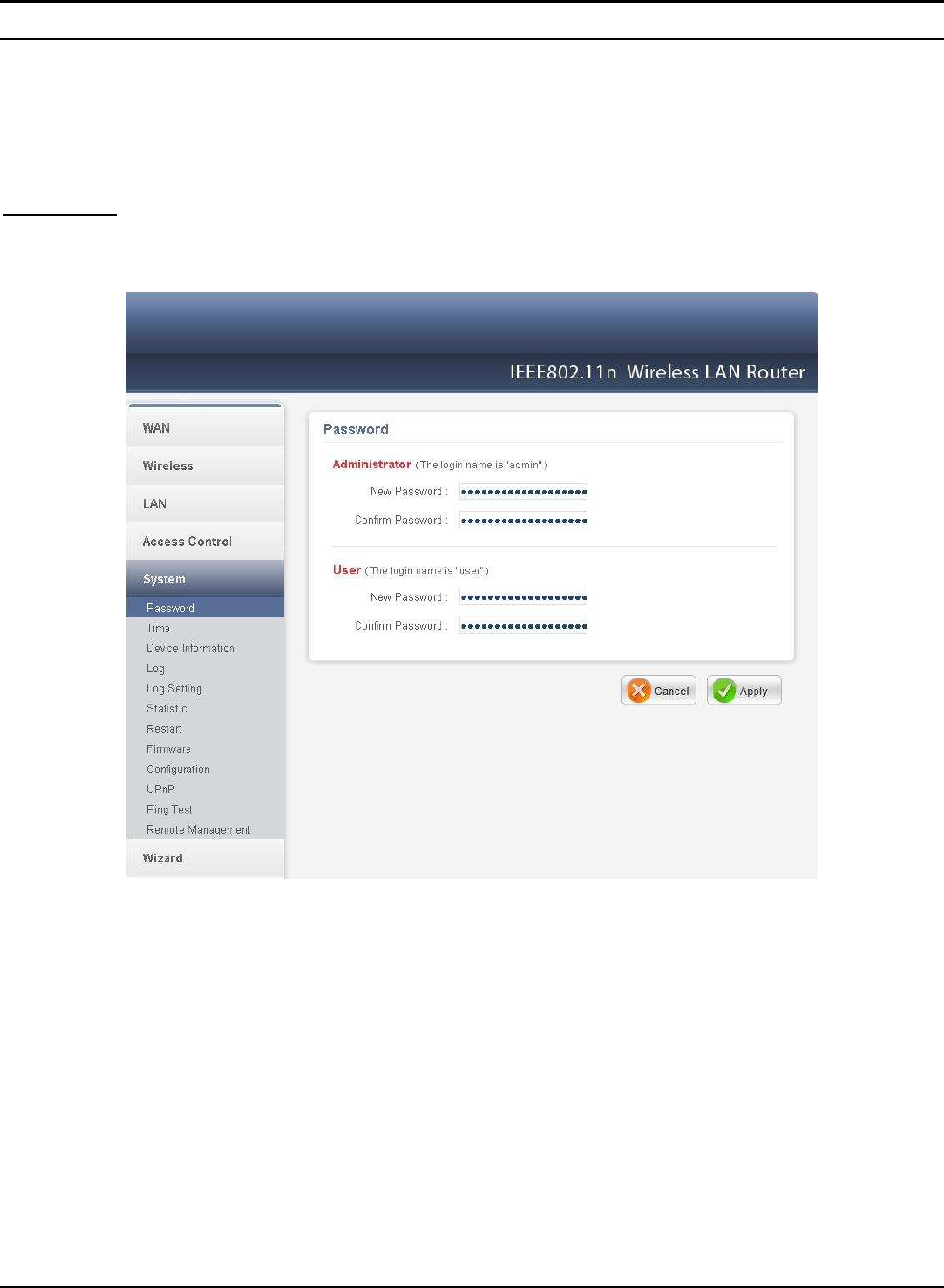
46
System Setting
This system setting enables users to change password, set the device time, view the
device information, restart the system, save and load different settings as profiles,
restore factory default settings, upgrade the firmware, and ping remote IP
addresses….etc.
Password
This function enables users to set administrative and user passwords. These
passwords are used to gain access to the WLAN Router interface.
Administrator: Type the password the Administrator will use to log into the
system. The password must be typed again for confirmation. The Administrator can
also authorize users the ability to configure the WLAN Router.
User: Type the password the User will use to log in to the system. The password
must be typed again for confirmation.
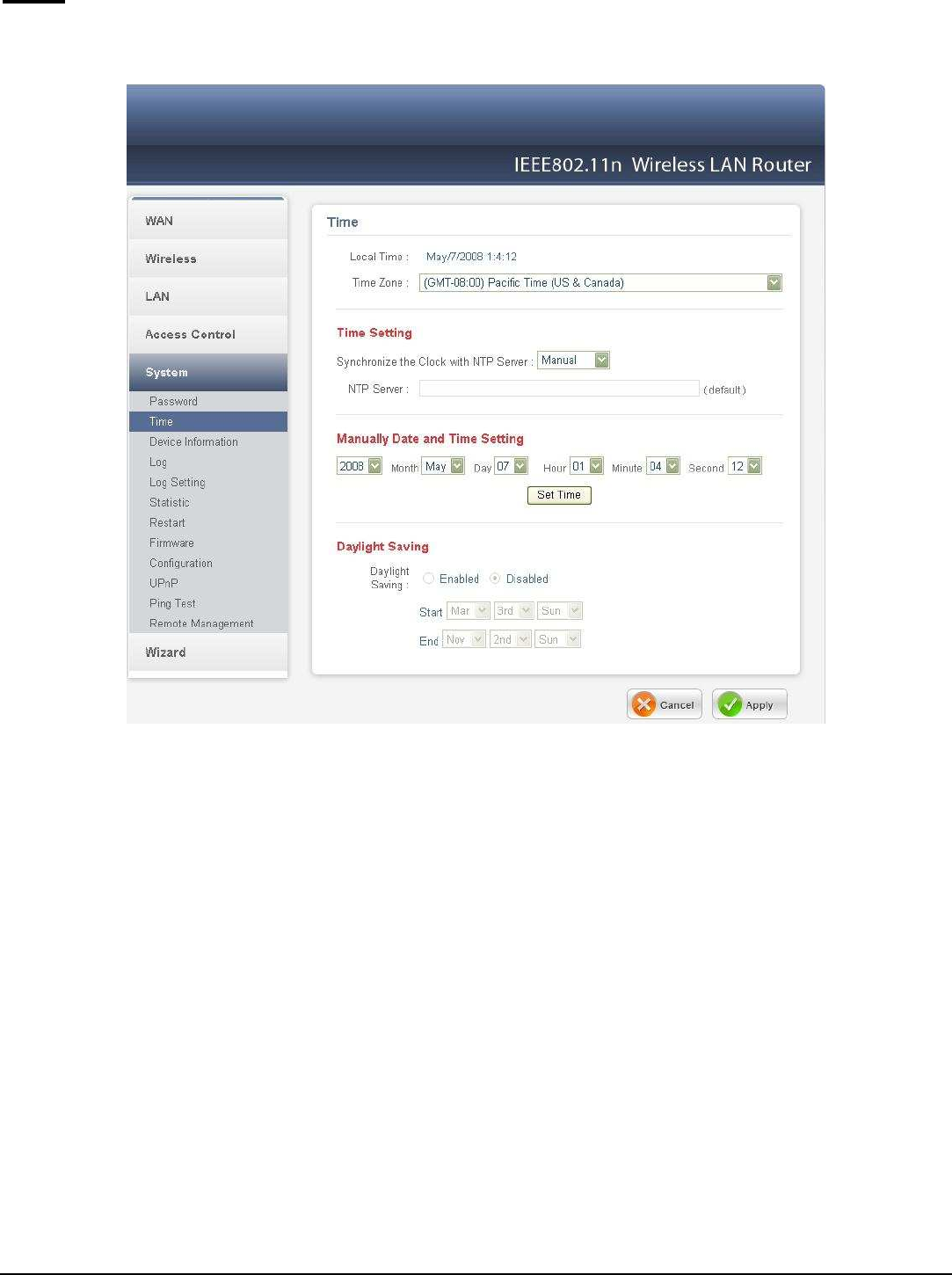
47
Time
This function enables users to set the time and date for the WLAN Router's real-
time clock, select properly time zone, and enable or disable daylight saving.
Local Time: Displays the local time and date.
Time Zone: Select the time zone from the drop-down list.
Synchronize the clock with NTP Server: Enable or disable the WLAN Router
automatically adjust the system time from NTP Server.
Automatic: Automatically adjust the system time from NTP Server.
Manual: Manually adjust the system time when you press the Set Time button.
NTP server: The Simple Network Time Protocol (SNTP) server allows the WLAN
Router to synchronize the system clock to the global Internet through the SNTP
Server. Specify the NTP domain name or IP address in the text box.
Manually Date and Time Setting: Manually setting the WLAN Router system
time, press the Set Time button to update the system time.
Daylight Saving: Enables users to enable or disable daylight saving time. When
enabled, select the start and end date for daylight saving time.
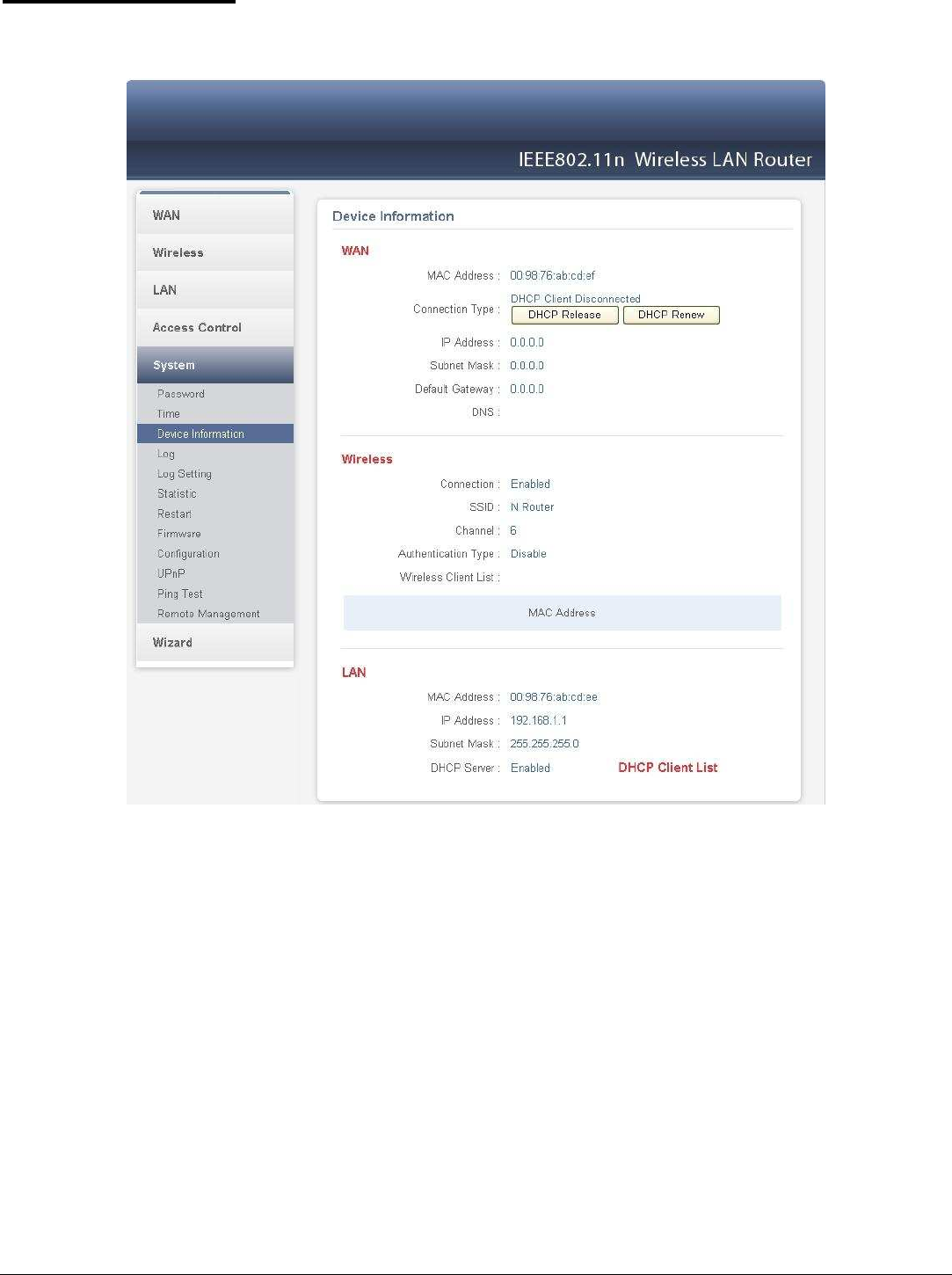
48
Device Information
This function enables users to view the WLAN Router’s WAN, Wireless, LAN and
System configurations.
WAN: This section displays the WAN interface configuration including the MAC
address, Connection status, DHCP client status, IP address, Subnet mask, Default
gateway, and DNS.
Wireless: This section displays the wireless configuration information, including
the MAC address, the Connection status, SSID, Channel and Authentication type.
LAN: This section displays the LAN interface configuration including the MAC
address, IP Address, Subnet Mask, and DHCP Server Status. Click “DHCP Table”
to view a list of client stations currently connected to the WLAN Router LAN
interface.
Click “DHCP Release” to release all IP addresses assigned to client stations
connected to the WAN via the WLAN Router. Click “DHCP Renew” to reassign
IP addresses to client stations connected to the WAN.
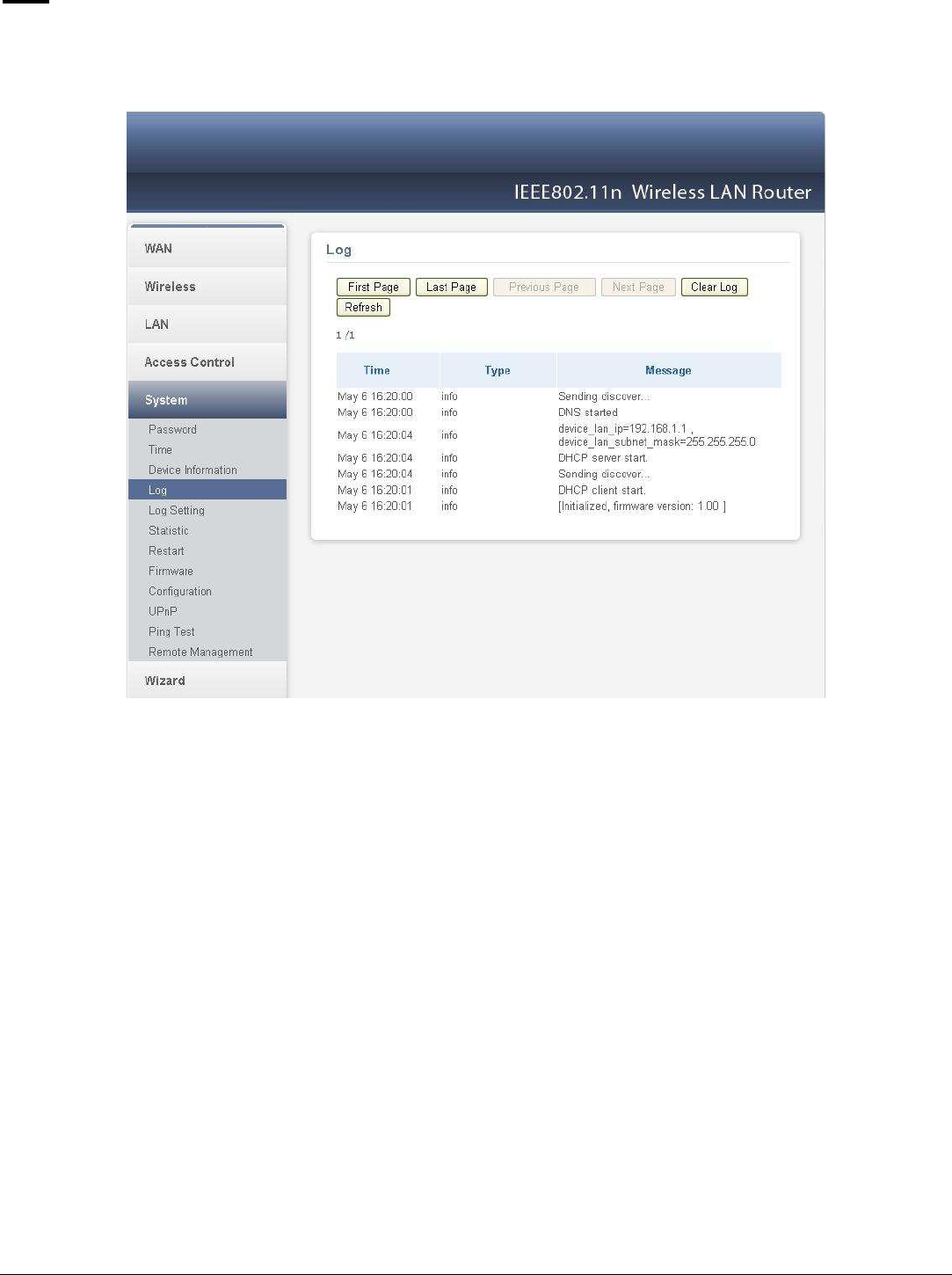
49
Log
This function enables users to view a running log of Router system statistics, events,
and activities. The log displays up to 200 entries. Older entries are overwritten by
new entries.
The Log screen commands are as follows:
Click “First Page” to view the first page of the log
Click “Last Page” to view the final page of the log
Click “Previous Page” to view the page just before the current page
Click “Next Page” to view the page just after the current page
Click “Clear Log” to delete the contents of the log and begin a new log
Click “Refresh” to renew log statistics
Time: Displays the time and date that the log entry was created.
Message: Displays summary information about the log entry.
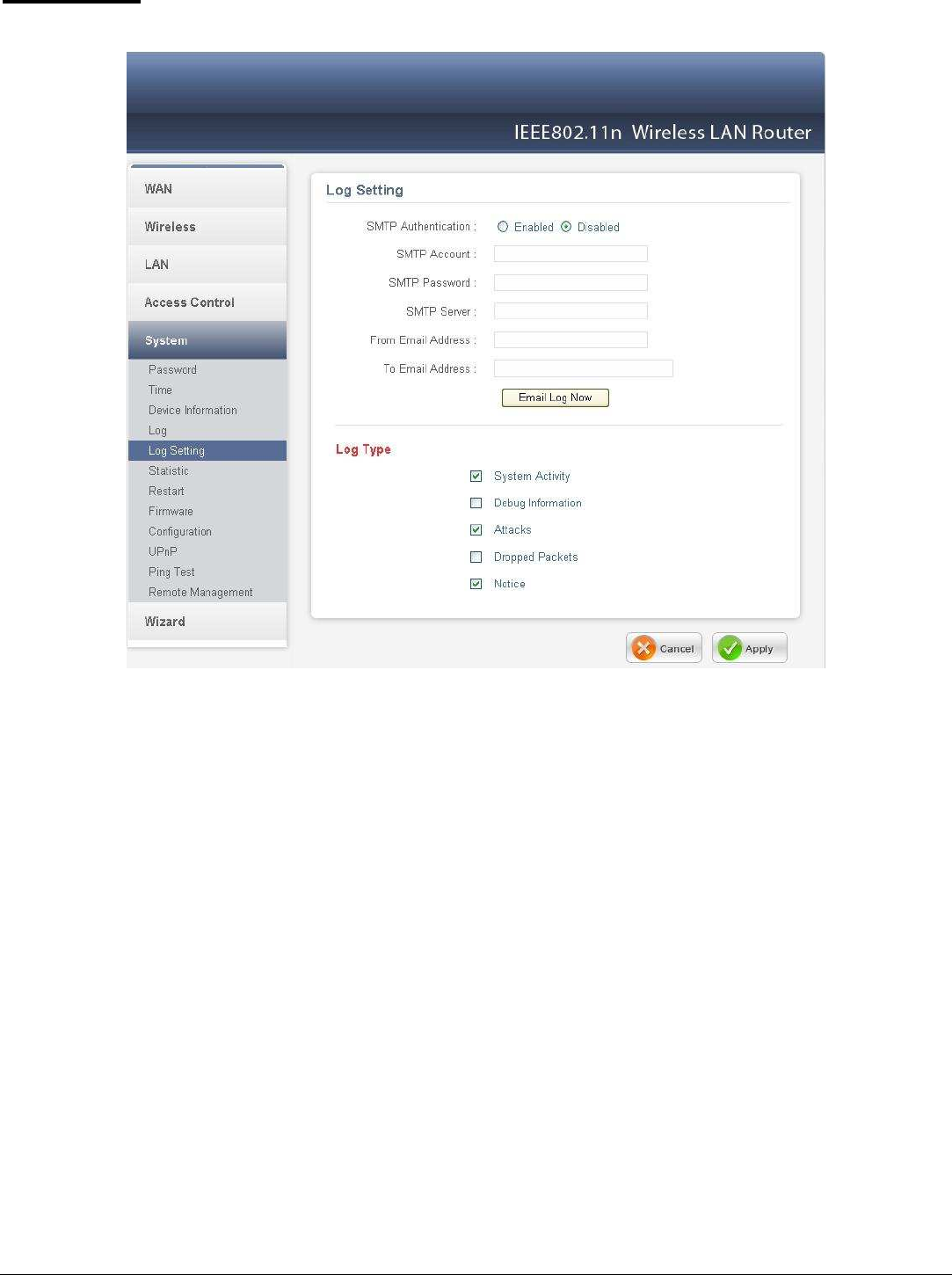
50
Log Setting
This function enables users to set Router Log parameters.
SMTP Authentication: Selected the Enabled if the SMTP server need for
authentication, fill in account name and password in SMTP Account field and
SMTP Password field.
SMTP Account: If the SMTP Authentication enabled, fill in the SMTP account
name here.
SMTP Password: If the SMTP Authentication enabled, fill in the password of the
SMTP account here.
SMTP Server: Type your SMTP server address here.
From/To Email Address: Type an email address for the log to be sent to. Click
“Email Log Now” to immediately send the current log.
Syslog Server: Type the IP address of the Syslog Server if user wants the WLAN
Router to listen and receive incoming Syslog messages.
Log Type: Enables users to select what items will be included in the log:
System Activity: Displays information related to WLAN Router operation.
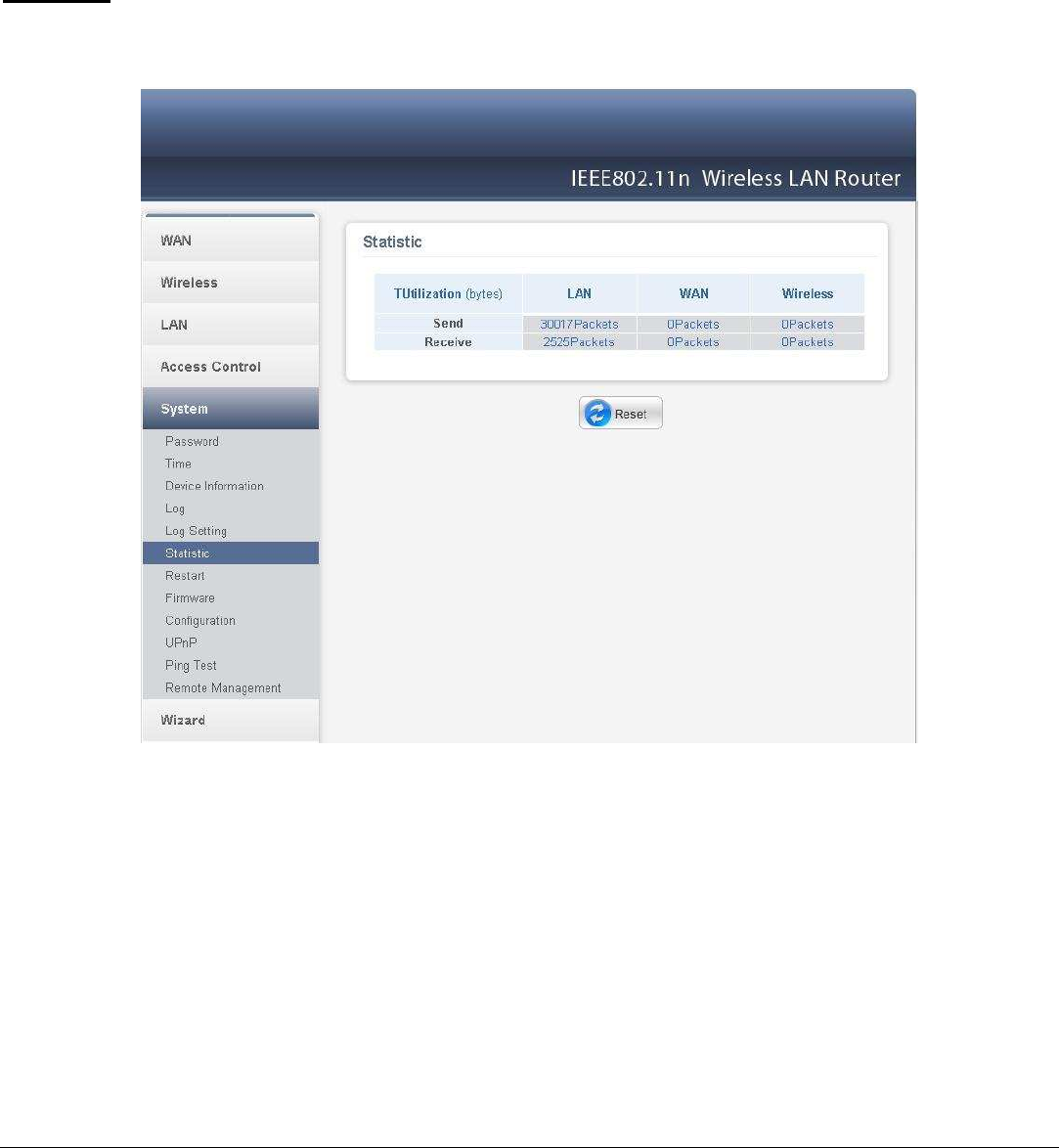
51
Debug Information: Displays information related to errors and system
malfunctions.
Attacks: Displays information about any malicious activity on the network.
Dropped Packets: Displays information about packets that have not been
transferred successfully.
Notice: Displays important notices by the system administrator.
Statistic
This function displays a table that shows the rate of packet transmission via the
WLAN Router’s LAN, WAN and Wireless ports (in bytes per second).
Click “Reset” to erase all statistics and begin logging statistics again.
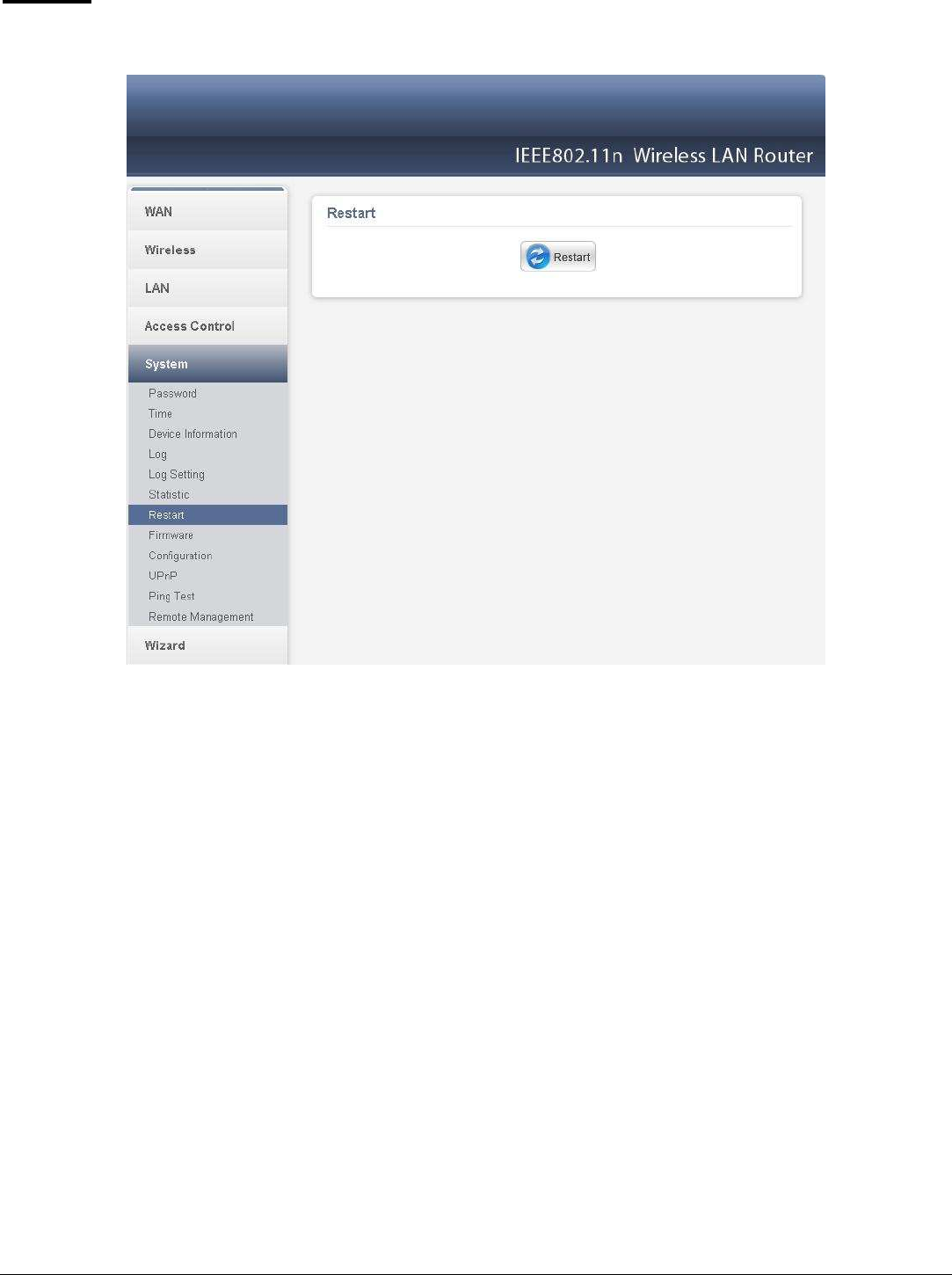
52
Restart
Click “Restart” to restart the system in the event the system is not performing
correctly.
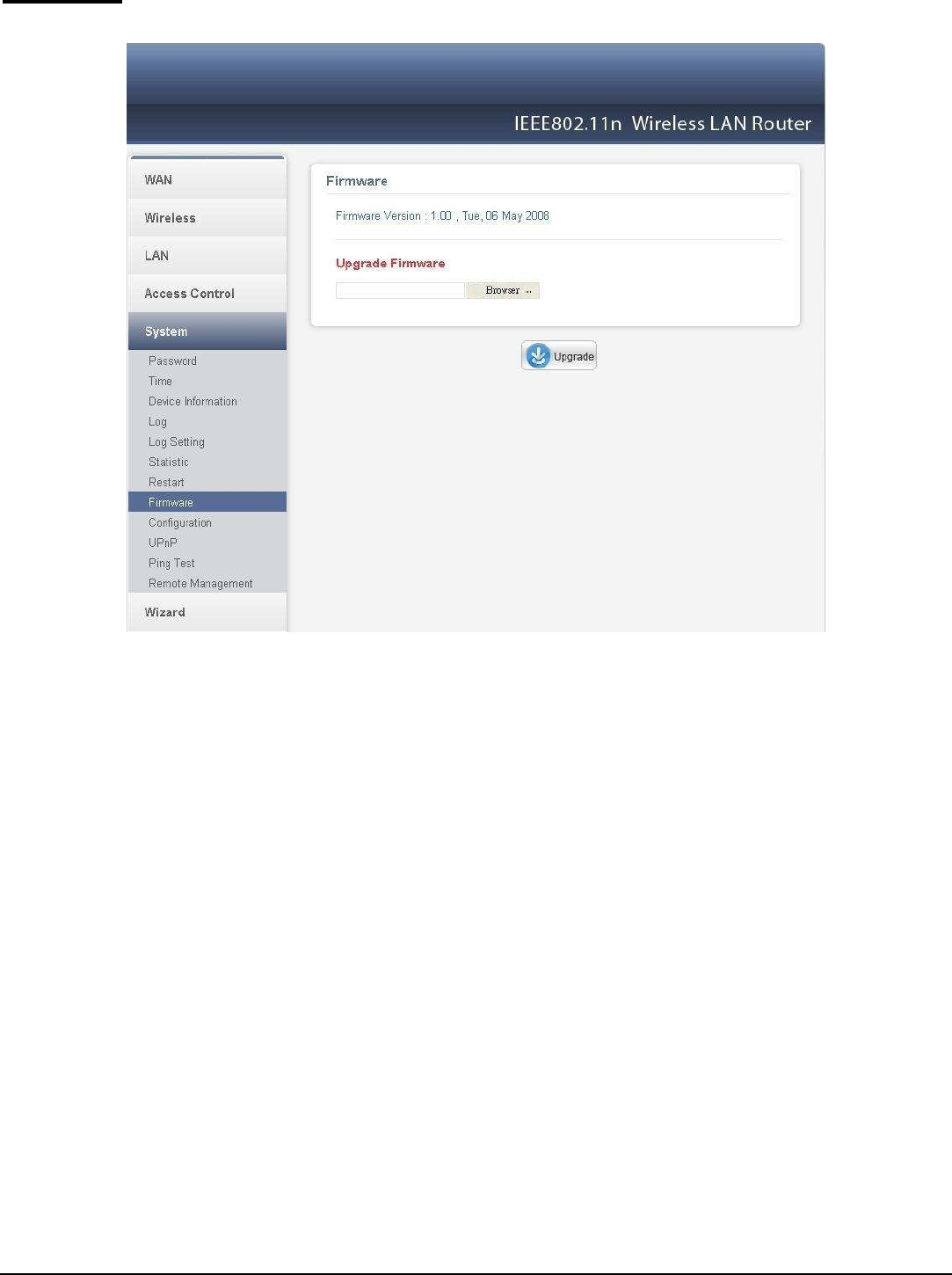
53
Firmware
This function enables users to keep the WLAN Router firmware up to date.
Please follow the below instructions:
Download the latest firmware from the manufacturer's Web site, and save it to disk.
Click “Browse” and go to the location of the downloaded firmware file.
Select the file and click “Upgrade” to update the firmware to the latest release.
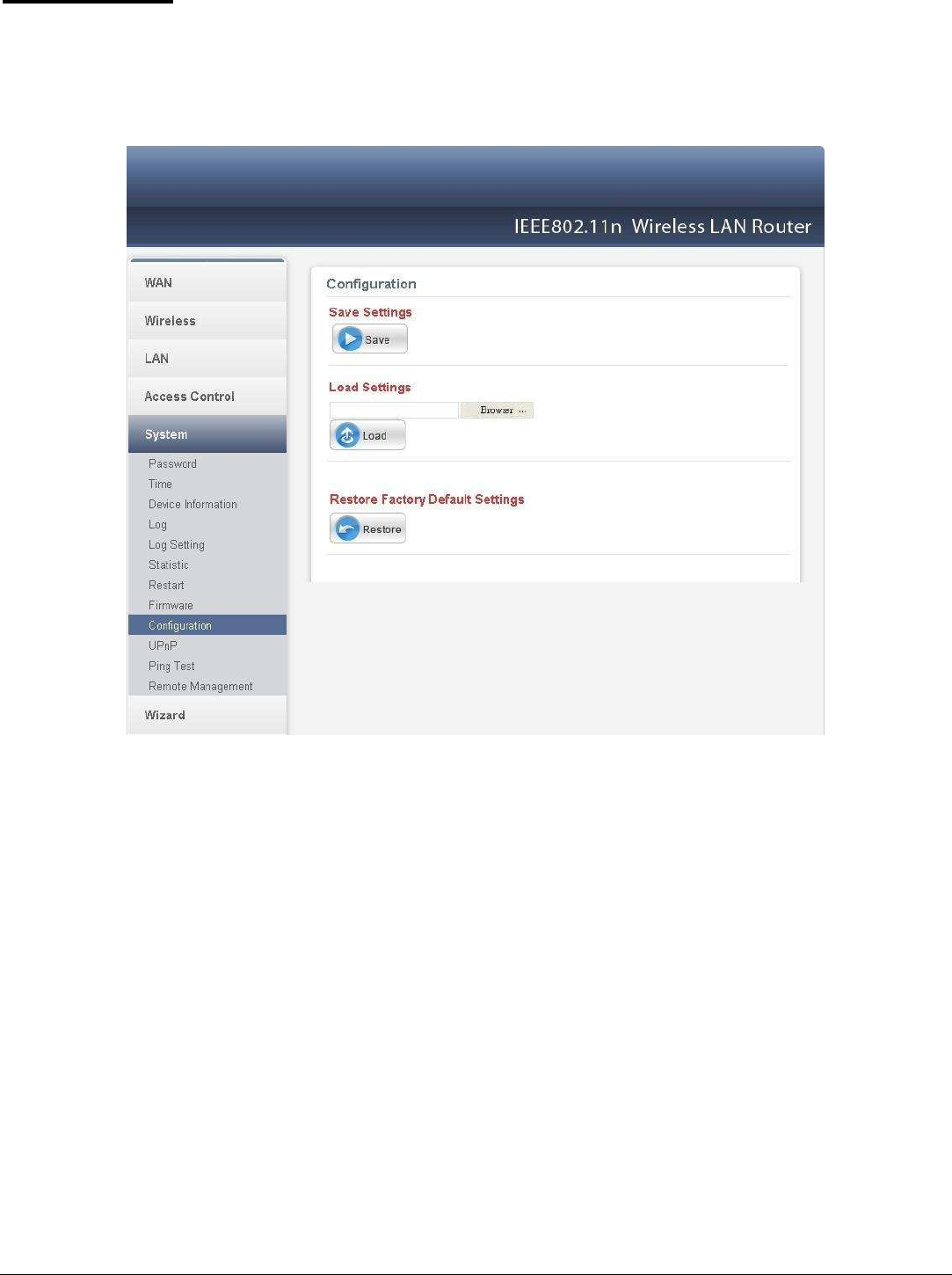
54
Configuration
This function enables users to save settings as a profile and load profiles for
different circumstances. User can also load the factory default settings, and run a
setup wizard to configure the WLAN Router and Router interface.
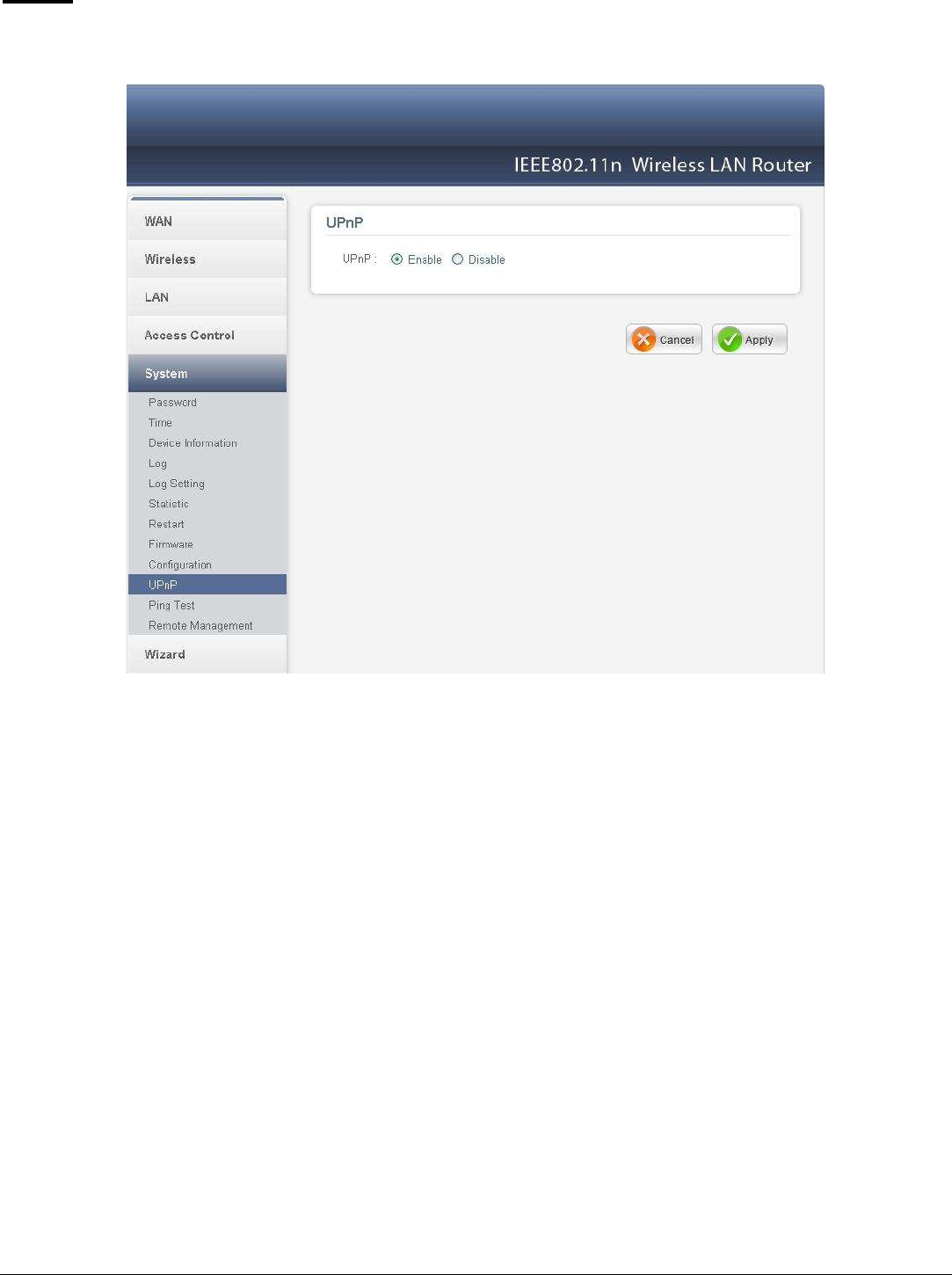
55
UPnP
This function enables users to enable or disable the UPnP function on the WLAN
Router.
UPnP: Select to enable or disable the UPnP function on the WLAN Router. UPnP
is short for Universal Plug and Play that is a networking architecture that provides
compatibility among networking equipment, software, and peripherals. The WLAN
Router is an UPnP-enabled Router and will only work with other UPnP
devices/software. If user does not want to use the UPnP functionality, select
“Disabled” to disable it.
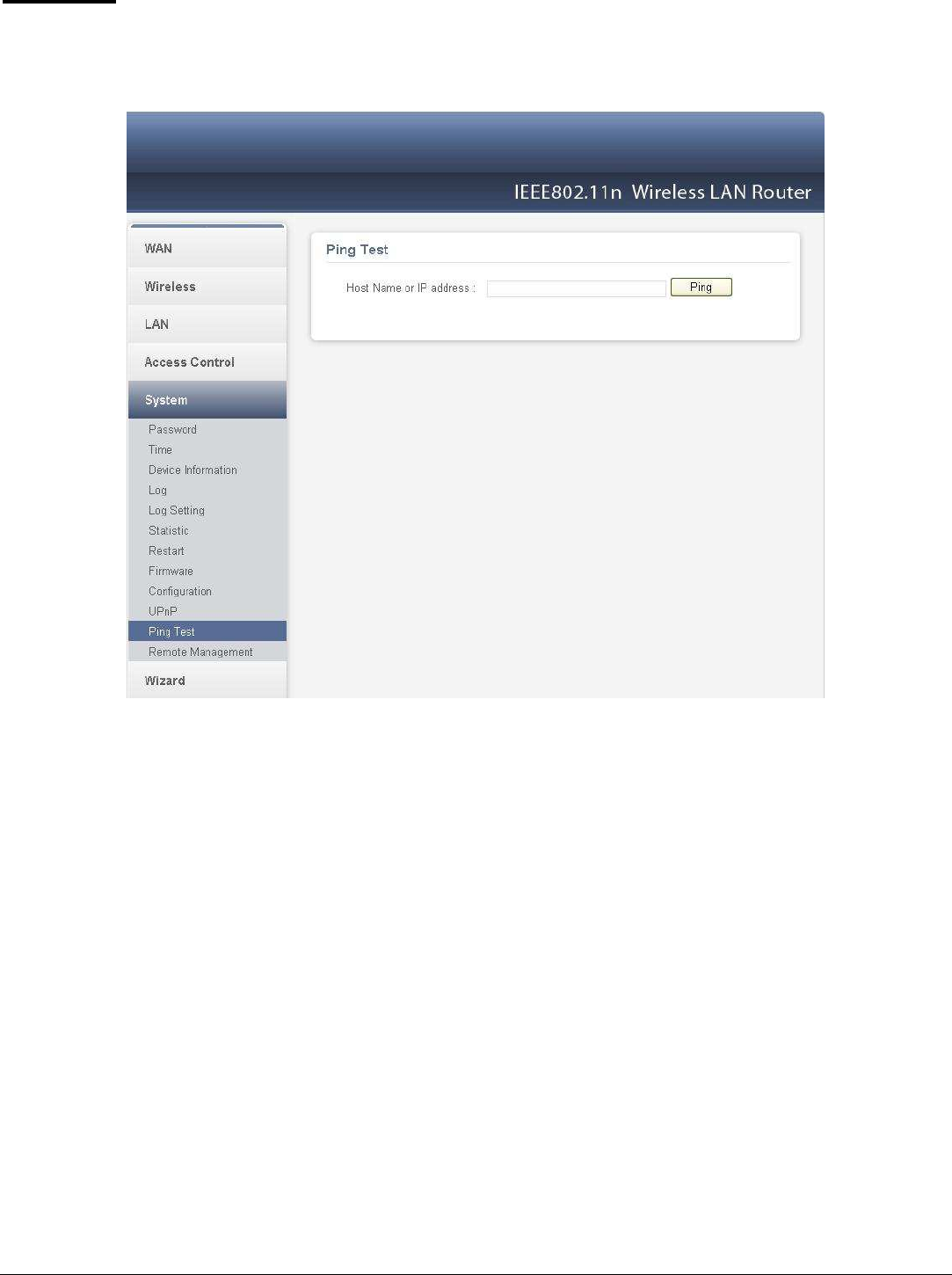
56
Ping Test
The ping test enables users to determine whether an IP address or host is present on
the Internet. Type the host name or IP address in the text box and click Ping button
to start the Ping test.
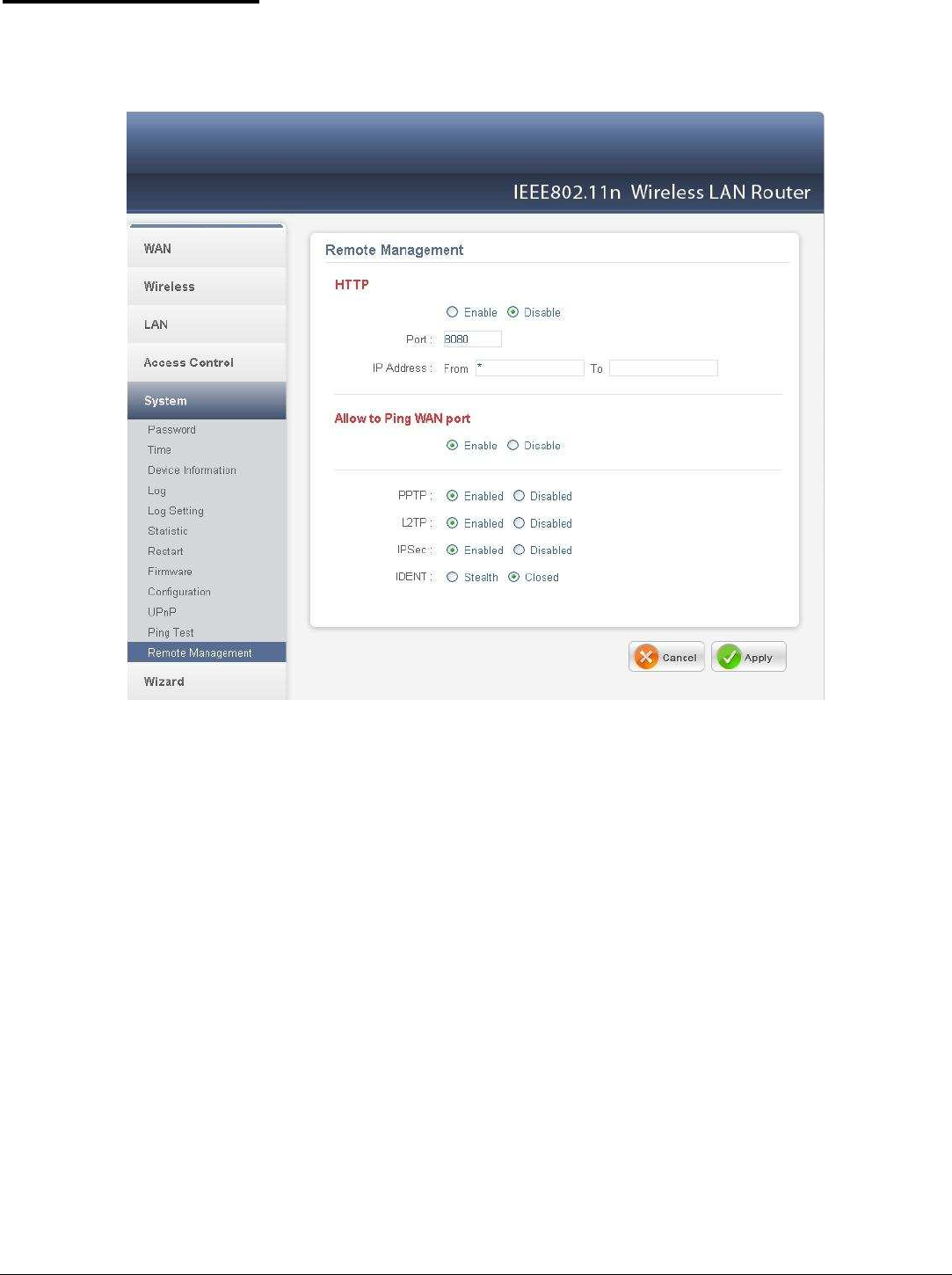
57
Remote Management
This function enables users to set up remote management. Using remote
management, the WLAN Router can be configured through the WAN via a Web
browser. A user name and password are required to perform remote management.
HTTP: Enables users to set up HTTP access for port number, and Remote IP
Range for remote management.
IP Address: Remote IP Range, to type a range of Router IP addresses that can be
pinged from remote locations
Allow to Ping WAN Port: Enables users to allow to ping WAN Port.
PPTP: Enables users to set up PPTP access for remote management.
L2TP: Enables users to set up L2TP access for remote management.
IPSec: Enables users to set up IPSec access for remote management.
IDENT: Default is stealth. This enables users to set port 113 stealth.
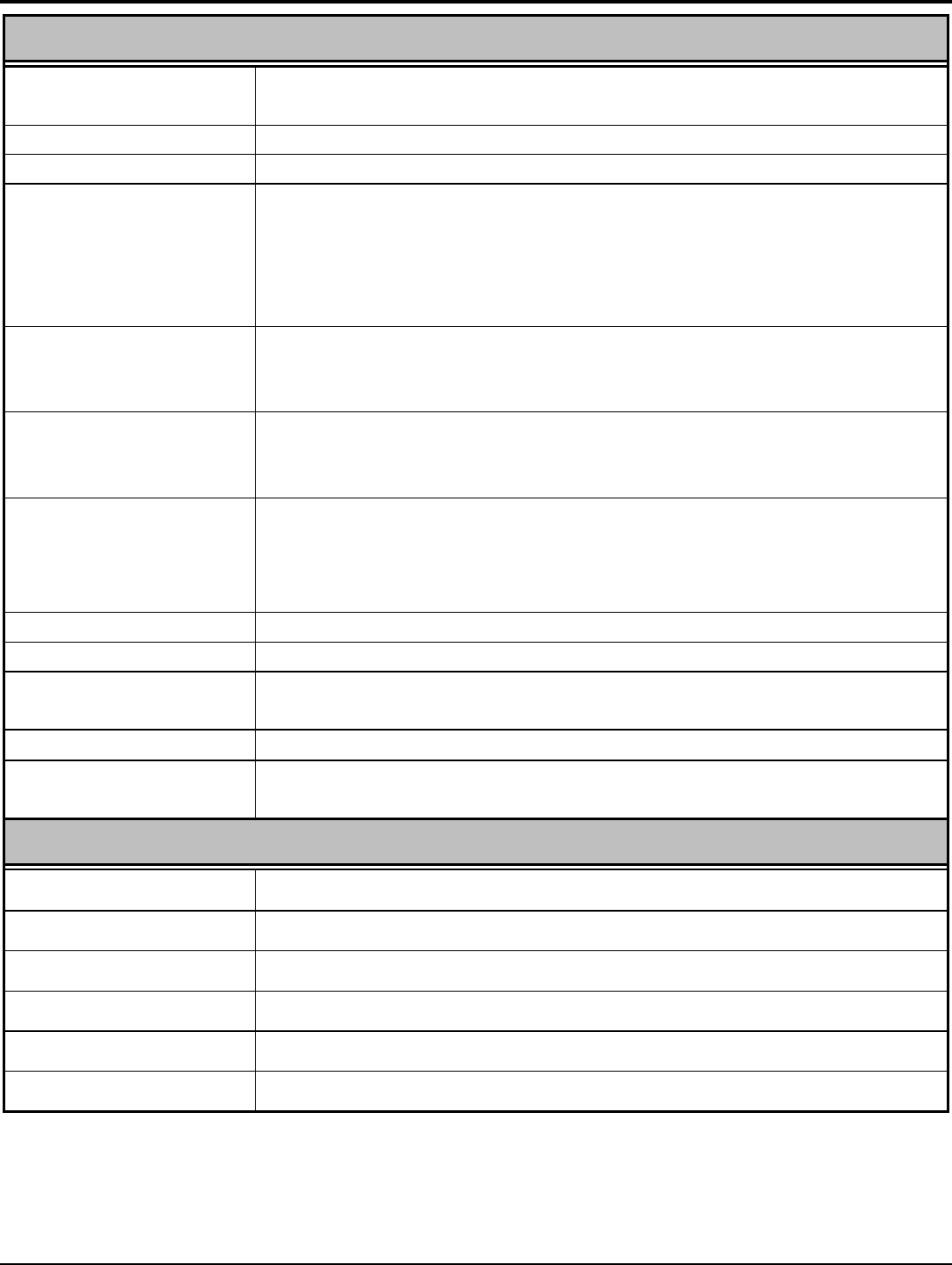
58
TECHNICAL SPECIFICATIONS
General
Standards IEEE 802.3u 100BASE-TX Fast Ethernet
IEEE 802.11n 2.0; IEEE 802.11g; IEEE 802.11b
Protocol CSMA/CA with ACK
Radio Technology DSSS/OFDM
Data Transfer Rate 802.11n mode: up to 150Mbps (auto sense)
802.11g mode: up to 54Mbps (auto sense)
802.11b mode: up to 11Mbps (auto sense)
Ethernet: 10Mbps (half duplex), 20Mbps (full-duplex)
Fast Ethernet: 100Mbps (half duplex), 200Mbps (full- duplex)
Receiver Sensitivity 802.11n: -62dBm typical @ 300Mbps
802.11g: -68dBm typical @ 54Mbps
802.11b: -85dBm typical @ 11Mbps
TX Power 802.11b 15dBm (average power)
802.11g 17dBm (average power)
802.11n 18dBm (average power)
Network Cables 10BASE-T: 2-pair UTP Cat. 3,4,5 (100 m), EIA/TIA- 568 100-
ohm STP (100 m)
100BASE-TX: 2-pair UTP Cat. 5 (100 m), EIA/TIA-568 100-
ohm STP (100 m)
Frequency Range 2412 ~ 2484 MHz ISM band
Modulation Schemes
DBPSK/DQPSK/CCK/OFDM
Security 64/128-bits WEP Encryption; WPA, WPA-PSK, WPA2,
WPA2-PSK
Channels 1~11 Channels (US/NCC) 1~13 Channels (EU)
Number of Ports LAN: 4 x 10/100Mbps Auto-MDIX Fast Ethernet port
WAN: 1 x 10/100Mbps Auto-MDIX Fast Ethernet port
Physical and Environmental
DC inputs 5VDC/1A
Power Consumption 3.0W (Max)
Temperature Operating: 0
o
C ~ 40
o
C, Storage: -10
o
~ 70
o
C
Humidity Operating: 10% ~ 90%, Storage: 5% ~ 90%
Dimensions 147 x 115 x 35 mm (W x D x H) without Antenna
EMI: FCC Class B, CE Mark B